A Blog About Parenting: Coping Skills, Behavior Management and Special Needs


25 Fun Problem Solving Activities for Kids
Problem-solving activities for kids : Explore 24 fun problem-solving games and activities, and learn effective tips and strategies to teach kids problem-solving skills. If you want to explore problem-solving strategies more in-depth, you can also grab our workbook “ Problem-Solving for Kids ” (printable resource).
Problem-solving is the cognitive process of finding solutions to challenges or complex situations.
A systematic approach to problem-solving tends to include defining the problem, gathering information and data, generating potential solutions, evaluating the pros and cons of each solution, making a decision, and implementing the chosen solution.
Effective problem-solving often requires critical thinking, a good dose of creativity, and the ability to consider multiple perspectives. It may also involve identifying patterns, breaking down a problem into manageable chunks, and applying our logic to develop solutions.
Problem-solving is present in everyday situations and across all fields: business, science, personal life, and education. There is not one single aspect in our lives where we don’t need to apply our problem-solving skills.
Table of Contents
- Problem-solving steps
- Development of problem-solving in childhood
- Benefits of developing problem-solving skills
- 10 Tips to teach kids problem-solving skills
- 10 Examples of problem-solving strategies
- 25 Problem-solving activities and games for kids
Problem-Solving Steps
Some key components of problem-solving include:

- Identifying the problem Recognizing and defining the issue or challenge that needs to be addressed.
- Analyzing the problem Investigating and understanding the underlying causes, factors, and relationships related to the problem.
- Generating solutions Generating potential solutions or strategies to address the problem.
- Evaluating all possible solutions (Pros and Cons Analysis) Assessing the feasibility, effectiveness, and potential consequences of each solution. Considering the positive and negative aspects of each solution.
- Decision-making Selecting the best solution based on our analysis and judgment.
- Implementing the best solution Actioning our chosen solution
- Monitoring progress and results
- Reflecting on the outcomes Reviewing and evaluating the outcomes of the implemented solution, learning from the experience, and making adjustments if necessary.
Development of Problem-Solving Skills in Childhood
Children begin to develop problem-solving skills from a very early age, and these skills continue to develop and refine throughout childhood and adolescence.
Babies soon learn about action and reaction. And, as early as eight months, they begin to acquire an understanding of cause and effect (they shake a rattle, it makes a sound; they push a toy, it falls)
Between 13 and 24 months, they start solving simple problems through trial and error and engage in symbolic play using their imagination.
As children progress into middle childhood (ages 7-11), they develop more advanced problem-solving skills. They become capable of understanding multiple perspectives and can consider multiple factors when solving problems. They start using logic and reasoning to solve increasingly complex problems.
During adolescence (ages 12 and up), problem-solving skills continue to develop. Teenagers can generate and test hypotheses and use deductive and inductive reasoning to arrive at solutions.
Each child will develop their problem-solving skills at their own pace. Some children may show advanced problem-solving abilities at an earlier age. Others may require more time and experience to develop these skills fully.
Benefits of Developing Problem-Solving Skills in Children
Problem-solving skills in children are crucial for children’s cognitive, social, and emotional development. It equips them to approach challenges, think critically, make informed decisions, and find creative solutions.
The benefits of good problem-solving skills in children include:
- Positive impact on self-esteem and confidence Identifying, analyzing, and solving their problems contributes to our kids’ sense of competence .
- Fosters Independence and Autonomy When our kids are able to problem-solve on their own, they take one more step toward independence
- Academic Success Problem-solving skills contribute to academic achievement, as they help students analyze and solve complex problems across various subjects.
- Cognitive Development Problem-solving fosters cognitive skills such as logical reasoning, analytical thinking, and abstract reasoning.
- Critical Thinking Problem-solving enhances critical thinking abilities, enabling children to evaluate information, identify biases, and make informed judgments.
- Creativity Problem-solving promotes creativity by encouraging children to think outside the box, generate innovative ideas, and explore multiple solutions.
- Emotional Resilience Problem-solving skills enhance emotional resilience by enabling children to manage and cope with challenges effectively, reducing stress and promoting well-being.
- Improved Social Interactions/Relationships Problem-solving abilities contribute to better social interactions, conflict resolution , and peer collaboration, promoting healthy relationships.
- Future career success Problem-solving skills are highly valued in the workplace and can positively influence future career success.
10+ Helpful Tips to Teach Kids Problem-Solving Skills
Teaching problem-solving skills to kids is an important part of their cognitive development. It helps them develop critical thinking, creativity, and resilience.
But how can we help our kids and students to develop this essential skill?
We can help our kids and students develop and improve their problem-solving skills in many ways. These are some helpful tips that you could consider:
- Model problem-solving behavior When you see yourself in a problem-solving situation, verbalize your thought process: “I wonder how I should address this issue. I guess my alternatives could be… They all have positives and negatives….”
- Let them participate in the problem-solving situation “Could you help me solve this puzzle?”
- Provide real-life problem-solving situations Real-life scenarios make problem-solving more meaningful for kids. For example, discuss how to resolve a conflict with a sibling or how to make the morning routine smoother.
- Teach them how to break down problems Show them how to break down complex problems into manageable sub-problems.
- Practice brainstorming Create brainstorming situations where all the family (or the classroom) can contribute to solving a problem
- Teach the value of perseverance Sometimes, we must stick to a situation and persevere before finding a solution. Encourage kids to persevere through challenges and setbacks, emphasizing that mistakes and failures are opportunities for learning.
- Encourage critical thinking Encourage kids to analyze situations, consider different perspectives, and evaluate possible outcomes.
- How could we make your school lunch healthier but still yummy?
- How could we reuse/recycle all this paper?
- What could we do to help you remember all the steps in your night routine?
- Encourage reflection When they can find a solution for a problem, don’t jump to solve it for them. Encourage them to reflect on the problem and find and evaluate alternatives. And after a problem is solved, think about the whole process and the learnings. “How did this work?” “What did you learn” “Do you need to change anything?”
- Foster creativity Provide them with opportunities for imaginative play, creative projects, and brainstorming sessions.
- Teach the value of teamwork Teach kids the importance of working together to solve problems. Engage them in group activities or projects that require teamwork and collaboration. This helps kids learn the value of different perspectives and work together towards an objective while they practice their communication skills.
- Teach decision-making skills Teach kids how to approach problems systematically by going through the steps we have mentioned in our first section.
- Encourage both structured and free play. Structured play can help you create good problem-solving situations, while free play will foster creativity.
Developing problem-solving skills is an ongoing process that will also continue in adulthood. Provide your kids with guidance and support, and celebrate their efforts and achievements along the way.

10 Examples of Problem-Solving Strategies
There are different strategies that can help us solve a wide range of problems. Here are some commonly recognized problem-solving strategies:
1 . Trial and Error : This is the first problem strategy that we ever learn. We start using trial and error strategies in infancy, and it continues serving its purpose in many situations. This strategy involves trying different solutions or approaches and learning from the errors or failures until a successful solution is found.
2. Algorithm: An algorithm is a step-by-step procedure or a set of rules that guarantees a solution to a specific problem. It is a systematic approach to problem-solving that follows a predetermined set of instructions.
3. Heuristics: Heuristics are mental shortcuts or rules of thumb that help simplify problem-solving by providing quick and efficient strategies. While heuristics can be effective in many situations, they may also lead to biases and errors.
4. Divide and Conquer: This strategy involves breaking down a complex problem into smaller, more manageable chunks or steps that make the overall problem easier to tackle.
5. Working Backwards: This strategy involves starting from the desired outcome and working backward to determine the steps or actions needed to reach that outcome. We often use this problem-solving strategy when we set goals.
6. Analogical Reasoning: Analogical reasoning involves drawing parallels between the current problem and a similar problem that has been solved in the past. By applying the solution from the previous problem to the current one, individuals can find a solution more efficiently.
7. Brainstorming: Brainstorming gets lots of brains working on the same problem. It is a great collaborative problem-solving strategy that can bring different perspectives and experiences to the table and may result in lots of creative ideas and solutions.
8. Decision Matrix: A decision matrix is a systematic approach to evaluating and comparing different options or solutions. It involves creating a matrix that lists alternatives and the criteria for evaluation. It assigns weights or scores to each criterion to come up with the optimal alternative.
9. Root Cause Analysis: Sometimes, we need to understand what is causing a problem before we can attempt to solve it, as different causes may require different approaches (for example, when you are sick, your doctor may need to understand what is causing the problem before prescribing a medicine)
10. Simulation and Modeling: Simulation involves creating a simplified representation or model of a problem situation to gain insights and test different scenarios.
Our choice of strategy will depend on the problem, available resources, and our own personal preferences and circumstances. We may also need to combine strategies or apply different ones to different aspects of a complex problem.

(Disclosure: We are a participant in the Amazon Services LLC Associates Program, an affiliate advertising program designed to provide a means for us to earn fees by linking to Amazon.com and affiliated sites. You can also read our Disclosure & Disclaimer policy here )
Best Problem-Solving Activities for Kids
Play-based activities are centered around play and are designed to engage children in active learning and exploration. And fun problem-solving activities are a great way to develop children’s critical thinking, creativity, and decision-making skills.
In this section, we will review some problem-solving games and activities that will engage your kids’ critical-thinking skills and creativity.
1. Puzzle Games Puzzles are a fun activity for children of all ages. Young children will enjoy simple puzzles, while older children (and adults!) can have fun with more complex ones. Encourage them to use logical thinking and problem-solving strategies to complete the puzzles.
2. Crosswords A crossword is another fun type of puzzle and a good source of mental stimulation.
3. Sudoku Sudoku is a popular logic-based puzzle that involves filling a grid with numbers.
It can be extremely easy or very challenging, adaptable even for young learners.
Let’s go now for a couple of building challenges!
4. Build the Tallest Tower Give the child a set of materials (Legos, building blocks, wooden blocks, or other construction materials) and ask them to build the tallest tower they can. This simple game will encourage them to problem-solve as they build and figure out how to make the tower stable.
5. Build Towers with Different Materials Ask your child to build three different towers with different materials. Then assess how stable they are and how much weight they can hold. Analyze the pros and cons of using each type of material.
6. Treasure Hunt Set up a treasure hunt with clues leading to hidden objects or rewards. Children will have to follow the clues and solve puzzles to find the ultimate prize. This activity encourages problem-solving, critical thinking, and teamwork.
7. Scavenger Hunt Playing Scavenger Hunt can be a fun way for our kids to put their creative problem-solving skills to good use. Provide them with clues and puzzles that they must solve in order to find the next clue.
8. Mystery Bag Fill a bag with random objects and ask children to come up with creative uses for each item. Encourage them to think outside the box and find innovative solutions.
9. Memory Game While memory games primarily focus on memory retention and recall, they can indirectly contribute to problem-solving skills by developing cognitive abilities such as attention, information processing, and adjusting their strategies.
10. Role-Playing Scenarios Create role-playing scenarios where children have to solve a problem or make decisions. For example, pretend to be stranded on a desert island and ask them to decide what items they will take and how they will survive.
11. Role-Play Social Situations Work in developing social skills with social problem-solving situations.
12. Brainstorming Sessions Choose a topic or problem and hold brainstorming sessions where children can generate as many ideas as possible. Encourage them not to limit themselves (even if alternatives feel unfeasible!)
13. Team Building Activities and Games Engage children in team-building games like building a balloon tower. Each team member will need to collaborate, communicate, and problem-solve together to complete the project.
14. Escape Rooms An escape room is a super fun team problem-solving activity.
In an escape room, participants are locked inside a themed room and must work together to solve puzzles, find clues, and accomplish tasks within a given time limit in order to “escape” from the room.
15. Science Experiments Conduct simple science experiments that involve problem-solving. For example, in the classic “sink or float” experiment, children predict and test which objects will sink or float in water.
Problem-Solving Board Games
There are many board games that will test our kids problems solving activities. These are just a few examples:
16. Cluedo Players must solve a murder mystery by deducing the murderer, the weapon used, and the location of the crime. Players collect and examine clues to eliminate possibilities and make logical deductions.
17. Codenames Another classic game where players are split into two teams and must guess words based on clues from their teammates.
There are many codenames games available, including themes like Disney or Harry Potter.
18. Mastermind Game In this strategy game players take turns setting and solving secret codes
19. Scrabble Scrabble is a classic word game where players form words on a game board using letter tiles.
Kids must use their problem-solving skills to analyze the available letters, consider the best word combination and strategically place those words to score the highest points.
Learning Problem-Solving with Card Games
Card games provide opportunities for kids to develop problem-solving skills such as strategy, memory, pattern recognition, decision-making, and observation.
Just a couple of examples:
20. Uno Uno is a classic card game where kids match cards based on color or number. They need to assess their cards, strategize and make decisions about which cards to play to get rid of their cards while also considering the cards in their opponents’ hands.
21. Go Fish Go Fish is a classic card game where players try to collect sets of cards by asking other players if they have specific cards. Players need to remember which cards they have and make decisions about who to ask and what sets to pursue.
22. Coding Challenges Introduce children to coding activities using platforms like Scratch (or ScratchJr for younger kids), Code.org, or Tynker. Coding involves problem-solving and logical thinking, and children can create interactive stories, games, or animations.
23. Outdoor Problem Solving Take children outside and present them with challenges that require problem-solving, such as building a shelter using natural materials or finding their way through an obstacle course.
24. Problem-Solving Worksheets Help your child follow a systematic approach to problem-solving with these helpful worksheets
25. Goal-Setting Activities for Kids Learning to set goals and make plans to achieve them is also a problem-solving activity. I have several resources to teach kids about goal-setting that I will list below:
- Goal-Setting Activities for Kids
- SMART Goals for Kids
- Goal Tracker Thermometer
Remember to provide guidance and support during these activities while encouraging children to think independently and come up with their own solutions.
Problem-Solving Worksheets

Looking for kid-friendly examples of problem-solving strategies ?
This workbook explores the following problem-solving strategies (with child-friendly examples and activities):
- Trial and Error
- Heuristics (Clever shortcuts)
- Divide and Conquer
- Working Backwards
- Brainstorming
- Decision Matrix
- Root Cause Analysis
- Systematic problem-solving

One Comment
I always look forward to your articles with active interventions. Thank you!
Leave a Reply Cancel reply
Your email address will not be published. Required fields are marked *

17 Fun Problem Solving Activities for Kids
There might be affiliate links on this page, which means we get a small commission of anything you buy. As an Amazon Associate we earn from qualifying purchases. Please do your own research before making any online purchase.
As a child, I would spend hours putting together puzzles… whether it was 3-D puzzles or figuring out a crossword. I also loved it when teachers would give the class an open-ended question and we had to work in groups to figure out the answer in our own way.
Even something as simple as playing checkers with my brothers gave me the chance to use strategy as a way to win the game. I honestly believe that it’s so important for kids to solve problems at a young age, as it helps them think critically and outside the box.
Table of Contents
So, Why Is It Important To Teach Kids Problem Solving?
I think these kinds of activities are so important for kids to do because it helps them learn how to think analytically and solve problems on their own. It's a great way to get kids to use their imaginations and be creative.
Rote memorization simply does not have the same effect. This type of learning is great for learning facts like historical dates, but it’s not going to help kids figure out how events in history happened and the results.
We take these problem-solving skills into college, the workforce, and travel . My ability to problem solve since childhood has certainly got me through many sticky situations while in a new city or country.
Additionally, problem-solving helps children learn how to find creative solutions to challenges they may face both in and out of the classroom . These activities can also be fun and used in cohesion with school or playtime.
17 Fun Problem-Solving Activities for Kids
1. marble mazes.
This activity was selected because it requires them to think spatially. Spatial learning will benefit kids when they start driving, riding a bike, playing sports,etc.
To do this activity in its simplest form, you will need a piece of paper, a pencil, and some marbles. First, draw a maze on a piece of paper using a pencil.
Make sure to create a start and finish point. Then, place the marbles at the start of the maze. The goal is to get the marbles from the start to the finish by tilting the paper and using gravity to guide the marbles through the maze.
Another example of a marble maze can involve using toilet paper rolls taped together to create a three-dimensional maze. The larger the maze, the harder you can make it.

Check Price on Amazon!
If you are not into the DIY method, you can always buy a toy maze on Amazon. A good 48 piece puzzle is the Melissa & Doug Underwater Ocean Floor puzzle.
2. The Tower Challenge
Building a tower gives kids the chance to think about gravity, structure, and balance.
To do this activity, you will need some building materials like legos, blocks, or even toilet paper rolls. The challenge is to see how high they can stack the materials without the tower toppling over.
This can be done individually or in teams. An activity like this is good for younger kids and is the building block to learning about harder topics like engineering.
3. The Egg Drop Challenge
The egg drop challenge helps kids learn how to engineer a solution that prevents something from breaking. It requires them to think critically about which materials will best protect something fragile like an egg when dropped from a height.
To do this activity, you will need some eggs and various materials such as straws, cotton balls, bubble wrap, etc. The goal is to construct a device that will protect an egg from breaking upon impact.
This can be done individually or in teams . Teams can even have a competition for the best egg drop device.
As children begin handling, shopping for, and cooking their own food, activities like this will help them understand how to handle breakable items like bottles, eggs, delicate fruit,.etc. Ideally, this is best for age groups 8 and up.
4. The Penny Drop Challenge
This activity was selected because it requires kids to think about physics and how different materials affect sound.
To do this activity, you will need a penny ( or another coin), a cup, and various materials such as paper towels, cotton balls, etc.
The goal is to drop the penny into the cup without making any noise. Begin by placing different materials into the cup and then drop the penny into it. The children should also drop the penny from different heights into the same material to see if/how the impact from a higher drop affects sound.
Group kids into teams or let them try it on their own.
Kids should make note of what type of sounds are made when the penny hits different materials. This is a great activity for kids who are interested in science and physics.
5. The Balloon Race Challenge
This activity was selected because it helps kids learn about aerodynamics and Bernoulli’s principle . It also requires them to think creatively about how to design a balloon-powered vehicle.
To do this activity, you will need balloons, straws, masking tape, and markers. The goal is to design a balloon-powered vehicle that can travel a distance of at least 10 feet. Kids can begin this activity by sketching out their designs on paper.
After they have a basic design, they can begin building their vehicle from various materials. Then kids can explain why they think the balloon traveled or did not travel as far as it did.
6. The Marshmallow Challenge
Marshmallows are not only delicious, but they are also soft and malleable. So kids can have fun using it for some construction projects.
This activity was selected because it requires kids to think creatively about how to build a structure using limited materials. It also helps them learn about engineering and work as a team.
To do this activity, you will need marshmallows and spaghetti noodles. The goal is to build the tallest free-standing structure possible using only marshmallows and spaghetti noodles. If you don't have spaghetti noodles, use something similar like pretzel sticks.
You may even want to establish certain rules like each team can only use a certain number of marshmallows or noodles. A time limit can also make it more fun and challenging.
For more fun activities, check out our post on problem solving exercises for team building .
7. The Balloon Pop Challenge
If you remember your childhood, you probably remember popping balloons for fun at times. But this activity is different because it requires kids to use strategy and critical thinking.
This activity was selected because it helps kids learn about patterns and problem-solving. It is also a lot of fun for kids who like popping balloons. The goal is to create a device that will allow them to pop a balloon without using their hands.
To do this activity, you will need balloons and various materials such as straws, string, paper clips, etc.
8. Picture Pieces Puzzle Game
As mentioned earlier, puzzles are a great pastime – especially in childhood. Kids must think critically about how to put the pieces together to create a certain picture. It also helps them learn about shapes, colors, and other concepts.

You can take a medium to large picture and cut it into pieces. If you have younger kids, you may want to make the pieces larger. However, if you have kids closer to the 8-11 age range, you should be able to provide a challenge and make the pieces smaller.
9. Copy the Block Model
For this challenge, you can build a model out of blocks for the kids to copy. Put kids into groups and make sure each group has the same number of blocks you used for your model.
Make your model block as simple or complex as needed for your child's age group.
Set a time limit and make sure each group starts at the same time.
10. Team Scavenger Hunt
A scavenger hunt is great for kids because they have to search for items and use investigative skills. It is also a lot of fun and can be done both indoors and outdoors .
To do this activity, you will need to create a list of items for the kids to find. The items can be anything from common household items to things you would find outside.
These types of activities can also revolve around a theme like a holiday, movie, or book. For example, if the kids are fans of “Harry Potter” you can make a list of items to find that are related to the movie.
11. Obstacle Course
This activity requires kids to think creatively about how to get from one point to another while maneuvering around obstacles. If you have outdoor space, this can be done with common objects such as hula hoops, cones, etc.
If you don't have access to an outdoor space, you can use common household items to create an indoor obstacle course. For example, you can use chairs, blankets, pillows, etc.
Begin by setting up the course and then timing each child as they complete it. You can also have them race against each other to make it more fun.
Obstacle courses are also great because kids get to be physically active while they are thinking critically.
12. Reading Storybooks
There are many great benefits for kids that read storybooks. One of the excellent benefits is the ability to problem-solve. When they read the stories in the books, they see scenarios that cause them to be attached to the various characters they read about.
So, when they encounter a real-life problem, it is often productive to ask a child how their favorite character would solve that problem. Your kids can also be encouraged to come up with various options and possible outcomes for some of the situations they may encounter.
This not only helps kids solve various problems but become more independent as well.
13. Ask Them Open-Ended Questions
A good way to improve a child's ability to think critically and creatively and improve their ability to solve problems is by asking open-ended questions. It also helps them to develop healthy personalities .
There are no right or wrong answers to these questions. In addition, the solution requires more than a simple “yes” or “no” answer. Furthermore, it allows kids to put some extra thought into their responses.
Here are some examples of open-ended questions you may want to ask.
- What did this experience teach you?
- Was this easy? What was easy about it?
- What this difficult? What is complicated about it?
- What may happen next in this situation?
- How did you come to this solution?
- What, if anything, would you do differently next time?
- What can we do to make things more fun next time?
14. Build Various Structures with Toys
Whether wooden blocks, LEGO blocks, or engineering blocks… giving your kid blocks to build whatever their minds can dream up is fun. In addition, it requires them to think about how they will make a structure, put the pieces together, and creatively ensure the building's function and design.

You may also want to challenge them to build something more complicated and watch them use their brain power to make it happen.
15. Acting Out Skits
Impromptu activities like acting out skits help kids identify problems, develop solutions, and execute them. This process works with multiple kids being divided into teams.
First, you will want to write down different situations, such as resolving a disagreement between siblings or dealing with bullying on the playground on a piece of paper. Second, you will fold the paper and place it in a hat or bowl.
Third, each team will pick a scenario out of the hat. Finally, you can give the kids a few minutes to discuss their solution and act out.
16. Solving Moral Dilemmas
In this simple game, you will help your kids solve simple dilemmas they may find themselves in. You could write down a situation your child may find themselves in and help them learn the moral way to solve the problem.
For instance, “The cashier gave them an additional $5 change back on my purchase. What should they do?” Another scenario could be, “I saw my friend cheating on a test. Should I tell on them or let it go?” A third one could be, “I caught my friends stealing some gum from the store. What should I do?”
After writing down the dilemmas and placing them in a bowl, get each child to select one and read it aloud. Finally, you will help them devise morally correct solutions to the moral dilemma.
17. Animal Pairing Game
This is a fun and creative game to help your kids with focus, critical thinking, and team building skills . In addition, this activity requires an even number of players to participate (4, 6, 8, etc.)
Before starting the game, you will want to write the names of different animals twice, each on a separate slip of paper. Then pass out the slips of paper to each individual or team member, instructing them not to share with anyone the name of the animal they received.
Then the children will perform activities the animals might do without talking or making sounds. Some of these activities might include:
- The way the animal cleans or grooms itself
- The way the animal sleeps
- The way the animal fights
- The way the animal eats or drinks
- The way the animal walks or runs
The goal is for each child to successfully pair up with the other child who has selected the same animal.
How Problem Solving in Childhood Helps in Adulthood
Children are not born with problem-solving skills. It is something that needs to be learned and developed over time .
From babies who learn how to communicate their needs to toddlers who figure out how to get what they want, to children who are starting to understand the consequences of their actions – problem-solving is a process that begins in childhood and continues into adulthood.
Some of the benefits of teaching problem-solving skills to children include:
- Improved critical thinking skills
- Better decision-making skills
- Enhanced creativity
- Improved communication and collaboration skills
- Increased confidence
There are many ways to teach problem-solving skills to children. The activities mentioned above are just a few examples. It is important to find activities that are appropriate for the age and abilities of the child.
With practice, children will develop these skills and be better prepared to face challenges in both childhood and adulthood.
Final Thoughts About Fun Problem Solving Activities For Kids
These are just a few ideas to get you started on teaching your child crucial problem solving skills. Perhaps they’ve inspired to come with some of your own, or seek out others? The important thing is to make sure the activity is age-appropriate and challenging enough to engage the kids.
Problem-solving skills are important for kids to learn because they can be applied to various situations in life. These skills also promote critical thinking, which is an important life skill.
There are many other problem-solving activities for kids out there. In time, you’ll find the ones that work best for your child. And be sure not to forget about your own needs and self-improvement, both of which will make you a better parent and mentor. Here are some useful activities for adults to get your started.
Finally, if you want to level up your parenting skills, then check out this resource that will show you how to get your kids to listen WITHOUT yelling, nagging, or losing control .


15 Problem-Solving Activities for Kids & Teens: Critical Thinking

What is one of the most important skills all students must learn? Is it math or coding? Reading? Writing? While all these skills are indeed vital to success, the one skill that underlines all disciplines is problem solving. All lines of work need great problem solvers to find tomorrow’s solutions, and students of any age can be honing their problem-solving skills. Check out some of these fun problem-solving activities for kids and teens below!
Problem-solving activities for elementary school kids (ages 5-10)
From traditional paper-and-pencil activities to online tools, below are some great activities for kids ages 5-10.
1. Coding Courses for Kids
It’s never too early to start learning the foundational concepts of computer programming! There are a number of courses appropriate for young students to start building their problem solving skills, including the award-winning Scratch Ninja course . For the uninitiated, Scratch is a user-friendly colorful drag-and-drop coding tool developed by MIT for making awesome games and animations while learning important coding logic. Or, for students who are visual learners, try a Minecraft Redstone Engineering course to find out how to build awesome inventions! There are many free coding classes to start with, to find your child's interests.
2. Tower Building
Turns out that kindergartners might be better engineers than grownups (at least according to this experiment)! The challenge was as follows: given 20 pieces of spaghetti, a yard of tape, and a yard of string, build the tallest possible tower that can support 1 marshmallow on top. After various groups of people tried it from Stanford and other universities, kindergartners ended up beating them for creating the tallest tower. Challenge your student to see how tall they can make their tower too!
3. Crosswords
Whether taken out of the newspaper or off of the web, crosswords are a useful logic puzzle for kids to work on. Crosswords encourage students to use context clues, as well as their reasoning skills by eliminating possible options as they progress. Plus, it’s easy to vary the difficulty of the puzzles, as well as find fun, themed crosswords for different holidays! There's even a Thanksgiving crossword for your student to try.
4. Jigsaw Puzzles
There’s nothing like a good, ole’ fashioned puzzle to challenge the mind. Each person takes a different approach to puzzle solving, whether they organize their pieces first, find all the corners, or do something totally different. Exploring different strategies for solving puzzles is an effective introduction to independently creating strategies for problem solving. This is a solid choice for students who are visual learners.
An age-old classic, LEGOs are a fantastic way to combine creative skills with problem solving. Students need to follow sequential steps and visualize to create their LEGO designs. It’s even better when students go beyond the kit instructions to create their own LEGO build, as students will have to learn to utilize limited resources while coming up with a structured plan for designing their idea. LEGO Mindstorms is a popular starting point.
Problem-solving activities for middle school tweens (ages 11-13)
Middle schoolers (ages 11-13) will want to be challenged more with their activities, and these are some effective activities for encouraging growth.
6. Middle School Coding Courses
By the time they reach middle school, students will be ready to take on more advanced coding concepts, regardless of their prior coding experience. For those who have no prior coding experience, the Accelerated Scratch course is an excellent option, as it will introduce students to basic coding concepts while allowing them to make their games and animations. Students with some prior coding experience may want to try the Minecraft Code to Mod course, builds upon basic coding concepts like loops, conditionals, and more while building students' creativity and critical thinking.
7. Birthday Ordering
An activity commonly done at summer camps, the silent birthday lineup is an excellent problem-solving activity for groups. The goal is for students to line up in chronological order based on their birthdays, without talking at all. Working in total science requires students to think outside the box to accomplish their goal, and to prioritize teamwork. Try timing the students to see how quickly they can get it done, then let them reflect on the activity afterwards to see what strategies worked and what didn’t.
8. Event Planning
Have students plan their own event, like a fundraiser, a social, or a competition for their coding club . This will require students to collaborate by delegating tasks, coordinating supplies, budgeting, and more. Even planning something as simple as a pizza party still requires some logistical planning, and students will benefit from struggling through the process. Plus, they can get to enjoy the results of their work when the event finally arrives!
Arduino circuit boards are an excellent choice for children interested in engineering. Because Arduino is widely-popular, there are countless tutorials demonstrating its capabilities, such as creating a controller, custom RGB lighting, robotics, or more. Once students learn the basics, they can use Arduino boards to come up with creative solutions to their own problems. This is an excellent idea for highly-motivated kids who like to work by themselves.
Sudoku is an excellent number puzzle and a great problem-solving exercise. It requires students to evaluate multiple possible options as they try to fill in the puzzles, so students need to be able to create an organized approach to be successful. There are various difficulty levels for sudoku, so students can start easy, then advance as they become proficient at solving the puzzles.
Problem-solving activities for high school teens (ages 14+)
High school (14+) is a good time to incorporate group work into the activities, as students will need to learn to work collaboratively for their future in college and beyond.
11. Coding for Teens
Once reaching high school age, students are ready to tackle the complexities of text-based coding. This is where students can focus on their interests, whether it be web design , AI, app design , and more. Create & Learn’s Python for AI course is a good option, as Python is one of the most widely-used programming languages in the world. Students interested in game design might try the Roblox Studio course , which teaches students how to program their own Roblox games (or try the Beginner Roblox Game Coding course if they have limited previous coding experience.)
12. Robotics Club
Many different school programs offer robotics teams and robotics competitions , using tools such as VEX robotics . Robotics is a great way to combine computer science, mechanical engineering, and problem-solving skills. If there is no robotics team at your student’s school, consider trying a robotics kit such as the Makeblock mBot Ranger .
13. Egg Drop
This classic experiment is a lot of fun for students, and makes for a good competition as well. Students must build some sort of structure that will prevent an egg from breaking when dropped from a certain height (like the top of a staircase). It works best when students are restricted with the resources they can use; for instance, define a “ budget ” for parts that they can’t exceed, or give everyone the same materials to work with .
14. Debate Club
Whether deciding public policy or the best ice cream place in town, having the ability to engage in meaningful debate is critical. Debate forces students to self-analyze, listen, and think critically before making decisions. These skills benefit students’ futures by making them strong, independent thinkers. Check out these speech and debate competitions . And here are some tips for starting a debate club .
15. Science Fair
Science fairs pose an excellent opportunity for exploring the scientific method, both through creating personal projects and checking out other students’ presentations. By encouraging students to come up with their own projects, they must identify some question or problem and find a way to solve it. This can be the most challenging kind of problem-solving, as it requires the student to take initiative in finding their own ideas, but also can be the most rewarding. Try the Google Science Fair Competition .
Enjoy problem-solving activities for kids
And there you have it: problem-solving activities for students from elementary through high school age. Of course, there are many more ways to build critical-thinking abilities like problem-solving. For more ideas, check this list of awesome after-school enrichment activities !
Written by Create & Learn instructor Dominic Occhietti. Dominic is a graduate of Michigan State University, where he studied music performance and computer science. He thoroughly enjoys teaching, whether that be coding classes, French horn lessons, or even downhill skiing lessons!
You Might Also Like...
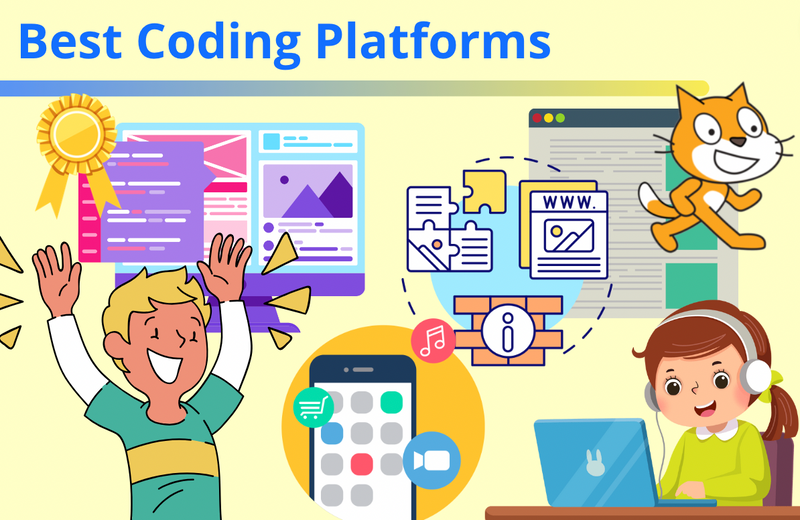
15 Remarkable Online Coding Platforms for Kids & Teens

25 Inspiring Computer Science Quotes
Logic & Thinking Games for Kids
Elevate your child's problem-solving abilities with our fun logic & thinking games for kids. They will learn to analyze, strategize, and think critically while having fun. Explore our collection now and provide them with endless opportunities to learn and grow. Start playing for free now!

CONTENT TYPE
- Lesson Plans
- Math (2,046)
- Number Sense (381)
- Number Recognition (30)
- Number Recognition Within 5 (12)
- Number Recognition Within 10 (12)
- Number Recognition Within 20 (6)
- Number Tracing (20)
- Number Tracing Within 5 (5)
- Number Tracing Within 10 (5)
- Number Tracing Within 20 (10)
- Number Sequence (56)
- Counting (141)
- Counting Objects Within 5 (47)
- Counting Objects Within 10 (43)
- Counting Objects Within 20 (6)
- Compare Numbers (47)
- Compare Objects (7)
- Compare Numbers Using Place Value (5)
- Compare 2-Digit Numbers (6)
- Compare 3-Digit Numbers (10)
- Order Numbers (15)
- Skip Counting (36)
- Skip Count By 2 (8)
- Skip Count By 5 (8)
- Skip Count By 10 (13)
- Skip Count By 100 (3)
- Even And Odd Numbers (3)
- Place Value (78)
- Teen Numbers (4)
- Word Form (5)
- Expanded And Standard Form (14)
- Unit Form (4)
- Round Numbers (16)
- Round Numbers To The Nearest 10 (8)
- Round Numbers To The Nearest 100 (4)
- Addition (369)
- Add With Pictures (38)
- Addition Properties (6)
- Addition Strategies (136)
- Compose And Decompose Numbers (66)
- Number Bonds (9)
- Count All To Add (9)
- Add Using A Number Line (7)
- Count On To Add (11)
- Add With 10 (2)
- Doubles And Near Doubles Addition Strategy (21)
- Make 10 Strategy (4)
- Add Three Whole Numbers (20)
- 2-Digit Addition (45)
- 2-Digit Addition Without Regrouping (23)
- 2-Digit Addition With Regrouping (16)
- 3-Digit Addition (65)
- 3-Digit Addition Without Regrouping (48)
- 3-Digit Addition With Regrouping (13)
- 4-Digit Addition (30)
- 4-Digit Addition Without Regrouping (13)
- 4-Digit Addition With Regrouping (17)
- Large Numbers Addition (10)
- 5-Digit Addition (6)
- Subtraction (240)
- Subtract With Pictures (35)
- Subtraction Strategies (48)
- Count Back Strategy (13)
- Doubles And Near Doubles Subtraction Strategy (6)
- 2-Digit Subtraction (30)
- 2-Digit Subtraction Without Regrouping (20)
- 2-Digit Subtraction With Regrouping (8)
- 3-Digit Subtraction (57)
- 3-Digit Subtraction Without Regrouping (35)
- 3-Digit Subtraction With Regrouping (20)
- 4-Digit Subtraction (23)
- 4-Digit Subtraction Without Regrouping (12)
- 4-Digit Subtraction With Regrouping (11)
- Large Numbers Subtraction (8)
- 5-Digit Subtraction (5)
- Multiplication (196)
- Multiplication Strategies (56)
- Multiplication With Equal Groups (16)
- Multiplication With Arrays (20)
- Multiplication Sentences (11)
- Multiplication On A Number Line (13)
- Repeated Addition To Multiply (17)
- Times Tables (88)
- Multiplication By 2 (10)
- Multiplication By 3 (10)
- Multiplication By 4 (9)
- Multiplication By 5 (10)
- Multiplication By 6 (9)
- Multiplication By 7 (8)
- Multiplication By 8 (8)
- Multiplication By 9 (9)
- Multiplication By 10 (5)
- Multiplication By 11 (5)
- Multiplication By 12 (5)
- Multiplication Properties (15)
- Distributive Property Of Multiplication (6)
- Multiply By Multiples Of 10 (8)
- Estimate Products (4)
- Multi-Digit Multiplication (40)
- Multiply 2-Digit By 1-Digit Numbers (11)
- Multiply 2-Digit By 2-Digit Numbers (11)
- Multiply 3-Digit By 1-Digit Numbers (7)
- Multiply 3-Digit By 2-Digit Numbers (4)
- Multiply 4-Digit By 1-Digit Numbers (7)
- Division (119)
- Divide On A Number Line (3)
- Division Facts (60)
- Division By 2 (5)
- Division By 3 (5)
- Division By 4 (5)
- Division By 5 (5)
- Division By 6 (5)
- Division By 7 (5)
- Division By 8 (5)
- Division By 9 (5)
- Estimate Quotients (4)
- Long Division (36)
- Divide 2-Digit By 1-Digit Numbers (10)
- Divide 3-Digit By 1-Digit Numbers (11)
- Divide 4-Digit By 1-Digit Numbers (7)
- Divide 4-Digit By 2-Digit Numbers (7)
- Fractions (186)
- Fractions Using Models (28)
- Fractions On A Number Line (10)
- Compare Fractions (22)
- Compare Fractions Using Models (6)
- Equivalent Fractions (25)
- Equivalent Fractions Using Models (10)
- Mixed Numbers As Improper Fractions (4)
- Fractions Operations (91)
- Add Fractions (22)
- Add Fractions Using Models (7)
- Add Like Fractions (15)
- Estimate Fraction Sums (3)
- Subtract Fractions (13)
- Subtract Fractions Using Models (6)
- Subtract Like Fractions (7)
- Add Mixed Numbers (10)
- Subtract Mixed Numbers (12)
- Subtract A Fraction From A Mixed Number (5)
- Multiply Fractions (22)
- Multiply Fractions Using Models (10)
- Multiply Fractions By Whole Numbers (18)
- Divide Fractions (8)
- Decimals (138)
- Read And Write Decimals (40)
- Decimals Using Models (8)
- Decimals On A Number Line (6)
- Decimal Place Value (26)
- Expanded Form Of Decimals (7)
- Compare Decimals (22)
- Order Decimals (15)
- Round Decimals (12)
- Round Decimals To The Nearest Whole (5)
- Convert Decimals To Fractions (11)
- Decimal Operations (40)
- Add Decimals (6)
- Subtract Decimals (5)
- Multiply Decimals (13)
- Divide Decimals (14)
- Divide Decimals By Whole Numbers (5)
- Geometry (129)
- Positional Words (5)
- Lines, Line Segments, Rays (6)
- Parallel And Perpendicular Lines (5)
- Angles (15)
- Shapes (80)
- 2D Shapes (68)
- Attributes Of 2D Shapes (23)
- Triangles (4)
- Quadrilaterals (13)
- 3D Shapes (11)
- Partition Into Equal Parts (13)
- Partition In Halves, Thirds, And Fourths (12)
- Coordinate Plane (7)
- Data Handling (46)
- Sorting Objects (7)
- Bar Graphs (12)
- Line Plots (13)
- Picture Graphs (10)
- Measurement (125)
- Length (34)
- Measure Lengths Using The Ruler (8)
- Estimate Lengths (4)
- Comparing Lengths (15)
- Comparing Heights (6)
- Weight (12)
- Capacity (12)
- Conversion Of Measurement Units (15)
- Perimeter (19)
- Am And Pm (2)
- Time In Hours (5)
- Time In Half Hours (4)
- Time In Quarter Hours (7)
- Time To The Nearest 5 Minutes (11)
- Time To The Nearest Minute (2)
- Elapsed Time (3)
- Identify Coins (13)
- Counting Money (14)
- Compare Money (7)
- Add And Subtract Money (17)
- Multiply And Divide Money (7)
- Algebra (54)
- Number Patterns (29)
- Expressions And Equations (13)
- Order Of Operations (5)
- Factors And Multiples (7)
- Prime And Composite Numbers (5)
- Word Problems (97)
- Addition Word Problems (26)
- Addition Word Problems Within 20 (19)
- Subtraction Word Problems (28)
- Subtraction Word Problems Within 20 (22)
- Multiplication Word Problems (2)
- Division Word Problems (9)
- Fraction Word Problems (6)
- Money Word Problems (23)
- ELA (2,367)
- Reading (2,269)
- Phonics (2,225)
- Bossy R (60)
- Words With Ar (3)
- Words With Er (3)
- Words With Ir (3)
- Words With Or (3)
- Words With Ur (3)
- Diphthongs (22)
- Consonant Blends (118)
- Ending Blends (69)
- Beginning Blends (49)
- L Blend Words (26)
- R Blend Words (23)
- Alphabet (262)
- Letter Recognition (262)
- Letter A (9)
- Letter B (9)
- Letter C (9)
- Letter D (9)
- Letter E (9)
- Letter F (9)
- Letter G (9)
- Letter H (9)
- Letter I (9)
- Letter J (9)
- Letter K (9)
- Letter L (9)
- Letter M (9)
- Letter N (9)
- Letter O (9)
- Letter P (9)
- Letter Q (9)
- Letter R (9)
- Letter S (9)
- Letter T (9)
- Letter U (9)
- Letter V (9)
- Letter W (9)
- Letter X (9)
- Letter Y (9)
- Letter Z (9)
- Lowercase Letters (78)
- Uppercase Letters (78)
- Matching Lowercase And Uppercase Letters (59)
- Alphabetical Order (54)
- Abc Song (20)
- Letter Sounds (130)
- Vowels (158)
- Long Vowel Sounds (75)
- Long Vowel A Sound (15)
- Long Vowel E Sound (17)
- Long Vowel I Sound (15)
- Long Vowel O Sound (15)
- Long Vowel U Sound (13)
- Silent E (12)
- Short Vowel Sounds (81)
- Short Vowel A Sound (59)
- Short Vowel E Sound (26)
- Short Vowel I Sound (59)
- Short Vowel O Sound (44)
- Short Vowel U Sound (24)
- Vowel Teams (65)
- Words With Ai And Ay (3)
- Words With Ea And Ee (3)
- Words With Ie And Y (3)
- Words With Oa And Ow (3)
- Words With Oo (2)
- Words With Ue And Ui (1)
- Blending (432)
- Ccvc Words (43)
- Ccvcc Words (6)
- Cvc Words (271)
- Cvcc Words (78)
- Consonant Digraphs (8)
- Digraph Ch (3)
- Digraph Ph (2)
- Digraph Sh (3)
- Digraph Th (2)
- Digraph Wh (2)
- Double Consonants (8)
- Rhyming Words (61)
- Trigraphs (38)
- Three Letter Blends (19)
- Sight Words (1,035)
- Dolch Sight Words (567)
- Fry Sight Words (444)
- Reading Comprehension (44)
- Cause And Effect (6)
- Inference (6)
- Identify The Main Idea And Key Details (13)
- Categorize Pictures Into Groups (4)
- What'S The Title? (5)
- Prediction (6)
- Sequencing (13)
- Arrange Pictures In Order (3)
- Arrange Sentences In Order (4)
- Writing (124)
- Handwriting (124)
- Letter Tracing (124)
- Letter Tracing A (6)
- Letter Tracing B (6)
- Letter Tracing C (6)
- Letter Tracing D (6)
- Letter Tracing E (6)
- Letter Tracing F (6)
- Letter Tracing G (6)
- Letter Tracing H (6)
- Letter Tracing I (6)
- Letter Tracing J (6)
- Letter Tracing K (6)
- Letter Tracing L (6)
- Letter Tracing M (6)
- Letter Tracing N (6)
- Letter Tracing O (6)
- Letter Tracing P (6)
- Letter Tracing Q (6)
- Letter Tracing R (6)
- Letter Tracing S (6)
- Letter Tracing T (6)
- Letter Tracing U (6)
- Letter Tracing V (6)
- Letter Tracing W (6)
- Letter Tracing X (6)
- Letter Tracing Y (6)
- Letter Tracing Z (6)
- General Knowledge (295)
- Vegetables (19)
- Fruits (24)
- Dessert (9)
- Animals (58)
- Underwater (9)
- Dinosaurs (8)
- Reptiles (9)
- Seasonal (28)
- Christmas (12)
- Halloween (8)
- Kitchen (11)
- Utensils (6)
- Musical Instruments (30)
- Transport (9)
- Vehicles (9)
- Insects (9)
- Professions (8)
- Monuments (8)
- Household Items (8)
- Flowers (8)
- Buildings (8)
- Art & Creativity (236)
- Coloring (181)
- Animals (32)
- Underwater (8)
- Reptiles (8)
- Vegetables (8)
- Transport (8)
- Vehicles (8)
- Musical Instruments (8)
- Kitchen (8)
- Utensils (5)
- Insects (8)
- Rhymes (25)
- Cooking (7)
- Stories (10)
- Logic & Thinking (16)
- Puzzles (11)
- Matching (3)
- Multiplayer (12)
- Time Based (12)
- Player vs Player (12)
- Motor Skills (16)
- Fine Finger Movement (9)
- Aiming and Precision (6)
Puzzles Games

Sneaky Shapes Game
Sharpen your observation skills and uncover hidden shapes.

Challenge Two of a Kind Game
Sharpen your memory and find matching pairs in this engaging game.

Play Word Detective Game
Put your word skills to the test and solve puzzles like a detective.

Picture Perfect Game
Paint, draw, and express your artistic skills in this picture perfect game.
All Logic & Thinking Games

Cooking Adventure Game
Get ready for a cooking adventure and satisfy hungry customers.

- Number Ninja: Fun Math Arcade Game
Become a number ninja and slice through math challenges.

Dive into Arty Crafty Game
Let your artistic skills shine and create amazing crafts.

Dive into Get Set Quiz Game
Get ready to quiz yourself and challenge your knowledge in this interactive game.

- Peek A Boo Game
Peek-a-boo! Have fun and uncover surprises in this engaging game.

Play Jumble Mania Game
Test your word skills and unravel the jumble in this exciting game.

Toss Up Game
Challenge your accuracy and toss objects to hit various targets.

Challenge Match-Up Puzzles Game
Test your memory and matching skills in this engaging puzzle game.

Dive into Sky Boxes Game
Test your stacking skills and reach new heights in this sky-high game.

Discover Shape Building Arty Crafty Game
Use your imagination and build various shapes in this engaging arty crafty game.

Play Shape Matching Arty Crafty Game
Sharpen your shape recognition skills and complete various shape matching activities in this engaging game.

Experience Polyword Game
Dive into the world of polywords and solve challenging puzzles.
Brain-Boosting Games for Young Minds
Explore a world of fun and educational games that challenge young minds to think critically, solve puzzles, and learn while having a blast. Our carefully curated selection of games is designed to spark curiosity, enhance problem-solving skills, and foster a love for learning in kids of all ages.
What are Logic and Thinking games?
Logic and thinking-themed games are interactive activities designed to challenge young minds by requiring them to use critical thinking, problem-solving, and strategic reasoning. These games involve creative challenges that stimulate cognitive development, enhance decision-making skills, and foster a love for learning in children. They provide an enjoyable way for kids to develop essential life skills while having fun.
What are the Types of Logic and Thinking Games Online?
These games come in various engaging forms, each offering a unique cognitive challenge. Here are some popular types:
- Shape Matching: Arty Crafty Game : In this game, young minds exercise their visual perception and spatial reasoning skills by matching shapes and patterns. It encourages creativity and helps improve attention to detail.
- Match Up!: Puzzles Game : Match Up! puzzles provide a mental workout, requiring players to find pairs or connections among objects, images, or symbols. This type of game enhances memory, concentration, and pattern recognition.
- Shape Building: Arty Crafty Games : Shape building games stimulate creativity and problem-solving as kids construct objects or scenes by fitting together various shapes. It fosters spatial awareness and encourages imagination.
What are the Benefits of Playing Logic and Thinking Games for Kids?
Engaging in these games offers numerous advantages for young minds:
- Enhanced Problem-Solving : Interactive Logic and thinking games to play encourage kids to tackle challenges, fostering strong problem-solving skills.
- Improved Critical Thinking : Playing promotes analytical thinking, helping children make reasoned decisions.
- Boosted Creativity : Logic games often involve creative solutions, nurturing imaginative thinking.
- Sharper Memory : Memory-based games enhance recall and concentration.
What are the Best Logic and Thinking Games?
Kids can enjoy these engaging these games on mobiles and tablets, combining fun and learning:
- Cooking Rush Game
- Arty Crafty Game
- Get-Set-Quiz Game
- Jumble Mania Game
Your one stop solution for all grade learning needs.
- Skip to main content
- Skip to primary sidebar

10 Problem Solving Games for Kids
Playing board games is one of the best ways to spend time with your children. Why? Board games offer ample ways for kids to build their brains. Not only does playing games with your children improve family relationships and give opportunities for caring adults to help nurture good sportsmanship but the best games build kids' critical thinking and problem solving skills.
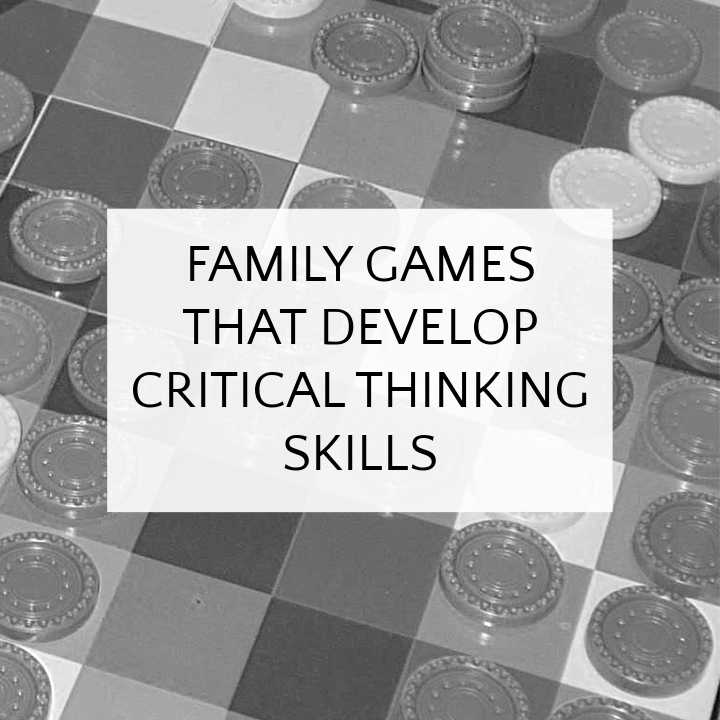
Note: this post contains affiliate links that may earn commission.
We've composed a list of problem solving games for kids that help develop the following critical skills:
- Advance planning - what steps do you need to make in order to reach your goal?
- Decision making - evaluating the benefits of multiple choices
- Drawing conclusions and inference - how will your opponent respond to your choice?
- Reevaluation - how you respond when the result is unexpected
Games work on all these skills while also being fun. What could be better? Here are our favorite 10 problem solving games for kids and families!
A note regarding age recommendations. I've included the manufacturer's recommendation, but most games can be played with younger kids, provided an adult is at the ready to assist.
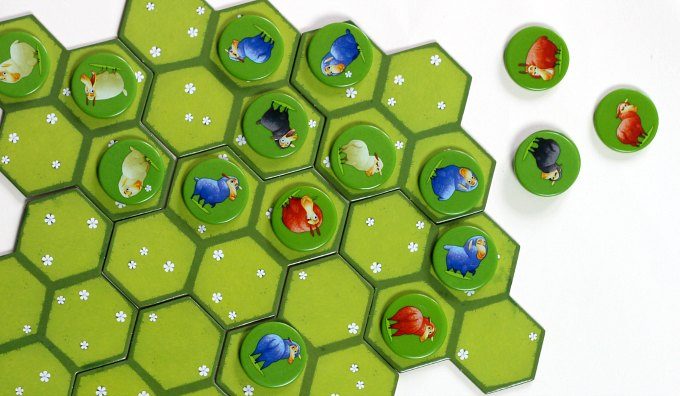
BATTLE SHEEP
Every time you play Battle Sheep the playing space is different! That's because players start with 4 pasture boards that they take turns placing down to create the playing field. Kids are using advance planning and reevaluation right off the bat! Each player begins with 16 sheep and aims towards occupying as many pastures as they can. Players must chose between placing sheep or strategically blocking their opponents. We love this game that engages players' abstract thinking, strategic, and visual perception skills. Ages 7 and up. 2-4 players.
Find it: Amazon
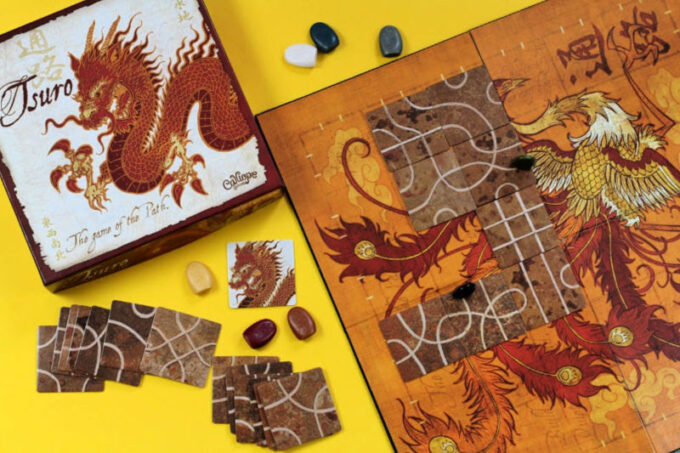
The board changes every time you play, keeping players on their toes and constantly reassessing their strategy. Players use tiles to create paths along which they move their tokens. The objective is to create paths in such a way that keep you moving but force your opponents off the board. Players must anticipate other's moves and problem solve in order accomplish both goals. Tsuro is also surprisingly easy to learn! Ages 8 and up. 2-8 players.
MORE : Our favorite tile-based games
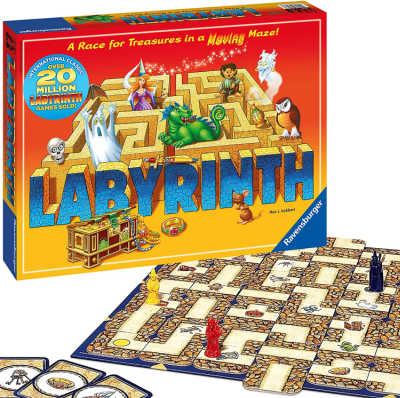
Players make their way through an ever-shifting maze in pursuit of treasure. Each player begins with a set number of treasure cards and the player who collects all their treasure first, wins. The board consists of moving panels and on their turn, a player shifts the panels in an effort to further their own progress or hinder that of others. Ages 7 and up. 2-4 players
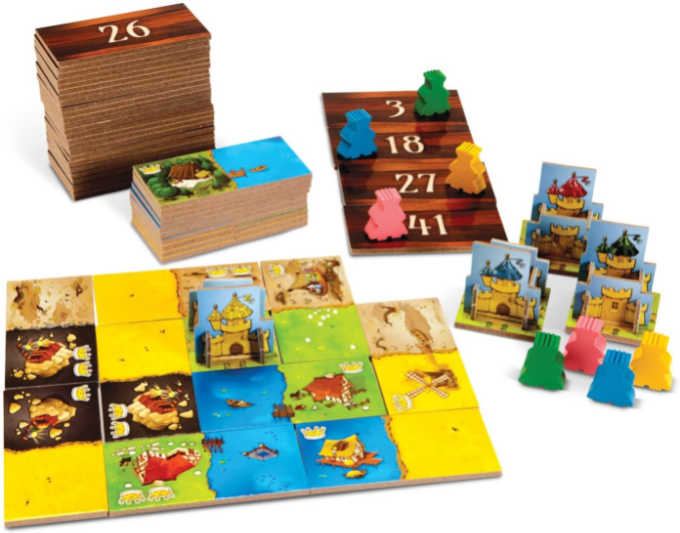
Kingdomino is a tile placing game in which players must make choices regarding how to build their kingdom. The objective of the game is to score as many points as possible by matching tiles based on terrain. But some terrains score more than others. Players must decide if they want to build a lot of low scoring terrains, or fewer high-scoring terrains. Your tile choice also affects the order of play for the next round so it's important to be thoughtful. We've throughly enjoyed this game. An expansion pack is available. Ages 8 and up. 2-4 players
Find it: Kingdomino | Expansion pack | Queendomino
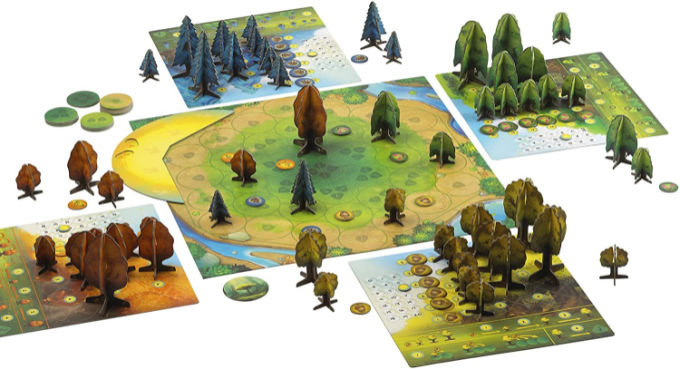
PHOTOSYNTHESIS
Photosynthesis from Blue Orange Games has an environmental theme. Players focus on growing trees through their life cycle from seed to maturity. Players strategize to "plant" their seeds where they will receive the most light, without being blocked in the future by other, maturing, trees. Successful game play requires planning and analysis. The artwork is beautiful and adds to the unique game play. We have enjoyed playing this game! Ages 8 and up. 2-4 players.
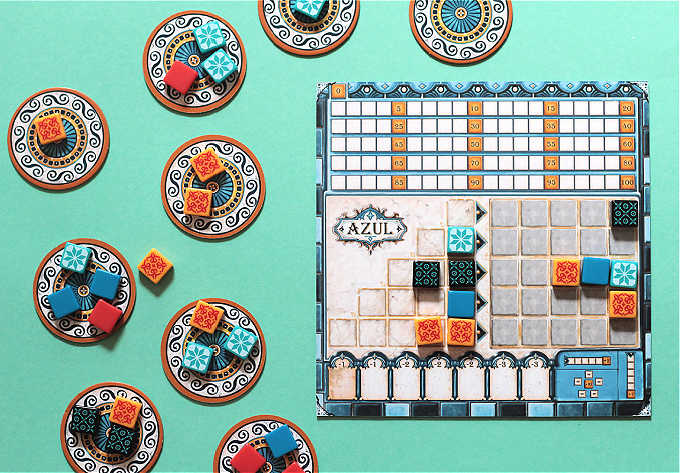
Azul's stunningly colorful game design was inspired by azulejos , a type of decorated ceramic tile introduced to Spain by the Moors and made popular in Portugal by King Manuel I. Players transform into tile laying artists, and must strategize over three phases of game play: choosing tiles, laying them and prepping for the next round. The object is to collect the most points by creating lines of 5 consecutive tiles. Each line of tiles must contain only one of each type of tile. The game ends when one player has completed a row, but that player is not necessarily the winner. Strategic problem solving and planning are required because players can lose points in the wall-tiling phase for any remaining, unused tiles. Ages 8 and up. 2-4 players.
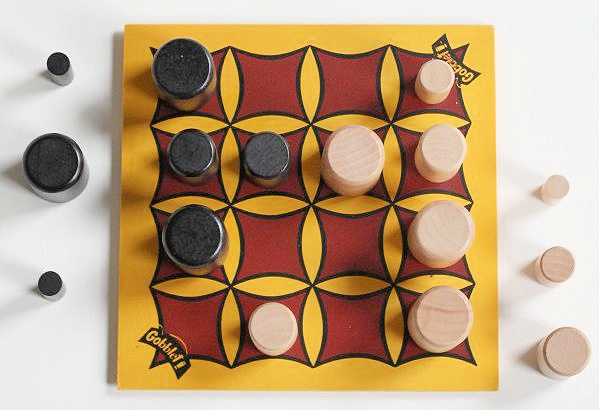
Gobblet looks like Tic Tac Toe but players have large, medium and small pieces that nestle inside each other like Russian dolls. Players attempt to get four in a row by "gobbling" up smaller pieces. The game relies on advance planning, anticipating your opponent's moves and memory skills since you have to remember which Gobblets have been gobbled without peeking! Ages 7 and up. 2 players. A version for ages 5 and up is available as Gobblet Gobblers.
Find it: Gobblet | Gobblet Gobblers
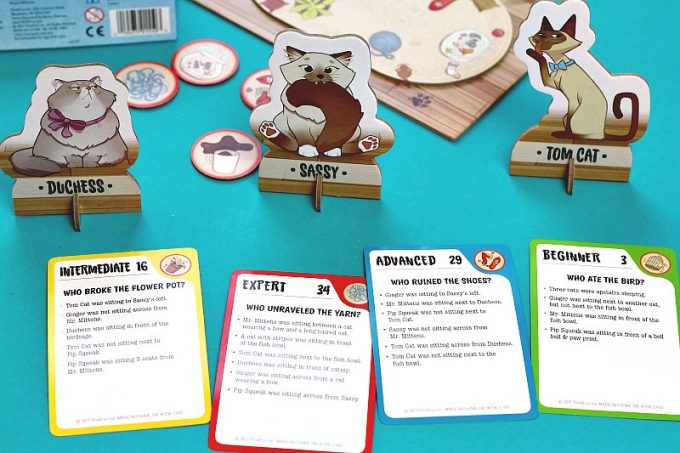
LOGIC GAMES
Logic games are the ultimate problem solving entertainment! We love single player logic games and probably own an unhealthy number of these brain boosting puzzle games.
The following are some of our top favorites:
- Cat Crimes , ages 8 and up ( pictured above ) - see it as our game of the month feature
- Code Master , ages 8 and up - see it as our game of the month feature
- Castle Logix , ages 3 and up - see it as our game of the month feature
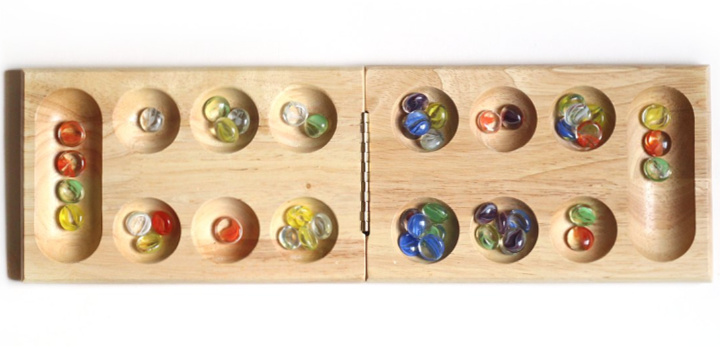
Mancala is a classic game every family should have. The board has two rows of depressions, plus end "home" bowls. The goal is to transfer the most stones from the rows into your home. A set of rules govern how you deposit and capture stones. You must use strategy to capture stones and ensure you do not leave them vulnerable to your opponent's greedy, greedy paws. Playing Mancala improves memory and observation skills. You must engage your strategic thinking skills to make sure you don't inadvertently give your opponent the opportunity to thwart you. Ages 8 and up. 2 players.
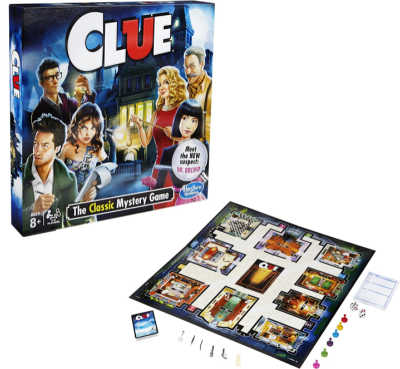
There's a reason the classic detective board game, Clue, remains so popular. I loved it when I was a kid and I bet you did, too. Players race to be the first person to solve the mystery of the who, what and where of a murder. Clue requires deductive reasoning and logic skills to narrow down the possibilities. Players must also vigilantly observe the actions of other players to help them make logical decisions. Ages 8 and up, 2-6 players ( much better with 3 or more players ).
- 6 games that improve visual perception
- Best award-winning games for each ages
- 12 best family games for all ages and skill levels
Reader Interactions
Leave a reply cancel reply.
Your email address will not be published. Required fields are marked *
This site uses Akismet to reduce spam. Learn how your comment data is processed .

Problem-Solving Skills for Kids: 10+ Games, Activities & Worksheets
Teaching Problem Solving Skills for Kids is about more than just solving math problems or deciding who gets the last piece of pizza. It’s about preparing them for real life, where they face many situations every day that require quick and effective decision-making.
It’s important for parents and educators to guide children to think creatively and keep trying, rather than solving every problem for them.
For example, if two children want the same toy, instead of deciding for them, encourage them to talk and come up with a sharing plan. This approach not only solves the immediate issue but also teaches valuable lessons in negotiation and fairness.
Kids who learn problem-solving skills become good at seeing challenges as chances to learn and grow, not just obstacles.
Table of Contents
What Are Problem-Solving Skills?
Think about a time when you had a messy pile of shoelaces or blocks. It might have seemed tough at first, but then you figured out how to sort it all step by step. That’s problem-solving!
Problem-solving skills are like superpowers for handling all kinds of challenges. Whether it’s sharing toys with friends or choosing a game that everyone enjoys, these skills help you find smart solutions.
It’s not just about solving problems.
It’s about understanding them, thinking creatively, and sometimes working together.
So, the next time you face a tricky puzzle or situation, remember you’re ready to use your problem-solving skills.
Are you ready to be a problem-solving hero?
Why Kids Need Problem-Solving Skills?
Imagine you’re on a team, tasked with building the tallest tower using blocks. Everyone has ideas, but how do you choose the best one? This is where problem-solving skills are essential.
Problem-solving is not just about figuring things out by yourself; it involves teamwork, understanding various perspectives, and finding solutions that satisfy everyone. It’s like being a detective in everyday life, solving puzzles that make life smoother and more enjoyable for you and your friends.
Being good at solving problems means you can better manage difficult situations, like sharing fairly or adjusting when plans change. This skill boosts your independence and confidence because you know you can tackle any challenge.
Plus, excellent problem solvers are valuable team members and friends that everyone appreciates.
Building Resilience
When children tackle problems and figure out solutions, they become more resilient. This resilience allows them to recover from difficulties and adopt a positive, growth-focused attitude.
As children handle more challenges by themselves, they start to see problems as hidden opportunities.
Fostering Independence
Problem-solving skills help kids become more independent. By learning to think critically and make their own decisions, children grow to rely on themselves.
This self-reliance is key to becoming a responsible adult. When parents and teachers support these skills, they empower kids to manage their own lives.
Teamwork and Collaboration
Teamwork and collaboration involve kids working together to find solutions and reach goals. It teaches them to share ideas, listen to each other, and work as a team.
During problem-solving, they come up with ideas, talk about them, and choose the best one. Everyone plays a part and their ideas are important.
Teamwork helps kids learn to cooperate, respect different opinions, and use each other’s strengths. This way, they can overcome challenges and come up with creative solutions together.
Academic Success
Helping kids succeed in school is about more than just learning facts. it’s about teaching them how to solve problems. These skills allow kids to think deeply, understand different situations, and come up with solutions on their own.
Through group projects, tough puzzles, and hands-on experiences, kids learn to face challenges with creativity and determination.
As they get better at solving problems, they become more confident and flexible, which helps them do well in school and encourages a lasting passion for learning.
Types of Problem-Solving Skills
Problem-solving skills for kids include critical thinking, creativity, and resilience. They learn to analyze complex problems by breaking them into smaller parts. Creativity helps them think of different solutions.
Being able to communicate well allows them to share ideas and work with others. Persistence and resilience teach them to keep going, even when things get tough.
These skills help children confidently solve problems on their own, which helps them grow and develop.
Creative Thinking
Creative thinking is all about seeing things from a new perspective. When kids learn to think creatively, they can come up with innovative solutions to problems.
This skill is valuable not just in academics but in all areas of life.
Critical Thinking
Critical thinking involves analyzing information and evaluating different solutions. It’s essential for problem-solving because it helps kids make informed decisions.
Teaching kids to ask questions, seek evidence, and consider different viewpoints enhances their critical thinking skills .
Decision Making
Decision-making is the process of choosing between different options. This skill is closely related to problem-solving because it involves weighing the pros and cons of various choices.
Helping kids understand the impact of their decisions and guiding them through the process strengthens their problem-solving abilities.
Strategies to Teach Problem-Solving Skills
Ready to help your kids learn problem-solving? It’s a valuable skill that can be enjoyable to teach. Here are some great ways to help your children become skilled problem solvers.
Start with guided play, where you create scenarios or games that pose challenges. For example, building a bridge with blocks to avoid a “lava floor” or figuring out how to share snacks equally. Guided play offers a safe environment for children to experiment and discover solutions.
Then, try story-based problem-solving. Use stories to present problems, and after reading, ask, “What would you do in this situation? ” This encourages kids to think critically and creatively about the issues in the story.
Encourage them to ask questions like “What if?” and “ Why not? ” This boosts their curiosity and enhances their problem-solving skills as they explore different outcomes.
Also, lead by example. When you encounter a problem, share your thought process out loud. Show how you consider options and consequences before making a decision.
This real-life demonstration can greatly influence their learning.
By using these strategies, you’re not only teaching your children to solve problems, you’re also equipping them with skills to handle school, friendships, and future careers
Encourage Curiosity
Encouraging kids to be curious helps them get better at solving problems. When kids are free to ask questions and find answers, they start thinking more deeply and creatively.
This is important for solving problems well. If kids have a safe space to explore and make mistakes, they learn a lot from those mistakes.
Role-Playing Activities
Role-playing activities are fun and interactive games where kids pretend to be different characters, like detectives or doctors.
They face various challenges that require them to think creatively, solve problems, and make decisions. This helps them develop important skills such as understanding situations, working together with others , and effective communication.
Open-Ended Questions
Open-ended questions are those that kids can’t simply answer with a “yes” or “no.” They help children think creatively and critically, boosting their problem-solving abilities.
By asking such questions, adults encourage kids to express their ideas and reasoning, which deepens their understanding and helps them come up with their own solutions.
This not only improves their communication skills but also helps them see different viewpoints and explain their thoughts. Overall, this method nurtures curiosity and equips kids to approach problems with confidence and creativity.
Reflective Practice
Reflective practice in problem-solving helps kids think about how they solved a problem. They learn which strategies worked and which didn’t.
This reflection helps them get better at solving problems, builds critical thinking, and teaches them to keep improving. It makes them stronger and more effective problem solvers as they grow.
Problem-Solving Games and Activities
Problem-solving games are not only fun; they’re also excellent brain training, helping you become quicker and more creative at solving problems.
Consider playing a treasure hunt where you solve riddles to find clues or building a maze for a toy car that you navigate using a straw. These activities require quick thinking, strategy, and foresight, mirroring real-life problem-solving.
Activities range from puzzles, where you piece things together, to strategic board games . Even team sports and pretend adventures teach you to observe, analyze, and act on key problem-solving skills.
Why not try these engaging games? Each puzzle you solve or strategy you perfect helps you become a better problem solver.
Ready to learn while playing? Let’s start and discover the great solutions you can create!
Puzzles and Brain Teasers
Puzzles and brain teasers are fun ways to boost kids’ problem-solving skills. These challenges can be jigsaw puzzles, tricky riddles, or math puzzles, all designed to make kids think critically and creatively.
By solving them, kids learn to break down problems, be persistent, and find different solutions.
Jigsaw puzzles, Sudoku, Rubik’s cubes or Riddle Generator
STEM Challenges
Set up STEM (Science, Technology, Engineering, and Mathematics) challenges in which kids build structures with blocks , design paper airplanes, or create simple machines using household items.
Websites like NASA’s “STEM Activities for Kids” offer great resources.
Indoor/ Outdoor Scavenger Hunt:
Create a scavenger hunt in your backyard or a nearby park. Give kids a list of items to find or clues to follow, encouraging teamwork and problem-solving.
Learn More here at : Indoor scavenger Hunt , Nature Scavenger Hunt . Halloween Scavenger hunt
Scenario-based Activities
While problem-solving activities are fantastic for developing cognitive skills, it’s equally crucial to equip kids with the tools to handle social challenges.
One way to cultivate these skills is by engaging kids in scenario-based activities. Present various social situations and ask, “What will you do?” Then, offer four alternatives to choose from. like
- Your friend wants to play with your favorite toy, but you don’t want to share it. What will you do?
- During recess, you notice a classmate sitting alone and looking sad. What will you do?
- Someone in your class is being teased by others. What will you do?
- Your friend borrowed a book from you and accidentally ripped a page. What will you do?
- You’re playing a game with your friends, but one of them keeps cheating. What will you do?
These scenarios cover a range of social interactions and dilemmas. Allow kids to give their own Perspectives on each. Offering alternatives will ease their thinking process. Here is the “What will you do?” Worksheet to download and use.
Science Experiments:
Conduct simple science experiments at home that involve problem-solving, like creating a DIY volcano or testing the buoyancy of different objects.
Here is the list,
- Sink or Float
- Paper Airplane Engineering
- DIY Volcano
- Magnetic Attraction
- Color Changing Milk
- Gummy Bear Osmosis
- DIY Rainbow
Board Games:
Play board games that require strategic thinking and decision-making, such as chess, checkers, or strategy-based card games like Uno or Settlers of Catan. here is the List
- Settlers of Catan Junior
- Ticket to Ride
- Robot Turtles
- Rush Hour Junior
- Forbidden Island
Art Challenges:
Give kids art challenges like drawing a picture using only geometric shapes or creating a sculpture from recycled materials. This encourages creative problem-solving and thinking outside the box. Like
- Collage Making With magazines, colored paper, fabric scraps, buttons, and beads
- Painting with Unconventional Tools Like sponges, cotton swabs, toothbrushes, or even vegetables
- Found Object Sculptures Like twigs, stones, bottle caps, and cardboard.
- Story Illustration
- Mosaic Art With cardboard or wood
- Shadow Drawing
- Tape Resist Art on on a canvas or paper
Escape Room Challenges :
Design a DIY escape room at home with age-appropriate puzzles and riddles. Kids can work together to solve clues and unlock the “escape.”
Trial and Error
Trial and error is a fantastic way for Kids to learn and explore new things. Just like we navigate the complexities of new gadgets, kids can dive into the world of toys and games with curiosity and determination.
Instead of giving kids all the instructions upfront, encourage them to experiment with different ingredients and techniques.
The kid might make a mess or burn a few pancakes along the way, but through trial and error, [he/she] will gradually learn how to whip up delicious meals.
Problem-solving skills are essential for kids to grow and succeed. These skills help children become strong, independent, and skilled.
Parents and educators can teach problem-solving through fun methods like role-playing , games, or asking open-ended questions .
It’s important to equip kids with the right tools so they can confidently and creatively face any challenge.
😍 Want to Read More, Explore 👇 This Article
I’m a former teacher (and mother of Two Childs) with a background in child development. Here to help you with play-based learning activities for kids. ( Check my Next startup Cledemy.Com )
Leave a Comment Cancel reply
Save my name, email, and website in this browser for the next time I comment.
- Join Your Trial Class
- Book FREE Trial Now

Top 15 Problem Solving Activities for Kids [2022 List]
As they get older, children have countless opportunities to learn about the world. They do, however, face issues daily, whether it be peer pressure, complex mathematical computations, or arguments with their peers.
The advantages of problem-solving abilities for children are vast, and they may help them deal with such circumstances efficiently.
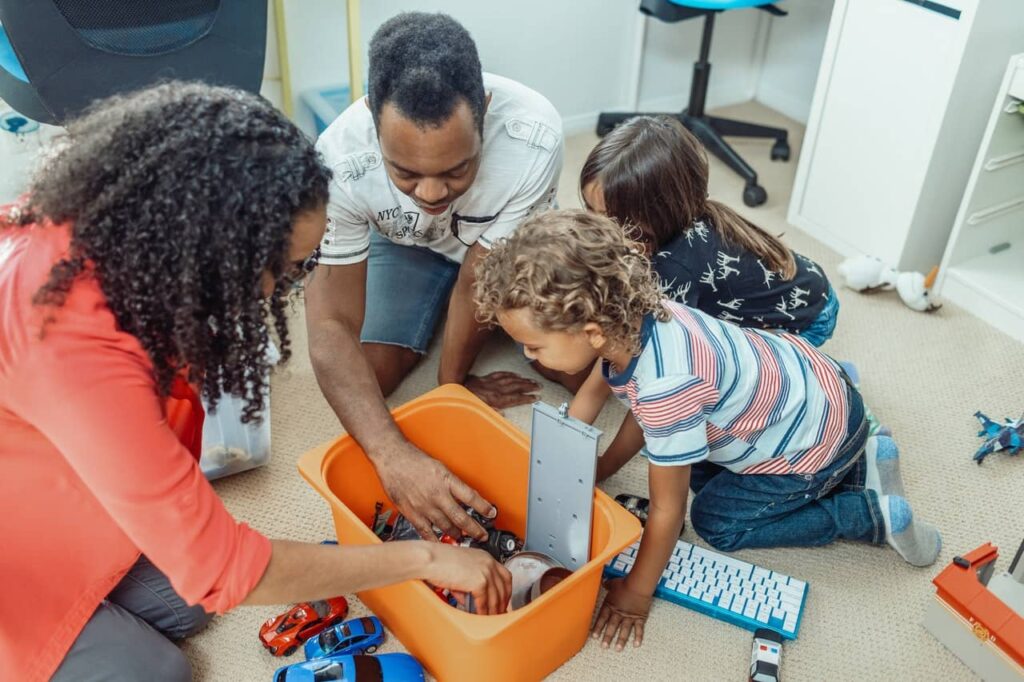
They will learn to develop practical answers on their own, without the assistance of an adult. Furthermore, when faced with challenges, students will be more confident in their abilities to use problem-solving skills and generate unique solutions on their own.
Read on to learn about the importance of problem-solving abilities in children, how to install this talent in them, and some activities to help them develop this important skill.
Table of contents
- The Importance of Problem Solving Skills in Children
- How to Teach Children Problem-Solving Skills?
- 15 Problem Solving Activities for Kids
The Importance of Problem Solving Skills in Children
Children gain from problem-solving in a variety of ways. It is beneficial to them.
- Deal with problems in regular life.
- Make sound judgments.
- Along the way, learn additional skills including teamwork, critical thinking, and collaboration.
- Problems should be solved without being broken down.
- Consider thinking beyond the box.
- Develop your independence.
How to Teach Children Problem-Solving Skills?
Here are a few ideas for encouraging your child to use their problem-solving abilities.
- Put it to the Test!
Encourage your youngster to accept the challenge when they are confronted with a problem. If the outcomes are unsuccessful, they might try different strategies.
Your child will be able to think about a subject from several angles as a result.
- Seek Counsel
Decision-making is a tough task. For example, you could have difficulty deciding what to prepare for supper or what to wear to the movies. Asking your children for assistance in decisions is an excellent choice.
When you approach them for guidance, they believe that they are not alone in their struggles. When you appreciate their ideas, they will gain the confidence to tackle challenges on their own.
- Take a Long, Deep Breath.
Maintaining your calm in difficult situations is one of the first steps toward effective problem-solving. Even among children, when their emotions run wild, it is difficult to think sensibly, and the temptation to make rash judgments increases.
It is critical to encourage your youngster to take deep breaths whenever they feel out of control of their emotions. They can better appraise the problem once they are calm.
- State the Issue Verbally.
Your child should openly express how they feel and what they are going through when they have calmed down. It provides them with a distinct perspective and facilitates the generation of alternate solutions.
- Do not give “The Solution”
It is not a good idea to provide immediate solutions to children’s problems. Instead, provide them with advice to assist them in solving the problem on their own. This will help them to think about solutions that are beneficial to them.
- Set a Good Example
Children quickly absorb knowledge like sponges. Therefore, when you approach an issue and find a workable solution, children will be inspired by your strategy and want to follow you.
- Allow the Natural Consequences to Play out.
Allowing a situation to take its course is sometimes the best approach to dealing with it. So, if your child encounters a challenge, let them be.
Assume your child spent their entire weekly allowance in a day or two; allow them to go the entire week without receiving any money. This will position them to make better decisions in the future.
15 Problem Solving Activities for Kids
There is no better way to learn than by playing. The following exercises are enjoyable and challenge youngsters to demonstrate their problem-solving abilities.
- Riddles
Riddles for kids are fantastic games for problem-solving. They come at various levels of difficulty. The appropriate one may be chosen based on your child’s age.
If you give children a puzzle, they will learn to consider the issue or question, generate potential answers, and select one.
Additionally, the practice will help students improve their hand-eye coordination, gross motor skills, and critical thinking. Also, if your kids have a way with words then what better than to engage them in wordle for kids !
- Scavenger Quest
Scavenger hunts are an instructive activity that every parent should offer to their children. It is a low-cost, easy, and entertaining activity that can be practiced both inside and outside and just requires materials you already have at home.
The activity encourages youngsters to think beyond the box. They are pleasantly acquiring problem-solving skills without even realizing it.
- Storybooks
The advantages of reading are countless. Problem-solving is one of them. While reading, children are introduced to several characters and their roles. They frequently connect with these figures. Undoubtedly, stories for kids are great resources to stimulate their minds!
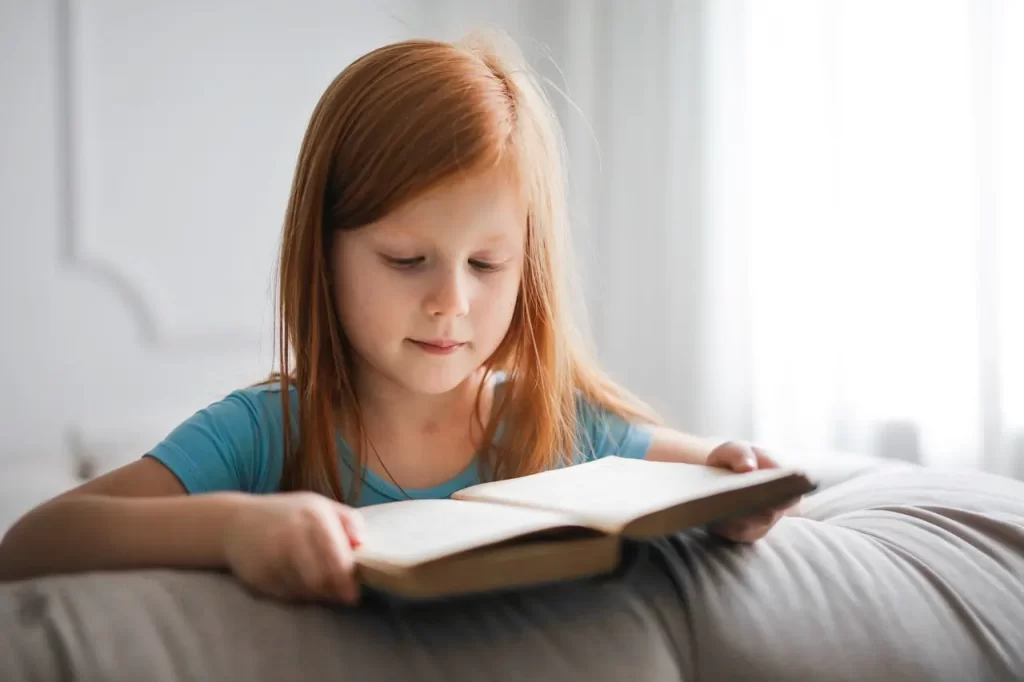
So, if kids encounter an issue, ask them how their favourite character would solve it. Encourage them to produce as many options as they can and discuss the results of each.
- Arts and Crafts
Another fantastic technique to educate youngsters about problem-solving abilities is via arts and crafts. Give your child a variety of things from around the house. Allow them to create fantastic creations or repair damaged devices or toys. Also checkout art hub for kids that can provide an immersive experience to your little ones!
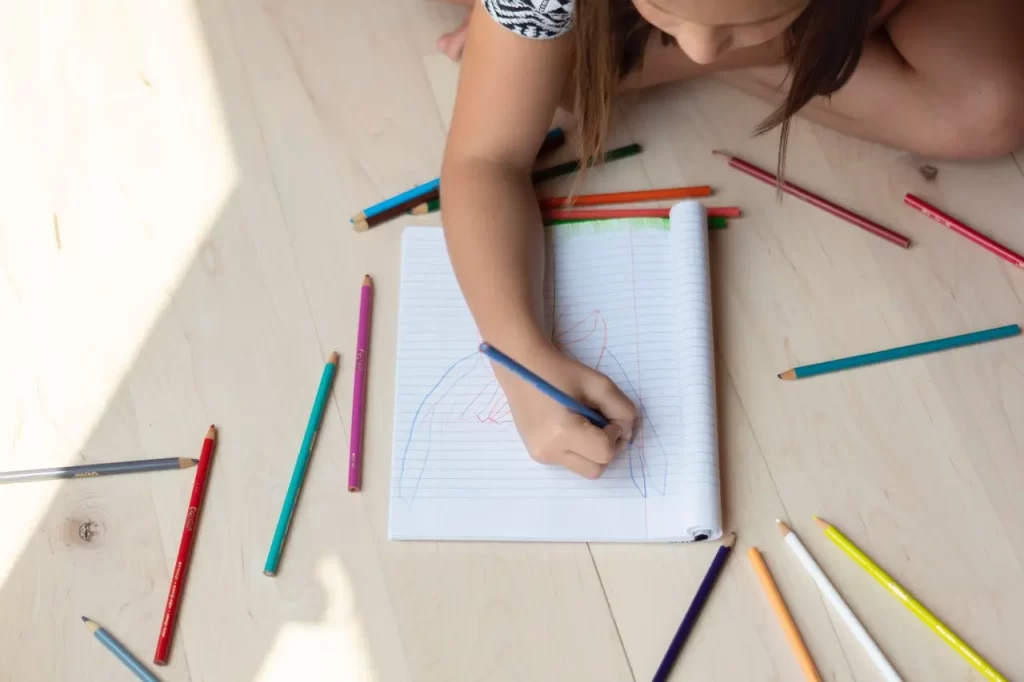
Give them complete freedom to do their task and only offer guidance when they are running out of ideas. And if your kids like to be more hands-on then check out crafts for kids !
- Free-Form Questions
Asking open-ended questions is an excellent method to help your child think creatively and critically and develop their problem-solving abilities.
As there are no right or wrong answers to these questions, and the answer extends beyond a simple “no” or “yes,” they must give some consideration to their responses.
The questions mentioned in the image above are some examples of open-ended questions.
- Maze
Mazes are enjoyable and safe for people of all ages. Working on mazes forces them to think. The practice also helps them strengthen their motor skills, observation skills, sense of direction, and problem-solving abilities.
Think beyond book mazes. There are other maze games available on the internet. They will get better at finding their way out with practice. You may eventually give them increasingly difficult mazes to solve.
- A Little Treasure Quest
The whole family can enjoy a treasure hunt. If they believe they will succeed, you can maintain their concentration on the task at hand.
Give them tips that encourage them to use their imaginations and resolve issues to win the prize.
- Toy Construction
Give your kids building materials like LEGO, wood blocks, engineering blocks, etc., and let them construct anything they want.
Toy construction requires your child to consider what to make, how to assemble the parts, and produce creative solutions to make sure the design is functional.

You can occasionally ask them to build something challenging, like a monster with three arms or two buildings joined by a bridge. Watch as they struggle to come up with a structure.
- Woollen Web
Each child should be given a piece of colorful yarn, and they should be told to construct a circle. The yarn ball is passed from one person to the next by wrapping their finger around it.
Once everyone got an opportunity to hold the ball and wrap the yarn around their finger, a web would begin to grow. Now, blindfold one person and instruct them to unwind the web by following the vocal directions of the others.
To figure out a way out, this group exercise requires collaboration, attention, patience, coordination, concentration, and problem-solving abilities.
- The Human Knot
It is a simple game, but very entertaining. A group of youngsters is required for this game. Form a circle with the youngsters and have them raise their hands.
Begin with one player, who must use their right hand to grasp a player’s hand from across the circle and their left hand to grasp someone else’s hand. Examine whether everyone has held both hands with various players.
They must now detangle themselves without breaking the circle. When everyone’s hands are free and they are back in the circle, the challenge is over.
- Improvised Skits
Form teams out of the players. On pieces of paper, write out several scenarios, such as coping with bullying at school or resolving a quarrel between siblings, folding them, and arranging them in a bowl.
Each team or participant chooses a chit and executes the scenario. You may give them a deadline to get ready. These impromptu activities help kids see a problem, come up with a solution, and implement it.
- Group Drawing
Another excellent team-building activity for developing children’s problem-solving skills is group sketching. Form groups of three youngsters.
Each of the team’s three members has a certain function to play. The teacher comes next. The instructor is the one who offers the drawer verbal directions on how to draw a certain design.
The spectator examines the design. However, they are not permitted to speak and must interact with the instructor by using gestures. When the viewer is happy with the drawer’s image, you have a winner. Allow the kids to take turns playing various parts.
- Give me a Hint!
Clue Me In is an entertaining detective game that promotes cognitive growth, critical thinking, and problem-solving skills.
Begin by choosing five to six target responses, such as a prominent figure, an animal, a historical event, a societal trend, or a career. Collect five to ten objects related to each goal answer. They might also be images from the Internet.
Sort them into various bags. Determine how many hints a child can select before making a guess. If there are two, let the youngster choose two clues from a bag and make their first guess. See who can respond the fastest.
- Survivor Case Studies
Here is another game where no items are required. In this game, you must construct pretend-play scenarios for youngsters to solve, and they must analyze and think creatively to do so.
For example, tell them, “You’re stranded on an island, and you know aid won’t arrive for two days” or “How will you build a shelter for yourself out of the materials around you?”
Kids are encouraged by this to think of many scenarios and come up with solutions to the problem. There are many programs for kids .
- Ethical Quandary
Children are frequently put in challenging circumstances. This simple game will help children deal with these situations without them even being aware of them.
Write down several difficulties on pieces of paper, such as “The cashier handed me $1 more in change; what should I do?” or “I watched my friend harassing someone at school.” Should I intervene or let them go? Fold it up and put it in a bowl.
Give each child the opportunity to select one piece of paper, read it aloud, and provide creative solutions to the problem at hand.
Are you interested to know more about kids coding languages ? Checkout here!
Problem-solving is a crucial skill to have. Guiding kids in this decision-making skill not only enhances their thinking and creative ability but also trains them to face problems in the future and figure out good decisions.
The above-mentioned activities for kids are some of those, that will help them develop decision-making skills.
To learn more about problem-solving activities for kids, check out the fun yet amazing articles on the BrightCHAMPS blog.
Frequently Asked Questions (FAQs)
Children are believed to have learned the basics of problem-solving by the age of three. However, it is not perfected since it is hampered by a short attention span and trouble grasping problems on its own. Children grow better at solving problems as they get older.
The three most prevalent problem-solving techniques are: ● Trial and error: trying several solutions to an issue until it is solved. ● Algorithm: The process of solving a problem by following a step-by-step formula. ● Following a problem-solving framework, such as breaking it down into steps, is a heuristic.
These games can help you improve your problem-solving, planning, multitasking, and pattern-identification skills. ● Crossword puzzles. ● Sudoku puzzles. ● Jigsaw puzzles. ● Chess. Board games. ● Computer games. ● List games.
Creative problem-solving is a technique that employs imagination and invention. This technique encourages the creative aspect of issue resolution and allows for the generation of fresh ideas in novel ways. It also makes the process more enjoyable and fosters teamwork. To get your hands on more educational and free resources on coding for kids , robotics for kids, financial education for kids , etc., do check out the BrightCHAMPS Page now!
Team BrightChamps

Email Address

Free Kids Coding Resources 📕
Receive a copy of our Top 10 FREE Resources for your Kids
Success🎉 Check your email for more info!
Get a talent discovery certificate after trial class.
100% Risk-Free. No Credit Card Required

Related Articles

Navigating Parenthood: Simple Tips for Dealing with Behavioral Challenges in Kids
by admin | Apr 9, 2024
Parenting is a journey filled with joys, but it also comes with its fair share of challenges. One of the most common challenges parents face is...

Easing the Burden of Anxiety: Practical Tips for Parenting Anxious Teens
by Team BrightChamps | Feb 15, 2024
The adolescent years are a time of profound growth and change, marked by the pursuit of identity, independence, and the navigation of social...

Ready, Set, School! Simple Advice for Parents on School Readiness
by Team BrightChamps | Feb 13, 2024
Preparing children for school is like laying the foundation for a sturdy building. Just as a solid foundation ensures a structure's stability,...
Trending Articles

Financial Literacy Activities for High School Students: Engaging and Practical Learning
by Team BrightChamps | Apr 10, 2024
As young adults step into the world of independence and responsibility, the importance of financial literacy cannot be overstated. Equipped with the...

Online Learning Platforms for Kids: A Comprehensive Guide
Over the past few years, online learning platforms for kids has seen a significant rise in popularity. This trend has been fueled by various...

1 (844) 773-3822
26 Powerful Problem Solving Activities for Kids
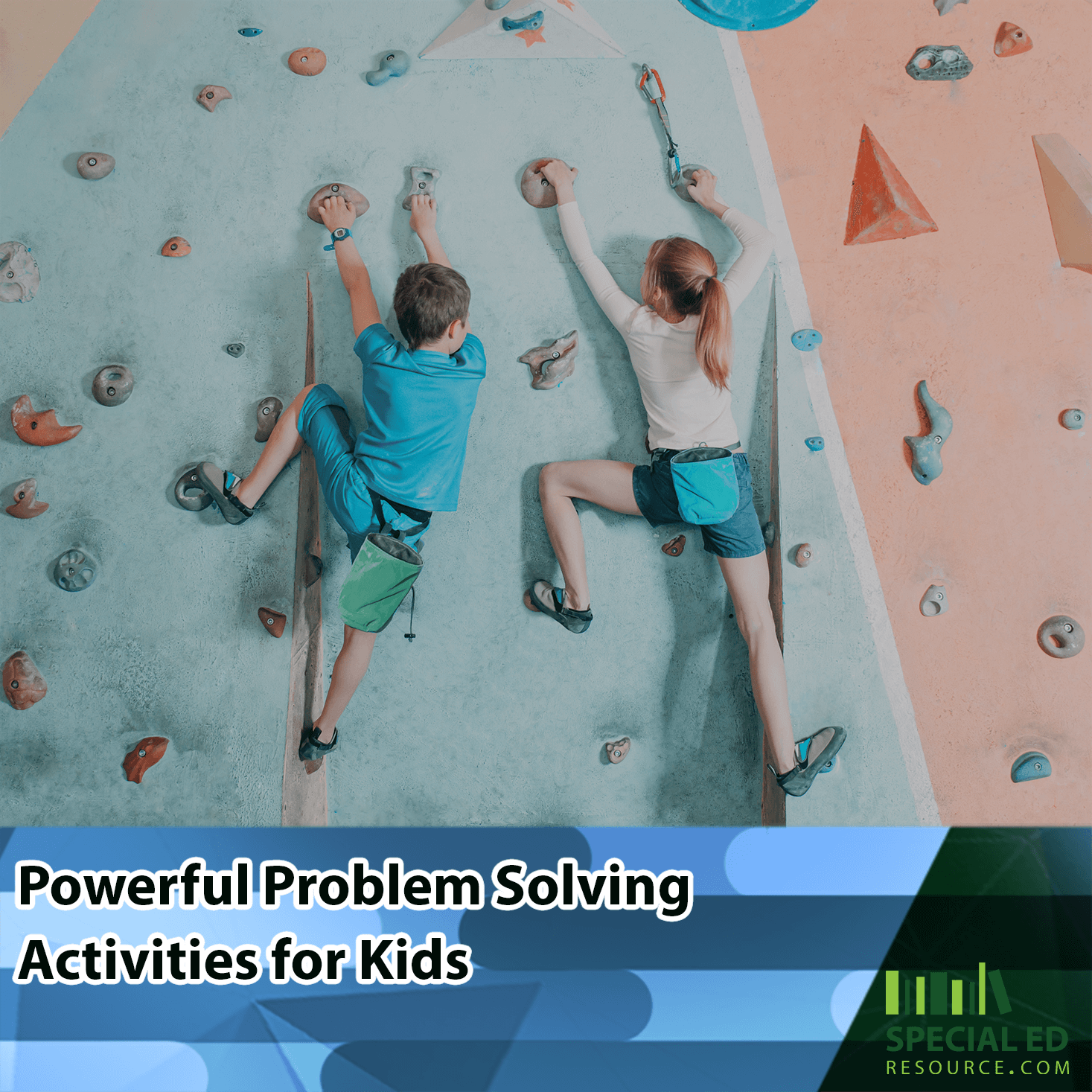
As you navigate the busy aisles of the grocery store, your child’s hand firmly in yours, you’re hit by a sudden realization. You’re not just shopping for groceries; you’re in the midst of an impromptu problem solving class.
Your child, curious and eager, starts asking you questions:
- “Why do we choose this cereal and not that one?”
- “How do we know how many apples to buy?”
In these moments, you’re more than a parent; you’re a guide, helping your child understand and navigate the world. It’s not always easy, especially when your child faces unique challenges.
You know their path is a little different, their learning style distinct. You want to equip them with skills beyond the basics and empower them to tackle the hurdles life throws their way.
Problem solving isn’t just about finding solutions; it’s about building resilience, confidence, and creativity.
You’ve seen it firsthand – the spark of understanding in your child’s eyes, the proud smile when they figure something out. These small victories remind you of the importance of nurturing these skills.
But where do you start? How do you turn everyday moments into enriching learning experiences?
One way is to challenge your children by regularly providing them with problem solving activities. Here is a list of ideas:
Want One-On-One Expert Help?!
Check this out.
#1 Puzzles and Brain Teasers
As you sit beside your child, engaging in a puzzle or brain teaser, you do more than spend quality time together. These activities are key in honing their problem solving skills, which are essential for their growth and development.
Why Puzzles and Brain Teasers Are Beneficial?
– enhances critical thinking: .
Your child learns to approach problems systematically, analyzing and forming strategies.
– Improves Concentration:
These activities require focus, helping your child develop a deeper concentration level.
– Builds Persistence:
Facing challenging puzzles teaches them not to give up easily, fostering resilience.
– Encourages Independent Problem Solving:
As they work through a puzzle, they learn to rely on their skills and intuition, boosting their confidence.
Examples for Different Age Groups
– younger elementary students (5-8 years): .
Start with jigsaw puzzles that have a moderate number of pieces. Simple word puzzles or riddles are also great to stimulate their thinking.
– Older Elementary Students (9-12 years):
Introduce more complex puzzles, like jigsaws with more pieces, logic puzzles, and basic Sudoku. These challenge their thinking and improve logical reasoning.
– Teenagers (13-18 years):
Engage them with advanced puzzles, such as 3D puzzles, crosswords, and challenging brain teasers that require abstract thinking.
When choosing these activities, consider your child’s interests and abilities to keep them motivated and engaged. It’s not about the complexity of the puzzle but the process of finding solutions and the learning that comes with it.
As they tackle these challenges, they’re not just solving puzzles. They’re building skills that will help them navigate the complexities of life.
Role-Playing Games
Envision your child diving into the world of a detective, a scientist, or a historical figure. Through role-playing games, they’re not just engaging in play.
They’re sharpening their problem solving skills imaginatively and dynamically.
Benefits of Role-Playing Scenarios
– fosters creative problem solving: .
Role-playing challenges your child to think on their feet, creating solutions in diverse scenarios.
– Develops Empathy and Social Awareness:
Taking on different roles helps them understand various perspectives, building empathy and social skills.
– Strengthens Communication Abilities:
These activities encourage clear and effective communication , vital for problem solving.
– Tailored to Individual Learning Styles:
Role-playing can be adapted to suit your child’s unique needs and interests, making it an inclusive learning tool.
Role-Playing Ideas
#2 mystery detective: .
Set up a mystery game where your child has to find clues and solve a case. This can be made more complex for older children, involving critical thinking and deductive reasoning.
#3 Historical Role-Play:
Have your child take on the role of a historical figure. They can navigate historical events, making decisions based on the context, which enhances their understanding of history and its challenges.
#4 Science Explorer:
Create scenarios where your child is a scientist or an explorer facing environmental or scientific problems. They can develop innovative solutions, fostering a love for science and exploration.
#5 Future World Builder:
Engage older children and teens in creating and managing a city or civilization in the future. This kind of role-play involves strategic planning, resource management, and ethical decision-making.
When engaging in these activities, the focus should be on learning through experience and fun. Encourage your child’s imagination, validate their ideas, and guide them through the problem solving process.
Remember, role-playing is a powerful tool that can make learning enjoyable and impactful for your child.
Building and Construction Projects
Whether it’s a simple craft project or a more complex construction task, these activities are not just about creating something tangible. They’re about building problem solving skills.
Why Building Activities Enhance Problem Solving?
– encourages practical thinking: .
As your child figures out how to assemble parts, they learn to think logically and sequentially.
– Develops Spatial Awareness:
Understanding how different pieces fit together improves their spatial intelligence.
– Fosters Creativity and Innovation:
They’ll learn to think creatively as they design and build, especially when improvising solutions.
– Teaches Planning and Organization:
Planning out a project helps develop organizational skills and forward-thinking.
Safe and Accessible Building Project Ideas
#6 cardboard creations: .
Use cardboard boxes to build anything from simple houses to intricate castles. This is safe, easy, and allows for endless creativity.
#7 DIY Birdhouse or Insect Hotel:
Older children can take on projects like building a birdhouse or an insect hotel, which involves more planning and precision.
#8 Recycled Material Sculptures:
Encourage your child to create sculptures using recycled materials. This not only sparks creativity but also teaches the value of recycling.
#9 Simple Woodworking Projects:
Consider basic woodworking projects for teenagers, like a small shelf or a picture frame. Ensure supervision and safety measures are in place.
Remember, the goal is to challenge yet not overwhelm. Start with simpler projects and gradually increase complexity based on your child’s interest and skill level.
Encourage their efforts, celebrate their successes, and most importantly, enjoy the process of building and learning together. This is where practical skills meet creativity, leading to effective problem solving.
Technology and Problem Solving Activities
In today’s digital age, apps and games can be much more than distractions; they can be tools for learning and development.
Why Technology Aids Problem Solving?
– interactive learning: .
Digital platforms offer interactive experiences that keep children engaged and actively learning.
– Adaptive Challenges:
Many apps and games adjust their difficulty based on your child’s progress, providing a continuous and appropriate challenge.
– Visual and Auditory Stimulation:
Graphics and sound in digital games enhance cognitive skills and problem solving abilities.
– Accessibility:
Technology can offer tailored learning experiences, especially beneficial for children with special needs.
Recommended Apps and Games
#10 puzzle games: .
Look for puzzle apps that challenge spatial reasoning and logical thinking. Examples include tangram-based games or block-fitting puzzles.
#11 Strategy Games:
Games that require planning and strategy, like turn-based strategy games or resource management simulations, are great for older children.
#12 Coding for Kids:
Introduce basic programming concepts through kid-friendly coding apps. These teach logical thinking and problem solving in a fun, interactive way.
#13 Educational Adventure Games:
Choose adventure games incorporating math, science, or language puzzles within an engaging storyline.
When selecting apps and games, focus on age-appropriate ones, considering your child’s interests and skill levels. The goal is to find digital tools that challenge and educate, not just entertain.
Encourage your child to reflect on what they learn and apply these skills beyond the screen. In this way, technology becomes a valuable ally in developing your child’s problem solving abilities.

#14 Escape Room Games
Visualize your child and their friends (or your family) immersed in the thrilling world of an escape room. This isn’t just an exciting game. It’s a dynamic learning experience where essential skills are developed as they work to solve puzzles and ‘escape.’
Benefits of Escape Room Activities
– teamwork: .
Escape rooms are a fantastic way for kids to learn the value of teamwork. They discover the importance of working together, communicating effectively, and sharing tasks to achieve a common goal.
– Critical Thinking:
These games push children to think outside the box. They must look beyond the obvious, develop creative solutions, and apply critical thinking to overcome challenges.
– Communication:
Effective communication is crucial in escape rooms. Your child learns to express their ideas clearly, listen to others, and collaborate to solve puzzles.
– Problem Solving:
Escape rooms are all about solving a series of puzzles. Kids learn to identify problems, analyze them, and develop creative solutions under pressure.
Creating an Escape Room Experience at Home
– diy home escape room: .
Set up a simple escape room at home. Use clues related to your child’s interests, and create challenging yet solvable puzzles. It can be a simple treasure hunt with clues leading to the next step.
– Escape Room Board Games:
There are board games available that mimic the escape room experience. These are great for rainy days or quiet evenings at home.
– Digital Escape Rooms:
There are also digital escape room experiences, perfect for children who enjoy online gaming. Choose ones that focus on teamwork and problem-solving that are age-appropriate.
Remember, the goal is to challenge and engage your child in a fun, collaborative way.
Through escape room activities, they enjoy an exciting adventure and develop essential life skills that will serve them well academically and personally.
#15 Indoor Rock Climbing
This activity is often overlooked, but it’s an incredible way for children of all ages and abilities to develop many skills beyond physical strength.
Multifaceted Benefits of Indoor Rock Climbing
– problem solving skills: .
As your child figures out the best climbing route, they use critical problem solving skills. Deciding which hold to grab next requires quick thinking and strategy, skills transferable to everyday challenges.
– Coordination:
Rock climbing demands a harmony of movements between hands and feet. This enhances your child’s coordination, a valuable skill in many other aspects of their life.
– Strength Building:
Climbing strengthens not just the arms and legs but the entire body. It’s a full-body workout that improves physical strength and endurance.
– Stamina Development:
Maintaining their position on the wall for an extended period builds stamina. This persistence is mirrored in their ability to stay focused on other activities.
– Focus and Concentration:
Successfully climbing requires complete concentration. Your child learns to focus their mind on the task at hand, a skill that’s invaluable in school and other settings.
– Self-discipline:
Rock climbing teaches self-control and emotional regulation . Staying calm and composed on the wall is essential for safety and success.
– Boosting Confidence:
Each climb is a boost to your child’s self-esteem . Believing in their abilities to reach the top instills a sense of accomplishment and confidence.
Getting Started with Indoor Rock Climbing
– find a kid-friendly facility: .
Look for indoor climbing centers that offer sessions for children. They provide the necessary equipment and guidance in a safe environment.
– Start with Basic Walls:
Begin with walls designed for beginners, gradually moving to more challenging climbs as your child gains confidence and skill.
– Encourage Regular Practice:
Consistency is key. Regular climbing sessions will help your child improve their skills steadily.
Remember, rock climbing is not just about reaching the top; it’s about the journey. Each step your child takes up that wall is a step towards building essential life skills in a fun, engaging, and challenging environment.
#16 Obstacle Courses
Imagine setting up a fun, engaging obstacle course in your backyard or living room. This isn’t just an entertaining activity for your child. It’s a comprehensive learning experience that builds many life skills.
Valuable Life Skills Gained from Obstacle Courses
– teamwork and cooperation: .
Obstacle courses often require collaboration. Your child learns the importance of working together, sharing strategies, and helping peers to achieve common objectives.
Each obstacle presents a unique challenge. Your child learns to think quickly, devise strategies, and find creative solutions to navigate through them.
– Perseverance and Determination:
Obstacle courses can be challenging, teaching your child the value of persistence and grit. They learn to keep trying, even when faced with challenging tasks.
– Large Motor Fitness:
These courses are excellent for enhancing physical fitness, improving strength, balance, and coordination.
– Mental Fitness:
Besides physical agility, obstacle courses sharpen mental skills like focus, concentration, and stamina.
Setting Up a Simple Obstacle Course
– indoor course: .
Use household items like chairs, cushions, and tables to create a safe indoor course. This can include crawling under tables, hopping between cushions, or balancing along a taped line on the floor.
– Outdoor Course:
Use natural elements like trees, hills, or simple items like ropes and hula hoops for outdoor space. Set up tasks like weaving between trees, climbing small hills, or jumping through hoops.
– Incorporate Diverse Activities:
Add variety to your course with activities like throwing a ball into a bucket, balancing a book on the head, or hopping on one foot. This keeps the course dynamic and engaging.
Remember, the primary goal is to have fun while learning. Encourage your child, celebrate their successes, and perhaps even join to model teamwork and sportsmanship.
Through obstacle courses, your child enjoys physical activity and develops crucial life skills in an exciting and hands-on way.
Cooking and Baking Projects
Cooking and baking are not just about creating delicious treats; they’re an excellent way for your child to learn and practice many skills.
Skills Developed Through Cooking and Baking
– math and measurement skills: .
Recipes require measuring ingredients, which is a practical way for your child to learn about fractions, volumes, and weights.
– Reading and Comprehension:
Following a recipe improves reading skills and comprehension. Your child learns to follow instructions and understand the sequence of steps.
– Science and Chemistry:
Cooking is a fun way to introduce basic science concepts. They’ll learn about chemical reactions, like how yeast makes dough rise or how heat changes food.
– Creativity and Experimentation:
Encourage your child to be creative, whether decorating cookies or experimenting with flavors. This fosters their artistic side and teaches them about trial and error.
– Life Skills and Independence:
Cooking and baking are essential life skills. By learning these, your child gains a sense of independence and accomplishment.
Ideas for Cooking and Baking Projects
#17 simple recipes: .
Start with easy recipes like no-bake cookies, fruit salads, or sandwiches. These are perfect for younger children.
#18 Theme Cooking:
Make cooking more engaging by tying it to a theme or a subject they’re learning in school, like baking pies when learning about circles in math.
#19 International Cuisine:
Explore recipes from around the world. This not only introduces new flavors but also teaches about different cultures.
#20 Weekly Cooking Day:
Dedicate one day a week to cook or bake something special with your child. It could be a time to try new recipes or perfect old favorites.
Remember, the kitchen is a fantastic classroom. It’s a place where your child can learn, make mistakes, and enjoy the fruits of their labor! Encourage them, guide them, and most importantly, have fun together in this delicious learning journey.
Incorporating Everyday Situations
As you go about your daily routine with your child, consider the myriad learning opportunities in these simple moments. Everyday tasks, often overlooked, are fertile ground for developing problem solving skills.
Turning Routine Activities into Problem Solving Exercises
#21 grocery shopping: .
Turn a regular shopping trip into a math lesson. Have your child help with making a budget, calculating discounts, or comparing prices. They learn about money management, estimation, and decision-making.
#22 Planning a Route:
If you’re heading out to multiple places, involve your child in planning the route. Discuss factors like distance, time, and traffic. This teaches them about logistics, time management, and geographical orientation.
#23 Organizing Spaces:
Ask your child to think of the best way to organize it, whether it’s their room, a bookshelf, or the living room. This encourages them to think about space utilization, categorization, and orderliness.
#24 Meal Planning:
Involve them in meal planning for the week. They can help decide the menu, ensuring a balance of nutrition. This teaches them about health, planning, and the importance of variety.
#25 DIY Home Projects:
Simple home projects, like planting a garden or painting a fence, can be excellent problem solving exercises. They learn about the process, the necessary materials, and the steps to complete a project.
#26 Time Management:
Encourage your child to plan their day or week, balancing schoolwork, chores, and leisure. This helps them develop critical time management and prioritization skills.
Each of these activities, while mundane, is an opportunity for your child to think critically, make decisions, and solve problems.
The key is actively involving them, asking open-ended questions, and encouraging them to think through their choices.
This way, everyday tasks become more than just chores. They become stepping stones in your child’s developmental journey.
Tips for Success
As you embark on these activities with your child, keeping them engaged and motivated is crucial. Here are some practical tips:
Keeping Children Engaged and Motivated
– set achievable goals: .
Start with simple tasks and gradually increase the difficulty. Achieving these smaller goals will boost your child’s confidence and motivation.
– Incorporate Their Interests:
Tailor activities to include your child’s hobbies or favorite subjects. This personal connection makes learning more exciting and relatable.
– Offer Positive Reinforcement:
Praise their efforts, not just the outcomes. Celebrate their progress and perseverance, which encourages a growth mindset .
– Create a Routine:
Establishing a consistent activity schedule helps build discipline and a sense of anticipation.
– Provide Choices:
Give your child options in activities or ways to complete them. This sense of control can be very motivating.
– Break Down Tasks:
For complex activities, break them into smaller, manageable steps. This makes the task more manageable and more approachable.
Adapting Activities for Children with Special Needs
– simplify instructions: .
Use clear, concise language and visual aids if necessary. Breaking instructions into smaller steps can be very helpful.
– Flexible Approach:
Be open to adapting activities based on your child’s needs. This could mean altering the pace, reducing sensory inputs , or providing additional support.
– Incorporate Sensory Activities:
For children who benefit from sensory input, include activities that engage different senses .
– Use Assistive Technology:
For children with physical or learning disabilities, utilize available technology to facilitate their participation and learning.
– Foster a Safe Environment:
Ensure the learning environment is safe, supportive, and free from unnecessary pressures or distractions.
– Collaborate with Educators and Therapists:
Work with your child’s teachers or therapists to align activities with their educational and therapeutic goals.
Remember, being patient, adaptable, and responsive to your child’s needs and responses is vital. Your support and encouragement can make a significant difference in their learning journey.
As you step into this journey of enriching your child’s learning through these diverse activities, remember that each moment spent together is about achieving a goal and creating lasting memories and invaluable learning experiences.
Your role in guiding and supporting your child through these activities is a powerful force in their development.
We would love to hear about your adventures and discoveries. Share your stories with us in the comments below!
Whether it’s the proud smile of your child solving a puzzle, the excitement of completing a DIY project, or the laughter that fills your kitchen during a cooking session, your experiences can inspire and encourage other parents embarking on similar journeys.
Additional Resources for Learning
- 29 Fun Activities to Help Kids Focus (With Proven Results)
- Fun Winter Break Activities for Kids Guaranteed to Bust Boredom
- 21 Simple & Fun Gratitude Activities for Kids
- The Ultimate Guide to Summer Learning Activities (Your Child Will Love)
If you enjoyed this article, please consider sharing it on Pinterest and Facebook. Join our Special Ed Parenting Facebook Community to connect with other parents of special needs children.
Do you have a child that needs one on one assistance?
We offer one-on-one special education tutoring that can be done from anywhere the student is! Why? Because our special education experts conduct their sessions online!
Get started with a free consultation today!
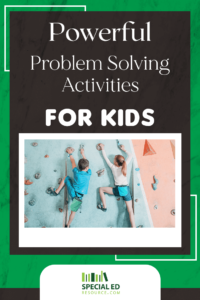
Shannah Holt
Leave a reply cancel reply.
Your email address will not be published. Required fields are marked *
Name *
Email *
Add Comment *
Save my name, email, and website in this browser for the next time I comment.
Post Comment
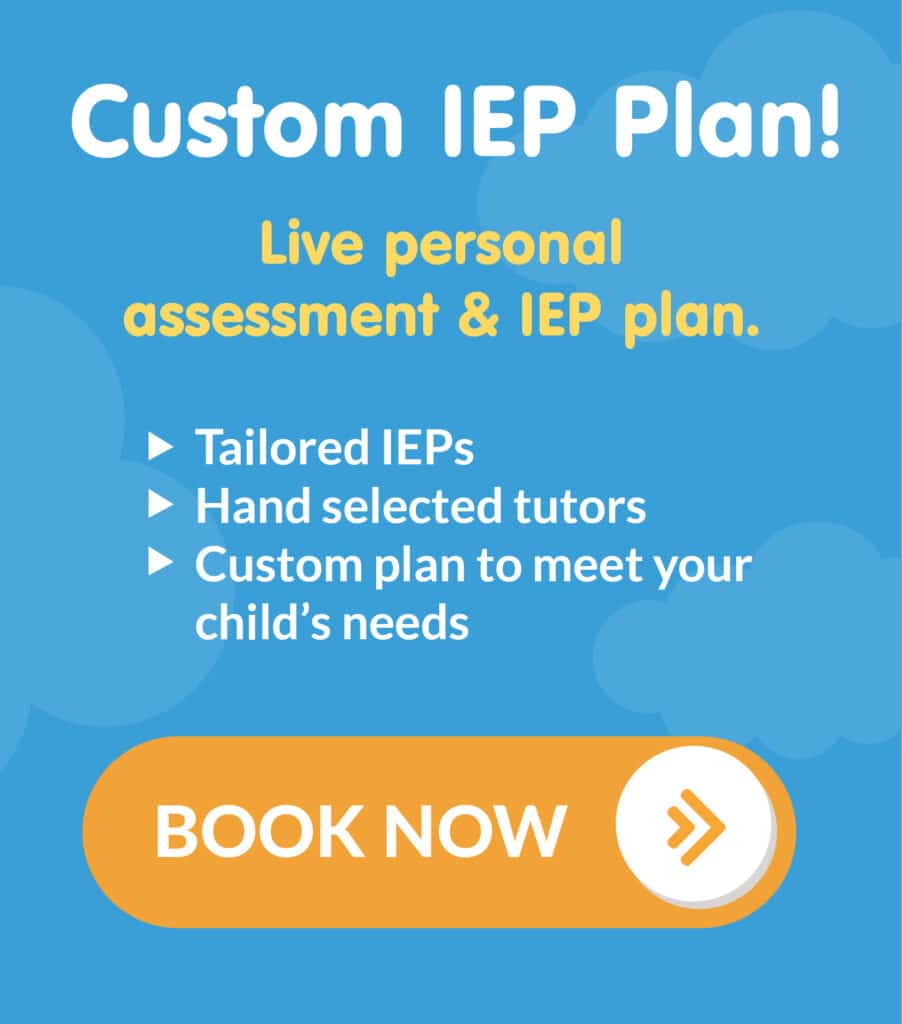
Our Services
- Special Education Tutoring
- IEP Consulting
- Special Needs Advocacy
- Home Schooling

Popular Articles
7 step iep process.
- Creative Writing Activities
- Activities to Help Kids Focus
- Self-Contained Classroom Defined
- 10 Benefits of Special Needs Tutoring
- What is Visual Processing Disorder in Children
- 51 Executive Functioning Activities for Teens
- What is Cognitive Behavioral Therapy for Children?
- Classroom Accommodations for Executive Function Disorder
- 45 Executive Functioning Activities for Kids 5-12
- What is Nonverbal Learning Disorder (Signs of NVLD)
Think Differently About Education. We Believe…
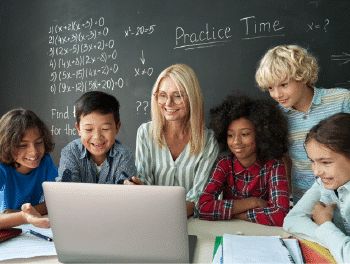
We assess your child’s learning style, personality, and interests to pair them with the ideal special ed tutor based on their individual needs.

Through technology and one on one learning, their future path to success can be made clear again.
Are you ready to see confident progress in your child?
Get started with a no-obligation consultation today!

There are hundreds of resources found on our website, SpecialEdResource.com, and on our YouTube channel that were created to help parents JUST LIKE YOU understand the cryptic language of special education.
Important Links
Copyright © 2024 SpecialEd Resource – Design by DeskTeam36 0
- Terms & Conditions
- Privacy Policy

20 Awesome Problem-Solving Activities for Kids
Kids are natural problem solvers. But if you don’t help them to cultivate this skill, it will become harder for them to solve problems as they grow older. According to Marlborough , problem-solving is undoubtedly one of the most critical skills that children need to develop. And they learn best by trying things out and exploring their environment. As parents, it is our job to foster this natural curiosity and help our children develop the skills they need to solve problems effectively. This blog post will share 20 fun problem-solving activities for kids ! These activities will help your child develop critical thinking skills, creativity, and perseverance.

20. Scavenger Hunt
One of the best ways to encourage problem-solving is to set up a scavenger hunt. According to Scholastic , scavenger hunts have a myriad of benefits. It is an activity that can be done indoors or outdoors, depending on your preference. You can hide clues around the house or backyard and have your child solve them to find the next clue. Your kids will have to think outside the box to solve the clues, and they will have a blast doing it. If you want to make the scavenger hunt more challenging, you can give your child a list of items to find instead of clues.
19. Jigsaw Puzzles
Sometimes the simplest ideas help sharpen your child’s problem-solving skills the most. Jigsaw puzzles are a great way to do just that. These puzzles are available for children of all ages. However, their complexity varies. You can start with a simple puzzle with just a few pieces for younger children. And as they get better at it, you can gradually increase the number of pieces. The key is finding a challenging but not too difficult puzzle for your child. As your kids learn to solve them, they’ll also develop incredible problem-solving skills.
18. Treasure Map
Another fun problem-solving activity for kids is to create a treasure map. This great activity is ideal for kids who love to explore. You can create a simple map with clues leading to a treasure. The ultimate goal is to encourage your kids to use problem-solving skills to navigate the map and find the treasure. While at their critical thinking skills will undoubtedly improve.
17. Obstacle Course
An obstacle course is a great way to encourage problem-solving and physical activity. You can create an obstacle course using everyday objects. For example, you can use chairs, cushions, and blankets to create a course in your living room. Or you can use cones and balls to create an outdoor course. The key is to be creative and have fun with it. As your child navigates the course, they must consider the best approach to overcome each obstacle. And this will help them develop critical thinking and problem-solving skills. It is also great to get your child moving and burn off some energy.
16. Building Towers
Most kids love to build something using different items. According to Raisingchildren , building blocks impart critical skills in kids. For this reason, building towers is an excellent problem-solving activity for kids. It helps them use their imagination and be creative. You can give your child different materials to build a tower, such as blocks, Lego, or even toilet paper rolls. The taller the tower, the better. This activity will help your child develop problem-solving skills as they learn how to balance the materials to create a stable structure.
15. Card Mix Up Games
Cards are versatile playthings that offer many opportunities for problem-solving fun. For example, you can play the classic card game Solitaire. Such a game demands patience, strategic thinking, and problem-solving skills. You can also try a memory game using cards. It is an effective way to improve your child’s memory, as well as their problem-solving skills. Many other card games offer a challenge and help kids sharpen their problem-solving skills. So, next time you are looking for a fun activity for your kids, consider playing a card game.
14. Board Games
Board games are quite challenging and stimulating for the brain. They help develop decision-making, strategizing, and critical thinking skills in children. But most importantly, board games are available in a wide range of difficulty levels. So, you can find the perfect game to match your child’s skills and abilities. Checkers, chess, and backgammon are excellent board games that help kids develop problem-solving skills.
13. Science Experiments
Science experiments are another option for problem-solving activities for kids. It helps them learn about cause and effect. And it also allows them to be creative as they try to figure out how to make the experiment work. There are a variety of simple science experiments that you can do at home with your kids. For example, you can try the classic baking soda and vinegar experiment. Or you can try the popular Mentos and Diet Coke experiment. These are just two of many possibilities. However, these activities may not be the best for younger children, as they might not understand what is happening.
I spy is an exciting and challenging activity. And for this reason, it is a perfect problem-solving activity for kids. It helps them improve their observation skills and learn to pay attention to detail. I spy also great for developing memory skills. To play, you will need to choose an object in the room. Then, give your child clues about the object until they can identify it. For example, you might say, I spy with my little eye something red and round. The clues should get progressively harder as the game goes on. This will help to keep your child engaged and challenged. The best part is that kids can play this game anywhere. All you need is your eyes and some objects. The game’s objective is to find an item the other person is thinking of.
11. What’s Missing?
What’s missing is a fun and simple game that most kids enjoy. To play it, you can start by putting a bunch of objects on a tray or in a box. Then, please have your child close their eyes while you remove one of the objects. When they open their eyes, they must use their problem-solving skills to determine which object is missing. As you can see, this activity keeps kids on their toes. And it helps them refine their problem-solving skills as they learn to pay attention to detail.
10. Simon Says
Simon Says is a classic game that most people know. But if you have never played it before, it is simple. One person is Simon, and the other players must do what Simon says. For example, Simon might say, Touch your nose. The other players would then have to touch their noses. However, if Simon does not say the word Simon before the command, the players do not have to do it. According to Emergepediatrictherapy , other Simon’s benefits include motor and sequences skills.
9. Memory Games
Memory games are excellent activities to nurture your kid’s problem-solving skills. A memory game requires players to remember where certain items are and then retrieve them. Depending on your child’s ability, these types of games can be simple or complex. You want to consider your child’s age as you decide their best difficulty level. Once you identify the level of difficulty, you can start the game. The game’s objective is to remember where the objects are and then find them. You can offer a reward for the child who can find the most items.
8. Move an Object
Moving an Object may sound like the most straightforward activity for kids. However, it is an invaluable problem-solving training tool. You ask your kids to move something. It could be a toy, a chair, or even themselves. But there’s a catch. Give them restrictions on how to move the object. For example, you might say, You can only use your left hand, or You have to move it without touching it. These restrictions force kids to think outside the box and create creative solutions.
7. The Alphabet Game
The Alphabet Game is an incredible tool to help kids learn and refine their problem-solving skills. To play, you will need a list of items that start with each letter of the alphabet. So, how does it work? Well, you can either give your child a list of things, or they can make their own. Once they have the list, they have to find an object that starts with each letter of the alphabet. For example, if their list includes A for apple, they would need to find an apple. This game can be played alone or with a group of people. And it can be as easy or difficult as you make it. If you want to make it more challenging, you can give your child a time limit to find the objects.
6. Role Play with Prompt
Role play with a prompt is a challenging activity that requires kids to use their problem-solving skills. To play, you will need a list of prompts. These can be anything from What would you do if you were stuck in a room with a lion? To What would you do if your best friend was moving away? The key is to choose open-ended prompts that allow for multiple solutions. Once you have your list of prompts, give each child a turn to choose one. Then, they will have to role-play the situation. This activity is superb for shy or introverted kids because it allows them to solve their problems safely and in a controlled environment.
Whether on paper or in a digital format, mazes are excellent problem-solving activities for kids. Mazes require players to find their way from start to finish without getting lost. To make it more challenging, you can add obstacles or time limits. Although mazes can be played alone, they are also ideal for groups. When played in a group, mazes require kids to communicate and work together to find a solution. They provide a superb opportunity to problem solve.
4. Free Play
Free play is an important problem-solving activity for kids. It allows them to explore their environment and find creative solutions to problems. Free play can be anything from playing with blocks to exploring the backyard. The key is to let kids direct their play. They will attempt to do many different things in the process, and some will fail. But that is okay. Failure is an important part of the learning process. Free play allows kids to try new things, make mistakes, and learn from them. According to Unicef , free play promotes imagination and creativity among kids.
Crafts are wonderful for problem-solving. And kids love them. They want to try different types of crafts and all times. So, how can crafts help kids with problem-solving? Well, first of all, they require kids to think about what they are doing. They have to plan and execute their craft project. As different challenges arise, they must figure them out and achieve their objectives. Secondly, crafts often involve following instructions. This is another excellent opportunity for kids to practice their problem-solving skills.
2. Reading Story Books
Most storybooks are thoughtfully written for entertainment and fun. They are also known to subtly impart moral and social values to children through the various characters in the story. However, storybooks can also be used as problem-solving activities for kids. They often present the main characters with a problem they must solve. As children read along, they will have to think about it. Look for stories with characters who face challenges and have to figure out solutions. As you read, discuss the characters’ different options and what might happen if they choose each. It will help kids understand that there are often multiple ways to solve a problem.
1 . Penny Drop Challenge
The Penny Drop Challenge is one of the kids’ most challenging and fun problem-solving activities. It requires them to use their logic and reasoning skills to figure out how to drop a penny into a glass without touching the sides of the glass. The game is also quite competitive, which makes it even more exciting. You will need a clear glass, a piece of paper, and a penny to play. Fold the paper into a funnel and place it over the top of the glass. Then, drop the penny into the funnel. The game’s objective is to get the penny into the glass without touching the sides. And children have to be skillful and quick to figure it out.
We must foster problem-solving skills in our children. These 20 awesome problem-solving activities for kids are the perfect way to do it. They will feel a sense of accomplishment and build confidence in their abilities. Choose one or two activities to implement today and watch your child’s problem-solving skills soar.

Janine is passionate about parenting. As a mother of 5 she knows a thing or two about how to raise children. She has a love for food, travel, and making sure her children stay on the right path.
Similar Posts

Back to School Placemat Printable Activity for Kids
This fun back to school placemat is a great way to get kids exciting about the upcoming school year. It’s a fun back to school printable activity that kids will love working on before they…

Best Playdough Recipes and Play Doh Activities for Kids
Today, I want to share some of the best playdough recipes and playdough activities with you. This weekend we have a little one coming to visit and one of the things she wants to do…

10 Awesome Purim Activities for Kids
If you are Jewish, you are already familiar with Purim. For those unfamiliar with Purim, it is a Jewish festival held on the 14th day of Adar. Adar is the twelfth month of the Jewish…

10 Awesome Day of the Dead Activities for Kids
Have you asked your kid what the Day of the Dead is? They may fumble in explaining but worry no more because we are about to explain it to you. In Spanish, the Day of…
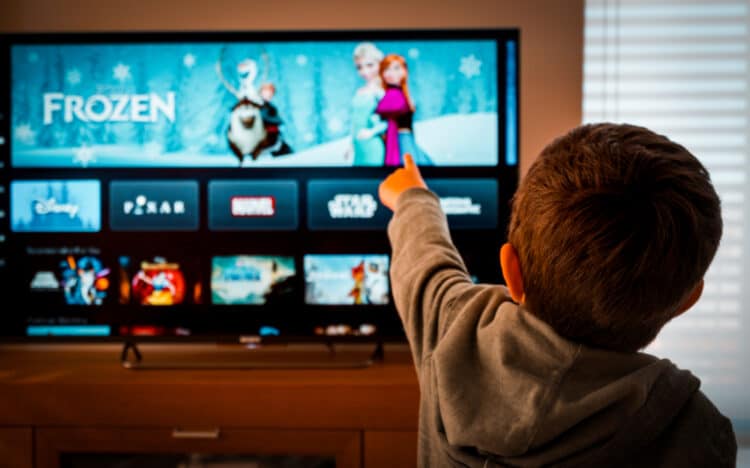
20 Amazing Disney Activities for Kids
There are very few children who do not enjoy watching Disney television series, cartoons, and films. Most have a favorite Disney film, series, or character, and many also love the accessories and toys associated with…

10 Safe and Fun Snow Activities for Kids
Who doesn’t like the idea of playing in the snow? Even those of you who typically prefer the heat are probably ready for some good snow activities after a long summer. That’s never more true…
Common Sense Media
Movie & TV reviews for parents
- For Parents
- For Educators
- Our Work and Impact
Or browse by category:
- Get the app
- Movie Reviews
- Best Movie Lists
- Best Movies on Netflix, Disney+, and More
Common Sense Selections for Movies

50 Modern Movies All Kids Should Watch Before They're 12

- Best TV Lists
- Best TV Shows on Netflix, Disney+, and More
- Common Sense Selections for TV
- Video Reviews of TV Shows

Best Kids' Shows on Disney+

Best Kids' TV Shows on Netflix
- Book Reviews
- Best Book Lists
- Common Sense Selections for Books

8 Tips for Getting Kids Hooked on Books

50 Books All Kids Should Read Before They're 12
- Game Reviews
- Best Game Lists
Common Sense Selections for Games
- Video Reviews of Games

Nintendo Switch Games for Family Fun

- Podcast Reviews
- Best Podcast Lists
Common Sense Selections for Podcasts

Parents' Guide to Podcasts

- App Reviews
- Best App Lists

Social Networking for Teens

Gun-Free Action Game Apps

Reviews for AI Apps and Tools
- YouTube Channel Reviews
- YouTube Kids Channels by Topic

Parents' Ultimate Guide to YouTube Kids

YouTube Kids Channels for Gamers
- Preschoolers (2-4)
- Little Kids (5-7)
- Big Kids (8-9)
- Pre-Teens (10-12)
- Teens (13+)
- Screen Time
- Social Media
- Online Safety
- Identity and Community

Real-Life Heroes on YouTube for Tweens and Teens
- Family Tech Planners
- Digital Skills
- All Articles
- Latino Culture
- Black Voices
- Asian Stories
- Native Narratives
- LGBTQ+ Pride
- Best of Diverse Representation List

Celebrating Black History Month

Movies and TV Shows with Arab Leads

Celebrate Hip-Hop's 50th Anniversary
"best of" lists.
Get age-appropriate ideas and inspiration for every interest:
- Best Movies for Kids
- Best TV for Kids
- Best Streaming Picks for Kids
- Best Games for Kids
- Best Apps for Kids
- Best Books for Kids
- Best Podcasts for Kids
- Best Websites for Kids
- Best for Character Development for Kids
- Best for Diversity for Kids
- Best for Learning for Kids
Games That Help Kids Think Critically
When gamers pick up a controller, they're frequently placed in the role of the hero or the protagonist that always wins. But that doesn't always challenge them to think critically or examine all sides of a situation rationally. In fact, what can help some incredible games and apps stand out from other titles is that they don't simply ask kids for RIGHT or WRONG answers. Instead, they encourage them to experiment and consider the shades of gray in problems. Players interested in testing their emotional responses may want to check out our list of the Best Empathy Games, Apps, and Websites as well.

Tozzle - Toddler's favorite puzzle
Drag-and-drop shape puzzles made especially for toddlers.

Montessori Geometry - Recognize and learn shapes
Amazing starter geometry app is fun and comprehensive.

BoxBoy! + BoxGirl!
Think outside the box with this charming, fun puzzler.

Solve and create puzzles that gush with STEM learning.

Super Mario Maker 2
Fun, accessible editing tools expose kids to game design.

The Last Campfire
Utterly charming, brilliantly made puzzle game.

Mass transit simulator is simple, marvelous, hard to master.

Mystery Math Town
Great math practice with fun story, entertaining characters.
Savings Spree
Kids learn financial literacy through game-show action.

Co-op puzzler is violence-free and promotes teamwork.

BrainPOP Featured Movie
Daily films from educational group provide tons of learning.

Clubhouse Games: 51 Worldwide Classics
Collection of classics promotes friendly social experiences.

Office-themed puzzler rewards creative and logical thinking.

Lumines Remastered
Classic puzzle game buzzes with new immersive play feature.

Maggie's Earth Adventures
Save the planet with these terrific learning activities.

Fun co-op sim is appropriate for all ages, skill levels.

Clever pinball-esque puzzler has a bit of mild combat.

The Path of Motus
Adventure tackles bullying with positivity and mild combat.

Untitled Goose Game
Don't let your goose get cooked in feathered fun puzzler.

Journey to explore big questions only gets you so far.
Other great lists from our editors
- Learning Tools for Out-of-the-Box Thinkers
- Apps and Websites with Lots of Problem-Solving
- Free Educational Apps, Games, and Websites
- Here's the Secret to Raising a Safe, Smart Kid
- How to Raise a Lifelong Learner
Thinkrolls 1: Puzzles for Kids 4+
Logic game for kids & toddlers.
- 4.5 • 14.3K Ratings
Screenshots
Description.
Boost your child's brain power and intelligence! Thinkrolls is an award-winning logic puzzle game that helps young kids develop reasoning and problem solving skills through a delightful and engaging gameplay. Get it now and let your little geniuses amaze you with their mental abilities and logic skills! ________________________________ ** Featured 'Best New App' on the App Store's Home Page in more than 70 countries ** ** Ranked #2 in US App Store, Education category ** • Parents’ Choice Award Winner • Named one of the "10 Top Kids Apps of 2014" by USA Today! • "Adorable physics platformer creates little problem-solvers." - Top Pick by Common Sense Media • "Thinkrolls has actually become a family affair...I enthusiastically recommend it." - 148 Apps • "Another smash hit by these ingenious and award winning developers." - Teachers With Apps • Editors' Choice by Children's Technology Review & Tech With Kids ________________________________ THE MISSION Have a blast navigating your Thinkrolls through a series of obstacles in brightly patterned mazes. The goal is to solve the puzzles and roll through the end of the maze where a new Thinkroll waits to be unlocked and lead the next quest! HOW TO PLAY The app offers 207 clever puzzle levels filled with fun science concepts. Seven playful elements with unique physical properties are gradually introduced. Kids will discover through hands-on manipulation how to use these objects to their advantage and clear a path. • Cookies • Munch them to clear a path or resist those treats to avoid getting trapped! • Crates • Push them to fill gaps or stack them to reach higher ground. • Balloons • Burst them on spikes to get them out of your way. • Rocks • Get a crash course in Newtonian physics by dropping heavy, dense boulders to break through cracked ground. • Jelly • Bounce Thinkrolls and objects on springy jellies to launch them up. • Fire • Use ice blocks to put out the fire and safely pass through. • Elevators • Timing is added to the mix! Synchronize movements of two different elevators to navigate through the maze. MASTER THE ART OF THINKING Little players will master the art of thinking while using to their advantage force, acceleration, buoyancy, heat, elasticity and gravity to reach the end of the maze. The puzzles gradually build upon successive science lessons to strengthen observation, creative thinking, logic, problem solving, spatial cognition and memory. There are unlimited tries and no penalties. Thinkrolls not only challenges the brain but also develops and rewards patience and perseverance. As kids try different combinations to achieve their goal, they intuitively learn through trial and error what works. They must think ahead, use precise timing and rely on their memory to reunite their Thinkroll buddies. ________________________________ MAIN FEATURES • 207 levels with mind-sharpening puzzles • Easy mode for ages 3-5, hard mode for ages 5-8 • Hands-on physics lessons • Experiment with gravity, heat, buoyancy, speed, elasticity, friction and other science concepts • Enhance logic, spatial cognition, problem solving, memory, perseverance • 26 hilarious, super smart characters to play with • Fun brain training for the whole family • Track progress for up to 9 player profiles • Supreme design and beautiful artwork • Original soundtrack and sound design • Language neutral game-play • COPPA compliant, no 3rd party ads, no in-app purchases More info: avokiddo.com ________________________________ PRIVACY POLICY We respect your privacy! We do not collect, store, or share any personal information or location data. Our apps do not contain third-party ads and are safe for young children. Read our privacy policy here: http://avokiddo.com/privacy-policy.
Version 1.7
Minor improvements
Ratings and Reviews
14.3K Ratings
Lost cereal case
I told the Thinkrolls to be mindful of their cereal they can trail. They forgot, and it looks like lots forgot. They will avoid certain things using cookies, grates, balloons, rocks, jellies, fire and ice, elevators and then all at once. This could take to the next day, later they might be doing this at night and they’ve never done before, but they’re in luck because they will use different things. Good luck finding blue, pink, red, black, orange, hazel.
My three and a half year old dove right into this game and needed almost no instruction. The game is intuitive, beautifully designed, and artfully executed. He now has the full suite and is working his way through the hard levels. I’m so impressed by how quickly he processes logical puzzles, and the games are so fun that he doesn’t realise he’s putting in some pretty serious mental gymnastic work. Thanks for these beautifully done apps!
Developer Response ,
Thank you so much for your wonderful review!
In thinkrolls you Chase after like other people but not real people like their people that roll and it’s really interesting if you think about it it’s called Thinkrolls because you have to like in chapters you have to like figure out what to do when you have stuff like if you have any like hard stuff it would be a good app to help your thinking
App Privacy
The developer, AVOKIDDO , indicated that the app’s privacy practices may include handling of data as described below. For more information, see the developer’s privacy policy .
Data Not Collected
The developer does not collect any data from this app.
Privacy practices may vary, for example, based on the features you use or your age. Learn More
Information
English, Dutch, French, German, Hindi, Italian, Japanese, Korean, Malay, Portuguese, Russian, Simplified Chinese, Spanish, Swedish, Thai
- Developer Website
- App Support
- Privacy Policy

Family Sharing
Up to six family members can use this app with family sharing enabled., more by this developer.
Thinkrolls: Games for Kids 2-8
Thinkrolls Kings & Queens
Thinkrolls 2: Puzzles For Kids
Beck and Bo - Toddler Puzzles
Thinkrolls Kings & Queens Full
You Might Also Like
Creature Garden by Tinybop
Pre K Preschool Learning Games
Inventioneers Full Version
Math Bridges School: Fun Games
The Robot Factory by Tinybop
Lil Artist - Kids Learning App

These Kid-Friendly Coding Games Will Teach Your Little Ones How to Code in No Time
Posted: June 2, 2024 | Last updated: June 2, 2024
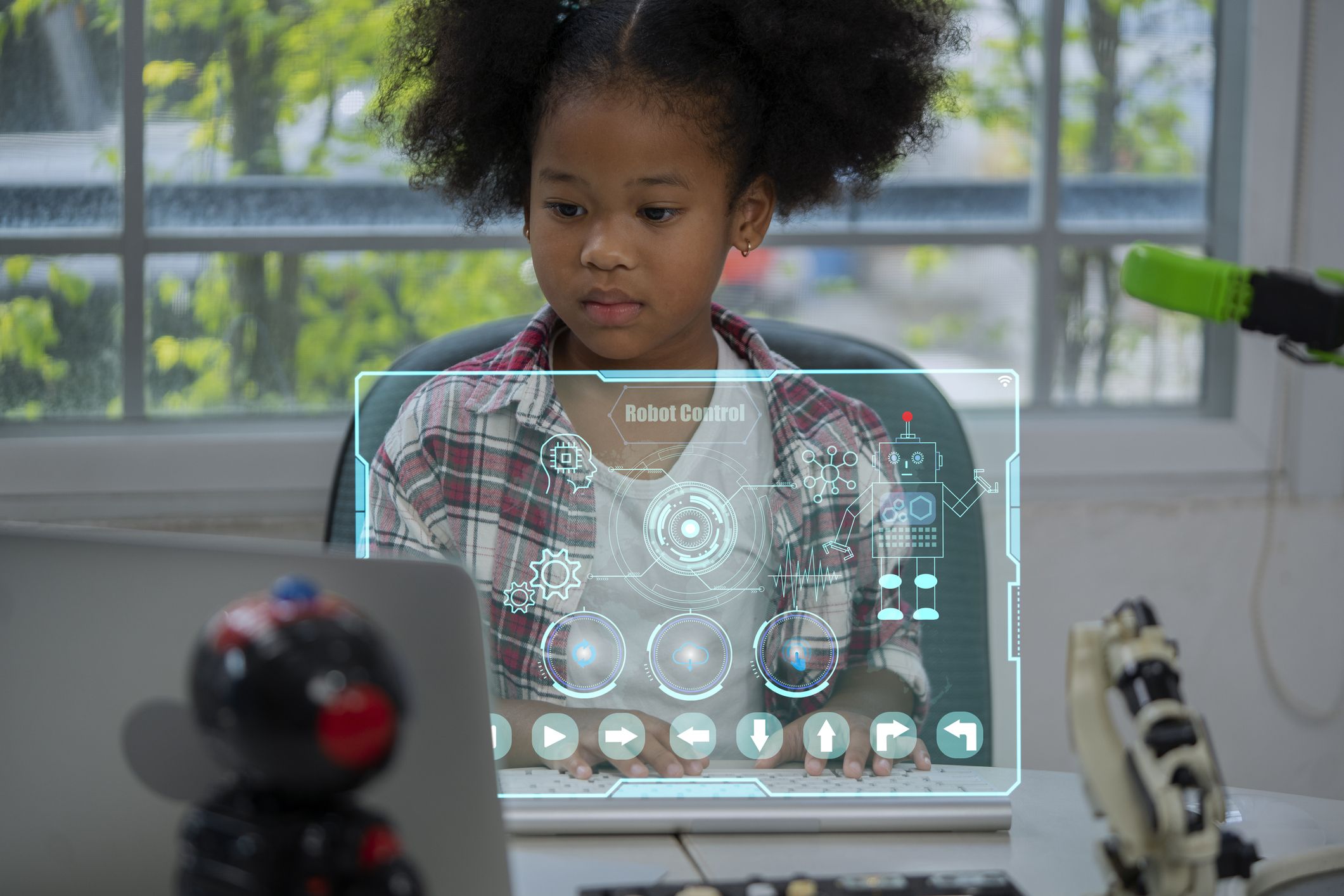
If you're a parent, then chances are you've heard endless debates about how screen time affects children. And while it's always a good idea to encourage your kids to put down their phones, tablets, and laptops in order to get some fresh air, there's nothing wrong with giving your children some screen time — especially if they're learning something with their devices . Looking for some educational online games that your kids will actually enjoy? Then you'll want to check out the best coding websites and games for kids , which can nurture everything from problem-solving skills to critical thinking to creativity.
Learning to code has many benefits that can help kids out later in life, too. In addition to being a skill that's highly valued in the workforce, coding teaches people how to work more efficiently and logically. As Steve Jobs once said, "Everyone in this country should learn how to program a computer, because it teaches you how to think." Of course, it might help to know a little bit more about coding and its benefits before you get your children started (and no, teaching your kid to code doesn't mean you expect them to become the next Steve Jobs). Here's what you should know about coding programs for kids:
What is coding, in simple terms?
Simply put, coding is telling a computer or machine how to perform a task. As a rep from Raspberry Pi Foundation explains, "Coding is one aspect of digital making. When you write code, you are writing instructions for a computer to follow." As complex as they may seem, computers are actually simple devices, so that's why you have to give them really simple instructions that you then build into a complex set of rules. And learning how to provide those instructions isn't just helpful for computers — it challenges programmers to communicate with computers in a way that makes sense.
Why is coding good for kids?
Teaching your kid how to code won't just make them a computer whiz — it will teach them plenty of other valuable skills as well. "When young people are given opportunities to learn and create with code, they can do incredible things, from expressing themselves creatively, to highlighting real-world issues or controlling a robot," the Raspberry Pi Foundation rep says. "Coding also helps develop young people's resilience and problem-solving skills, as debugging is a key part of the process to ensure their code works correctly." Yes, they may get frustrated at times, but it's all part of the process!
At what age can a child start coding?
Just like when learning a new language, it's both better and easier to learn coding skills from a young age. "There is research into children being able to learn aspects of coding from the age of three, as well as during kindergarten and early elementary school," the Raspberry Pi Foundation rep explains. "Younger children typically learn coding by programming graphical symbols. Then they move on to block-based coding and text-based coding." Start by introducing your child to a simple game, and then work up to more complex games as they develop their skills.
The best coding games and programs for kids
If you're looking to get your kid interesting in coding, then coding websites and games are the best way to do it. Not sure where to get started? Start with our list of the best kid-friendly coding websites and games, many of which your children can play for free.
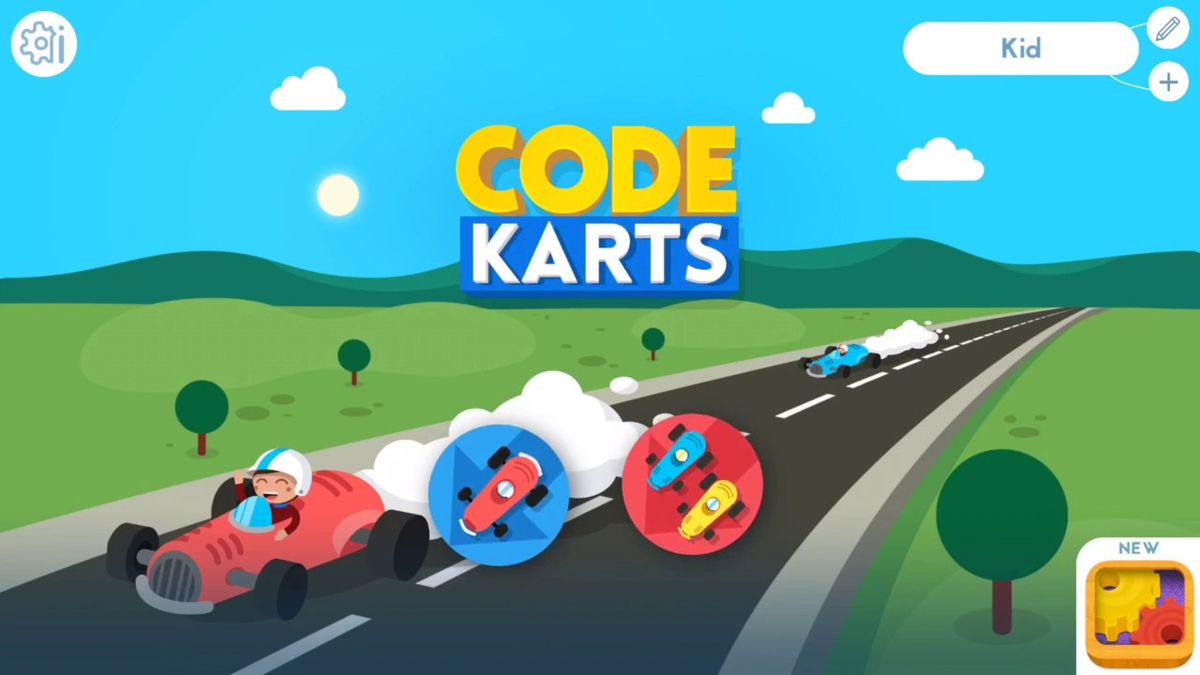
1) Code Karts
- Platform: iOS, Android, Kindle Fire
- Pricing: Free
- Age range: 4 and up
Think your preschooler is too young to learn coding? Think again. Code Karts makes coding for kids as young as four years old possible, using racetrack-themed logical puzzles and over 70 different levels (as well as two different game modes).
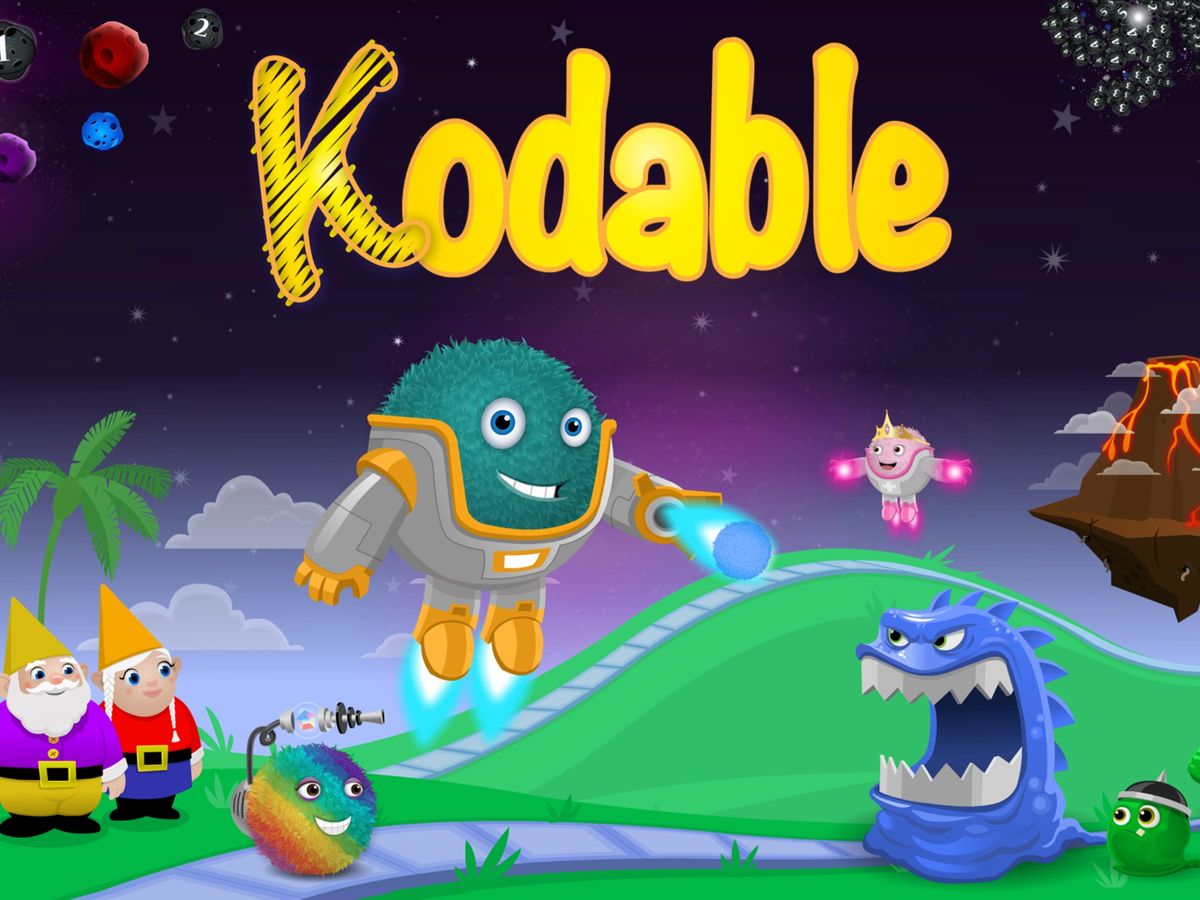
- Platform: Browser, iOS
- Pricing: Free to start, with plans starting at $4.99/month
- Age range: 4 to 10
With interactive games and over 70 different lessons, Kodable manages to break down computer science topics into basic concepts that kids as young as four years old can understand. Kodable also allows users to unlock new avatars as they advance through levels to keep 'em incentivized.

3) ScratchJr
- Age range: 5 to 7
Perfect for young learners, ScratchJr is introductory programming language that lets kids create their own interactive stories and games. By programming blocks and animating their characters, users are exposed to new math and language concepts, as well as the building blocks of programming.
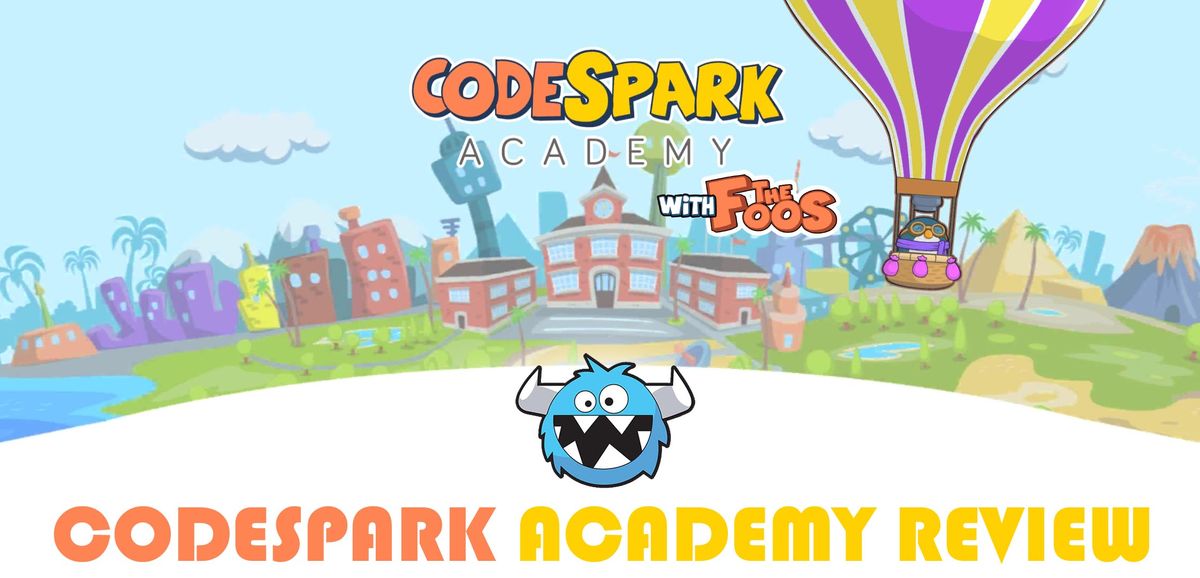
4) codeSpark Academy
- Platform: Browser, iOS, Android, Kindle Fire
- Pricing: Free to start, with plans starting at $5.56/month
- Age range: 5 to 9
Developed by research from MIT, Princeton, and Carnegie Mellon, codeSpark Academy teaches all of the fundamentals of computer programming through daily activities, puzzles, and games personalized for your child's skill level. Best of all, new content is released monthly, so your kids will never get bored.
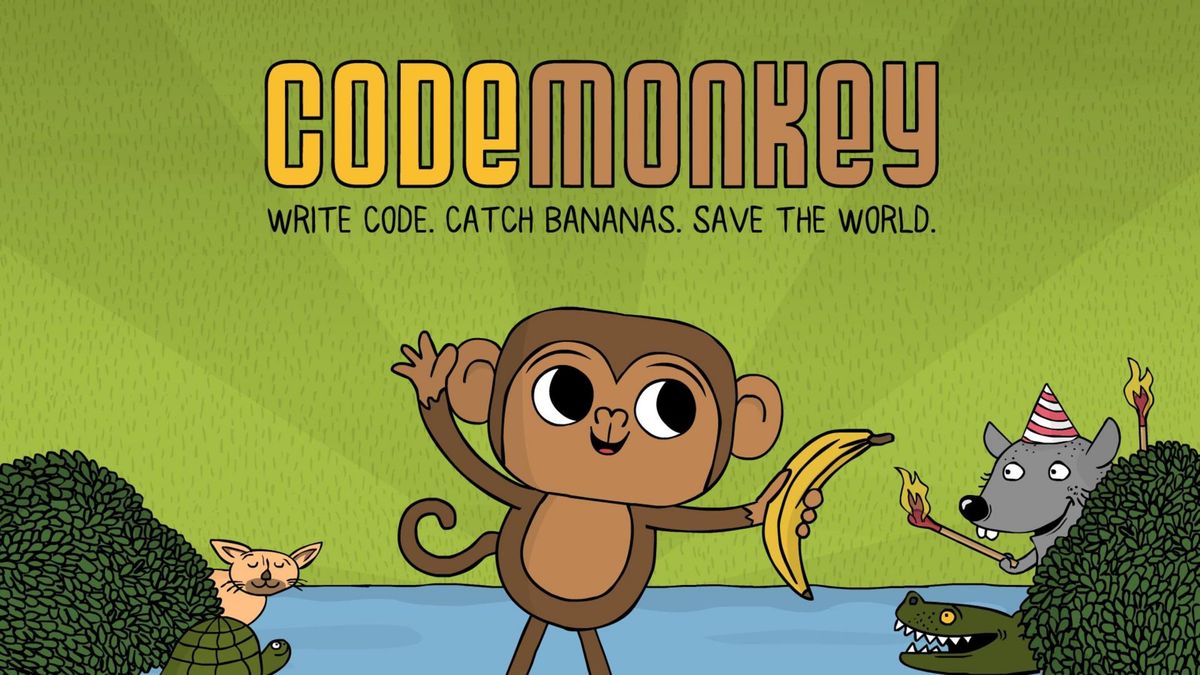
5) CodeMonkey
- Platform: Browser
- Pricing: Free to start, with plans starting at $6/month
- Age range: 5 to 13
Another great option for little ones, CodeMonkey is an online community that helps kid with no prior experience learn how to code. Children will love the game-based education, and parents will love how CodeMonkey allows you to monitor your child’s progress as they develop new skills.
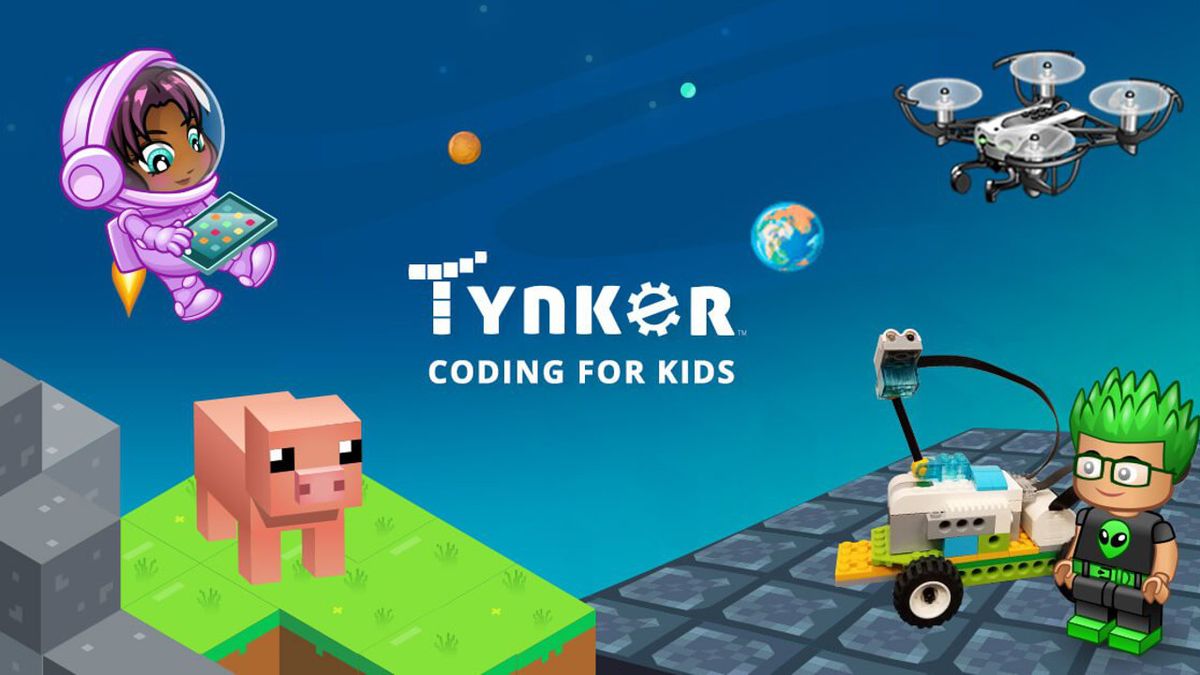
- Platform: Browser, iOS, Android
- Pricing: Free to start, with plans starting at $8.50/month
- Age range: 5 to 18
Designed to make programming accessible and fun for kids as young as five years old, Tynker gives kids the ability to write interactive stories, program drones, and explore other STEM topics, regardless of their prior experience. It can even be played offline without internet connectivity, so kids can play on the go.
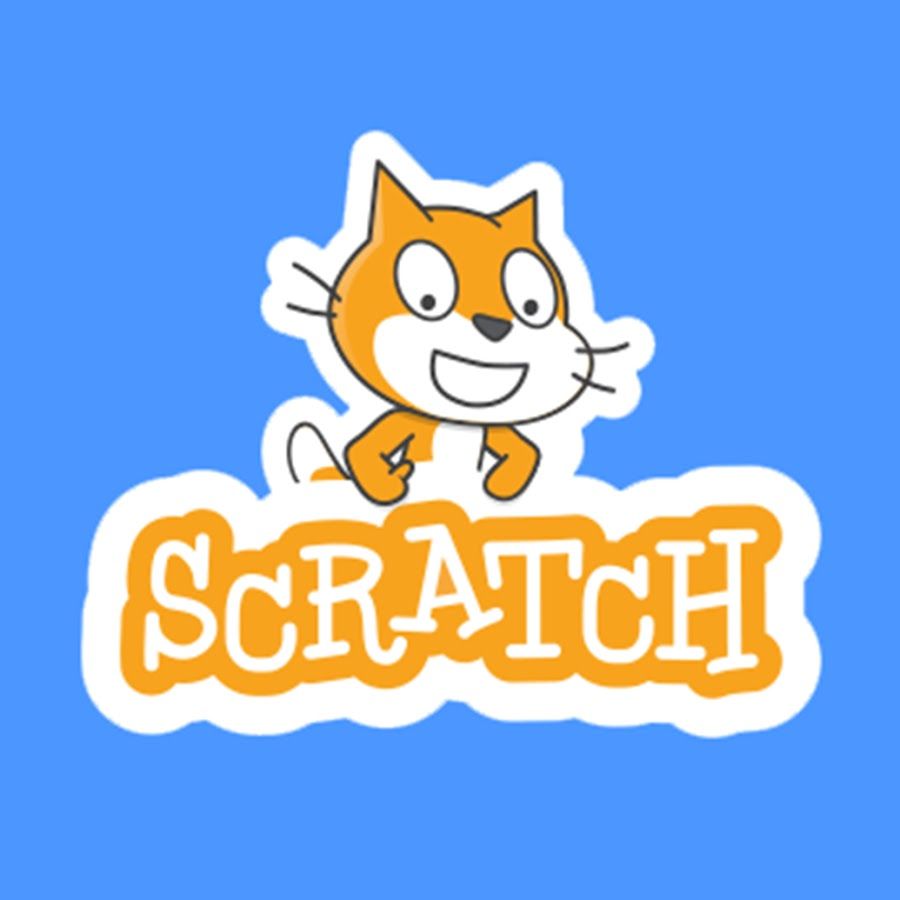
- Age range: 8 to 11
Designed by programmers at MIT, Scratch is the world's largest free coding community for kids. It's a place where users can use code to create stories, games, and animations, whether they're just getting started or ready to take on more complicated topics and concepts.
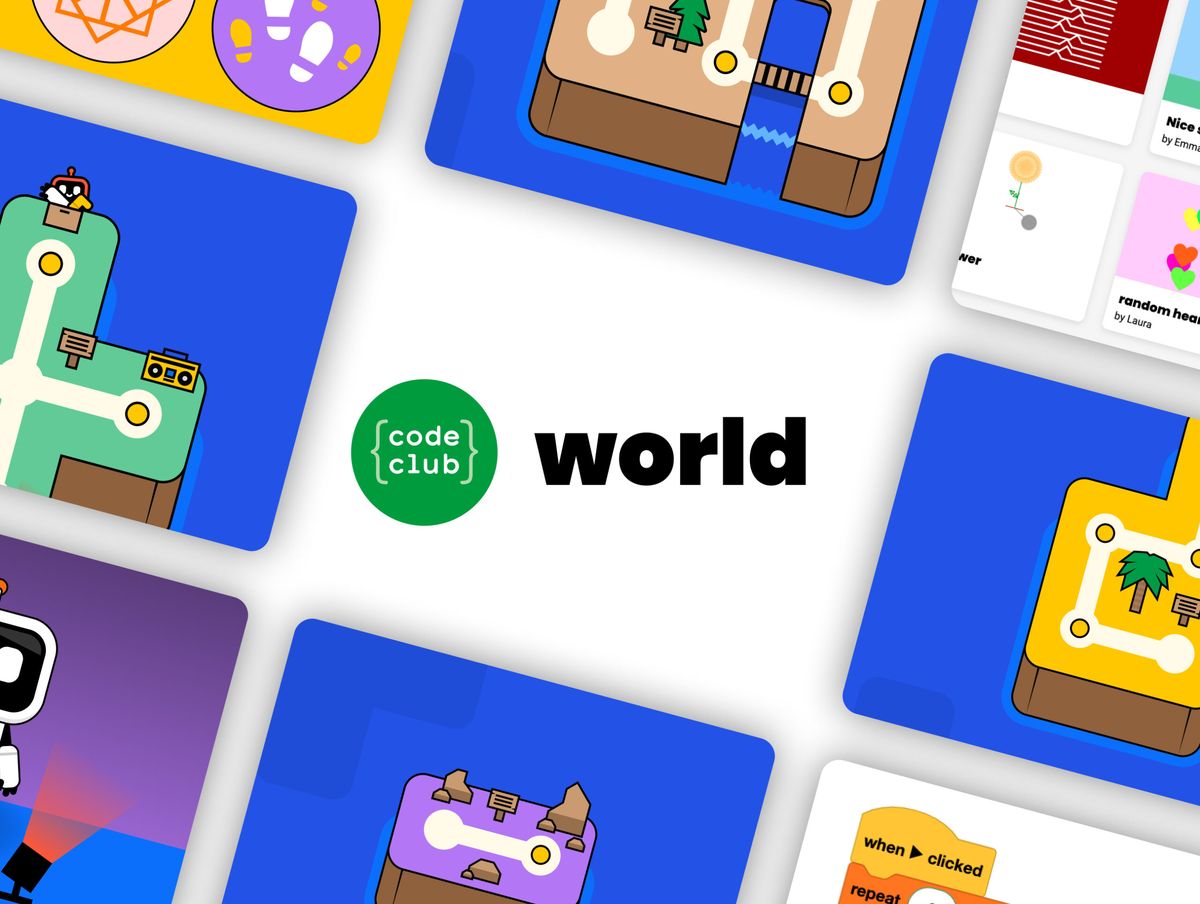
8) Code Club World
- Age range: 9 to 13
Created by Raspberry Pi Foundation, Code Club World allows older kids to get started on their coding journey with fun activities and no coding experience necessary. Children can create a robot avatar, make music, design a T-shirt, or even teach the robot to dance. They also earn a badge for each project they complete and are able to share their coding creations.
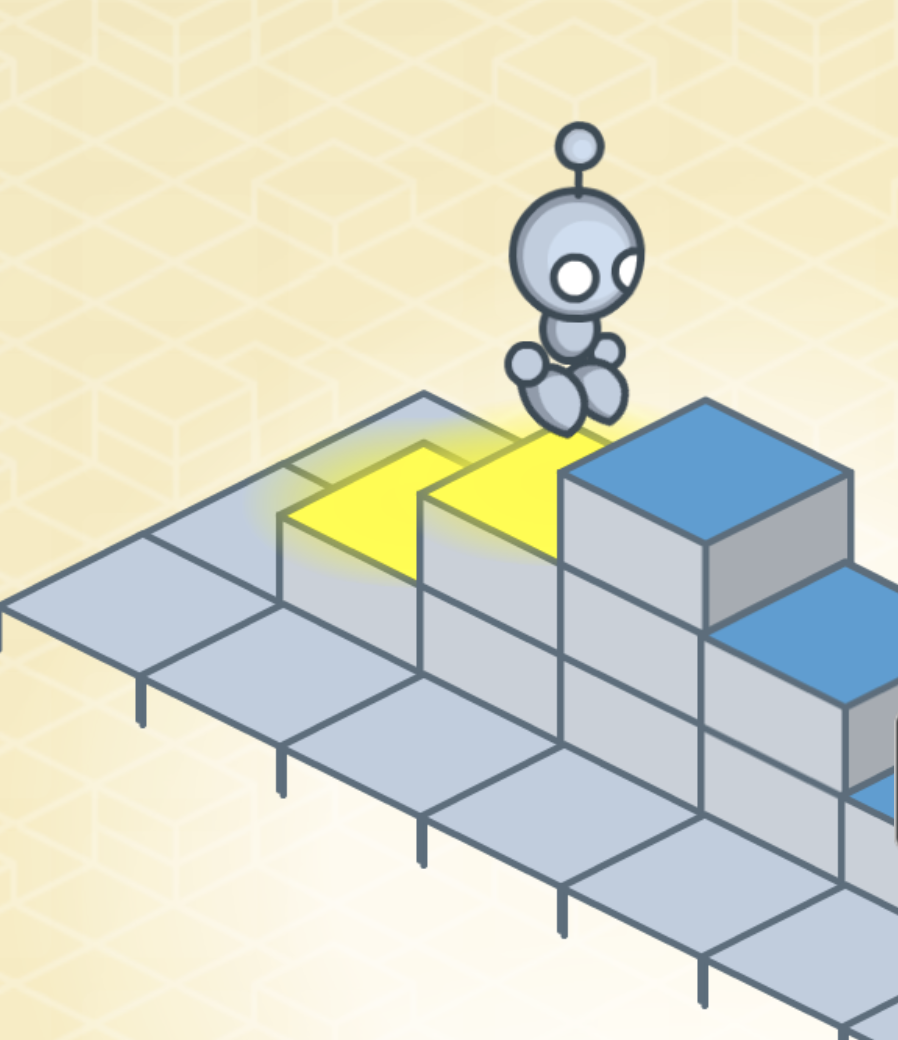
9) LightBot
- Pricing: $2.99 for app
- Age range: 9 and up
LightBot is a programming game that challenges users to solve different puzzles using commands, all while learning basic programming concepts. With 50 different levels, this one is sure to keep kids occupied for a while (and for kids aged four to eight, there is also an easier version called LightBot Jr. ).
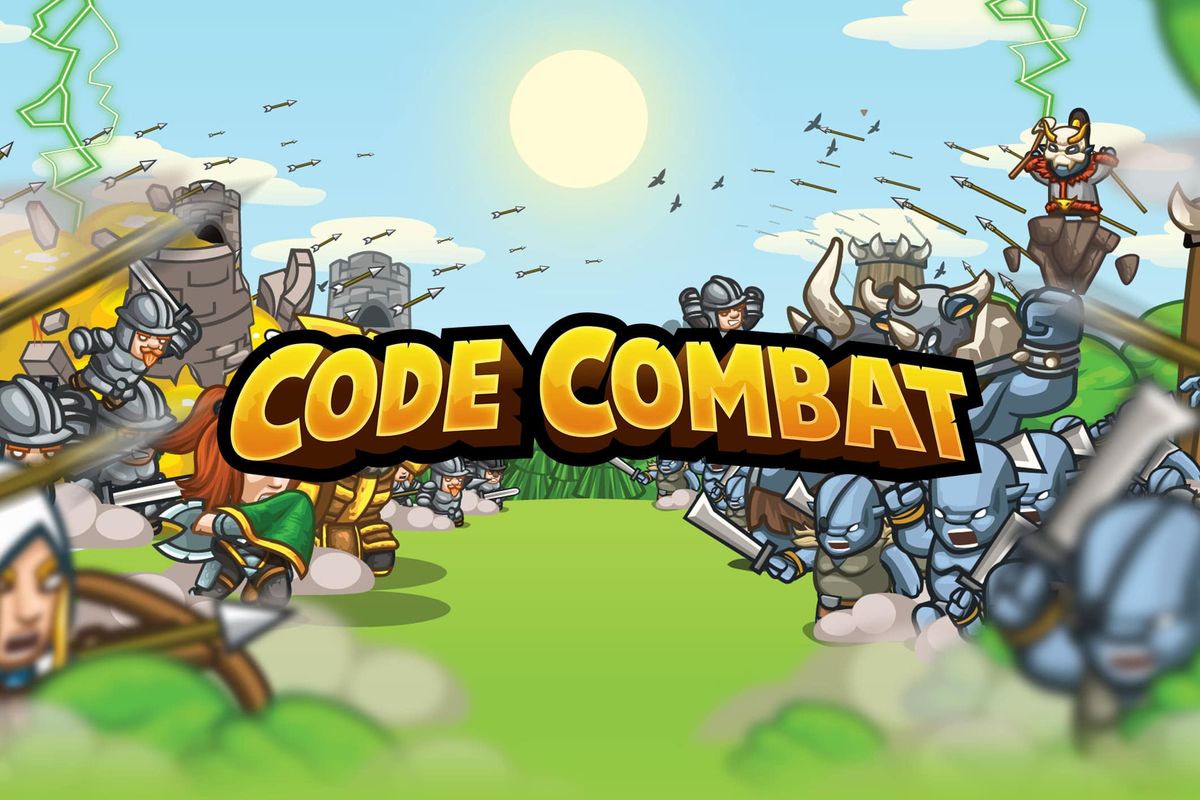
10) CodeCombat
- Pricing: Free to start, with plans starting at $9.99/month
One of the most straightforward coding games for kids, CodeCombat combines the world of fantasy (think: knights and dragons) with the basics of coding. Each lesson is introduced as another chapter in the overarching storyline of the CodeCombat universe, which is what makes this game so fun.

11) Hopscotch
- Platform: iOS
- Age range: 10 to 15
First introduced on Shark Tank, Hopscotch is a platform that allows kids to explore projects, make their own games, and learn how to code along the way. The free app even provides detailed video tutorials that teach users how to make games, animations, and apps to experience how software is created.
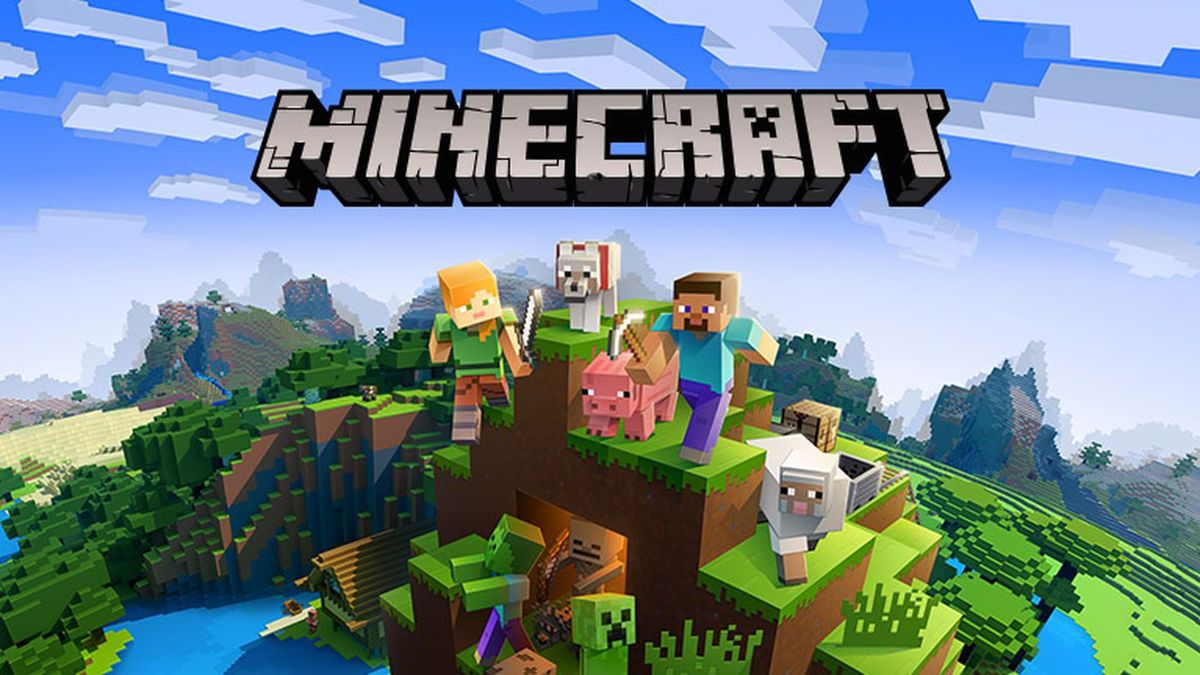
12) Minecraft
- Platform: Mac, Nintendo Switch, Nintendo Wii U, PlayStation 3, PlayStation 4, PlayStation Vita, Windows, Xbox 360, Xbox One
- Pricing: $6.99 ( app ), $26.95 ( PC and Mac )
- Age range: 10 and up
Perhaps the best known coding game for kids, Minecraft is all about using blocks to build objects, interact with other characters, and progress to new levels. It may sound simple, but it gives players the freedom to create and explore almost limitlessly (while also fulfilling missions and going after goals).

13) Swift Playgrounds
Though only available on iOS devices, Swift Playgrounds is still known as one of the best apps teaching coding for kids. By playing, kids can play and experiment with code through interactive puzzles, all while learning the basic terms and functions of coding.

- Platform: iOS, Android
- Age range: 12 and up
With tons of mini lessons, projects, and challenges, Mimo is a platform that makes learning how to code fun and accessible. The site offers daily goals, streaks, and achievement badges that'll teach kids to build websites, automate tasks, make apps, and more — all while feeling like they're playing a game.
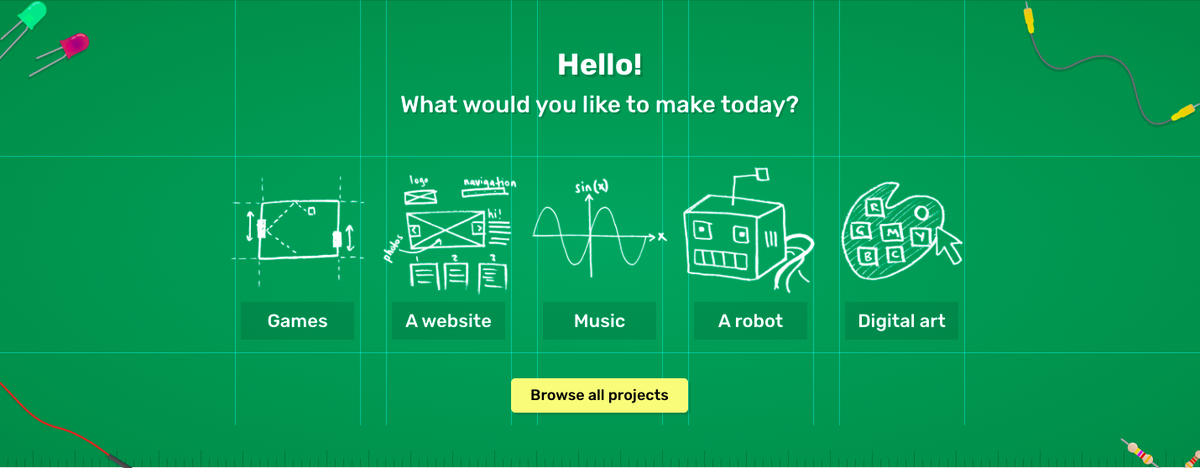
15) Projects
Also created by Raspberry Pi Foundation, Projects is a catalog of more than 250 free coding projects for young people to explore and further enhance their coding skills. From creating a stress ball app, to coding musical instruments, to making a racing game, there are tons of projects available, and each project is designed to be completed in an hour.
More for You
Trump campaign sends Bob Good cease-and-desist over yard signs
I Was in Horrific Pain for Decades. In Six Weeks, My Life Changed
"Mr. Miyagi" From 'Karate Kid': Pat Morita's Tragic Death
This State Has the Most Deer in America
"It Can Be Fatal": People Are Sharing Highly-Useful Facts That Should Actually Be Universal Knowledge, And These Are So Important
Parked airplane blown away by storm winds at Dallas airport
Netflix reveals its 3 most watched titles ever
‘Should I live under a bridge?’ I get $5,600 a month in Social Security and retirement income, but my property taxes will soon be $20,000. Who can help?
Investors, worried they can’t beat lawmakers in stock market, copy them instead
New Camera Angle Shows Malicious and Dirty Hit on Caitlin Clark
Ask Amy: Newly married wife receives a windfall
What do your blood test results mean? An expert offers insight.
Air Force Pilot Who Had Been Ordered to Prevent 9/11 Hijacked Plane from Reaching Washington, D.C., Retires
Robert De Niro stripped of leadership award following fiery anti-Trump speech
What is the healthiest bell pepper? The real difference between red, green and yellow.
The Only Major Actors Still Alive From Gilligan's Island
14 TV Series That Are Worth Cancelling Plans For
My husband wants me to sign over 20% of my home. If not, he threatens to take half in a divorce. What should I do?
Zara Tindall’s genius hack for stopping heels sinking into grass will save your summer soirees
Dramatic Changes in Appearance: Best Not To Pry
Positive Peers Launches Solitaire Emotions Game Designed to Boost Mental Health for Kids, Adults, and Seniors
Positive Peers Learning Software Partners' new app, Solitaire Emotions, utilizes positive affirmations and problem-solving challenges in the classic card game to enhance cognitive and emotional development for all ages, including neurodivergent individuals.
New York, NY - May 25, 2024 —
The question of whether playing video games can have a healthy and positive impact on a wide range of demographics, including kids, adults, seniors, and neurodivergent learners (autism spectrum disorders), is gaining increasing attention.
Positive Peers Learning Software Partners, an education technology company are the creators of the innovative brain game app "Solitaire Emotions," firmly believe in the affirmative and point to recent studies from the Pew Research Center, the National Institute of Health and the Responsible Innovation for Technology for Children (RITEC) Project.
These studies suggest that video games with positive thinking narratives and problem-solving challenges can significantly benefit cognitive and emotional development.
Solitaire Emotions, developed by Positive Peers Learning Software Partners, combines the classic card game with unique visuals, and (English and Spanish) bilingual self-regulation cards, coping strategies, positive affirmations, positive self-talk, to help players of all ages, including neurodivergent individuals.
This works in five key areas: learning to identify and manage various emotions, reducing stress, and sharpening memory.
This game is designed with the belief that positive words and affirmations are crucial for mental health enrichment.
"Words have power," says Jomo Gamal Thomas, bilingual author, artist, attorney, and co-founder of Positive Peers Learning Software.
"Positive thinking and self-talk can reduce stress, improve productivity, enhance coping skills, and promote better mental health. Our game features positive affirmations and words to help manage emotions and relax through the classic card game Solitaire, also known as Klondike or Concentration," Thomas said.
The app's innovative visual interface and coping strategies provide a much-needed tool for developing self-awareness, empathy, and behavioral regulation.
"I have a passion for positivity, productivity, people, and social-emotional learning," says Thomas. "As a single parent of a young son, Jomo Jesus, who is a prodigy and a neurodivergent learner (autistic), I saw the need to create a mindful Solitaire app for EQ and IQ that promotes positive thinking and emotional management." An estimated 6 million (9.8%) US children aged 3–17 years have ever been diagnosed with ADHD and over 8 million adults have ADHD according to the Center for Disease Control and Prevention.
Co-founder Sandra M. Clifton adds, "This is not just another mindless game. It's about incorporating emotional intelligence and positive thinking into a gamified experience for brain training and cognitive behavior therapy (CBT) and zones of emotional regulation."
The app includes:
Dynamic Learning Environment : Each session in "Solitaire Emotions" allows players to engage with complex emotions and develop strategies to navigate them effectively.
Cognitive Development Tools : The game enhances cognitive abilities like memory, attention span, and focus through interactive card gameplay.
Skill Enhancement : Players can sharpen their decision-making skills and problem-solving abilities while enjoying the game.
Emotional Coping Mechanisms: The app helps players identify their emotions and develop practical coping strategies.
Promotion of Mental Health Awareness : "Solitaire Emotions" encourages players to have open conversations about mental health, fostering a supportive community.
Thomas further emphasizes the importance of positive thinking and emotional intelligence in today's society: "Negative words can decrease self-esteem, self-confidence, and emotional control. Young children benefit more from positive self-talk and affirmations that promote mental health, self-confidence, and improved self-control of emotions. Developing a game with positive messages is our way of giving back to the world.”
About Positive Peers Learning Software Partners :
Positive Peers Learning Software Partners leads the development of mobile apps that enhance emotional intelligence for children. Specializing in mindful applications and SEL games using CBT skills, the company addresses the educational needs of neurodivergent learners, including those with ADHD and autism, to improve their IQ and emotional skills. Founders Jomo Gamal Thomas, Esq., and Sandra M. Clifton, MBA, are dedicated to creating innovative educational solutions that foster early learning development for all children.
Download Solitaire Emotions on the Google Play Store :
Click here: https://play.google.com/store/apps/details?id=com.solitaire.emoji&hl=vn
Contact Info: Name: Jomo Gamal Thomas, Esq. Email: Send Email Organization: Positive Peers Learning Software Address: 430 West Merrick Road, Suite 20, Valley Stream, NY 11580 Phone: (718) 578-0019 Website: https://positivepeerslearning.com/
Release ID: 89130921
In the event of any inaccuracies, problems, or queries arising from the content shared in this press release, we encourage you to notify us immediately at [email protected] (it is important to note that this email is the authorized channel for such matters, sending multiple emails to multiple addresses does not necessarily help expedite your request). Our diligent team will be readily available to respond and take swift action within 8 hours to rectify any identified issues or assist with removal requests. Ensuring the provision of high-quality and precise information is paramount to us.
- Share full article
For more audio journalism and storytelling, download New York Times Audio , a new iOS app available for news subscribers.
I.C.C. Prosecutor Requests Warrants for Israeli and Hamas Leaders
The move sets up a possible showdown between the international court and israel with its biggest ally, the united states..
This transcript was created using speech recognition software. While it has been reviewed by human transcribers, it may contain errors. Please review the episode audio before quoting from this transcript and email [email protected] with any questions.
From “The New York Times,” I’m Sabrina Tavernise, and this is “The Daily.”
[MUSIC PLAYING]
Earlier this week, the top prosecutor of the International Criminal Court requested arrest warrants for Israel’s prime minister and its defense minister. The move shocked Israelis and set up a possible showdown between the world’s top criminal court and Israel, together with its biggest ally, the United States. Today, my colleague, Jerusalem Bureau Chief Patrick Kingsley, explains.
It’s Thursday, May 23rd.
So, Patrick, earlier this week, there was a pretty surprising announcement by the International Criminal Court in The Hague. It had to do with Israel and Hamas. Tell us what happened.
Well, on Monday morning, we were all taken by surprise by an announcement from the chief prosecutor at the ICC, the International Criminal Court, the top criminal court in the world. It tries individuals accused of war crimes. And the chief prosecutor announced that he was requesting arrest warrants for five individuals involved in the war between Israel and Hamas for crimes against humanity. Three of them were from Hamas — Yahya Sinwar, the head of Hamas within Gaza, the Hamas military commander, and the political leader of Hamas, who’s based in Qatar.
But maybe the biggest news in this announcement was that the chief prosecutor was seeking the arrest of two of Israel’s top leaders — Benjamin Netanyahu, the prime minister, and Yoav Gallant, the defense minister. And this was a massive bombshell. These two men are leaders from a major US ally. They’re in regular contact with the US government, and they were being implicitly equated with the three top leaders of an organization, Hamas, that many consider a terrorist organization. And this equation sent shockwaves through Israeli society and, indeed, around the world.
So this is absolutely remarkable, Patrick. I mean, I, for one, was quite surprised by seeing this. I want to dig into it with you. So who is this prosecutor behind these requests for these warrants? And how did he reach this decision to go for them in the first place?
So the prosecutor’s name is Karim Khan, and he is a British lawyer, a British barrister. He is 54. He’s led a very impressive career. He has spent years working on human rights cases, both defending people and also prosecuting in such cases.
He was involved in tribunals related to the wars surrounding the breakup of the former Yugoslavia, Rwanda. He investigated Islamic State crimes in Iraq. And in 2021, he is appointed the top prosecutor at the ICC.
And what are his responsibilities as top prosecutor?
Well, it’s his job to travel the world and investigate allegations of human rights abuses, war crimes, crimes against humanity, and in the process, plays a key role in deciding who gets prosecuted at the International Criminal Court. The ICC and the ICC prosecutor investigates and tries people who would not be pursued by the judicial system within their countries of origin. It steps in when it seems like the domestic authorities in any given country are not doing their job.
And last year, he famously went after President Putin in Russia in connection with the war in Ukraine.
So at what point did this prosecutor, Karim Khan, turn his attention to Israel and Gaza?
Well, he actually inherits an investigation from his predecessor that’s looking at Israel’s conduct and also that of Hamas during a previous war in 2014 between the two sides. But then that gets superseded on October 7th by the horrors that we saw that day committed by Hamas and then by the scale and damage caused by Israel’s bombing campaign in its counterattack.
And we begin to see not only revulsion and horror at what Hamas had done in early October, but also growing criticism and condemnation of what Israel and its Air Force did in its response. You’ll remember that earlier this year, the International Court of Justice, a separate court also in The Hague, began to address claims that Israel was and is committing a genocide in Gaza, a claim that Israel strongly denies.
Right. That was the case that South Africa brought. We did an episode about that.
Yes, exactly. So as the world’s attention focuses on this new conflict, so does Karim Khan’s.
Also today, the International Criminal Court’s Chief Prosecutor, Karim Khan, QC, has wrapped up a visit to Israel and the occupied West Bank.
Khan has visited the region to investigate if war crimes were committed on October 7th.
We start to see him arrive in Israel visiting some of the sites that Hamas attacked last year, talking to survivors, talking to leaders, reviewing security camera footage, and so on.
I have just come from the border of the Rafah crossing, and we could see Gaza, at least we could see cranes that were on the territory of Gaza.
And he also visited the Rafah crossing between Egypt and Gaza, talks to Palestinians.
At the Ministry of Justice in Ramallah, the chief prosecutor of the world’s highest court.
He goes to the Israeli occupied West Bank, to Ramallah, where the Palestinian Authority is based, building up evidence that led to this announcement on Monday.
Today, I’m filing applications for warrants of arrest before Pre-Trial Chamber I of the International Criminal Court.
And he makes this very dramatic announcement in a video.
My office has diligently collected evidence and interviewed survivors and eyewitnesses at the scene of at least six major attack locations.
Flanked on each side by two of his deputies.
I have reasonable grounds to believe that three senior leaders of Hamas, Yahya Sinwar, Mohammed DEIF and Ismail Haniyeh, bear criminal responsibility for the following international crimes.
And the accusations that he makes against the three Hamas leaders focus on the violent actions that Hamas took on October 7th.
Extermination as a crime against humanity. Murder as a crime against humanity.
And he walked through a long list of charges stemming from the extraordinary violence during that attack.
The taking of hostages as a war crime. Rape and other acts of sexual violence during captivity.
And he says there are reasonable grounds to believe that hostages taken from Israel have been subject to sexual violence, including rape, while being held in captivity. And he cites assessment of medical records, video, and documentary evidence, as well as interviews with victims and survivors.
And I repeat and underline my call for the immediate release of all hostages taken from Israel and for their immediate safe return to their families.
So this prosecutor sees the atrocities on October 7th and then what followed with Hamas taking the hostages, abusing them, as crimes against humanity. That’s what it amounted to in his view?
And what about the charges against the Israelis?
These are slightly different.
Israeli Prime Minister Benjamin Netanyahu and Minister of Defense Yoav Gallant bear criminal responsibility for the following international crimes.
Obviously, a lot of the outcry and horror at the war in Gaza has centered around Israel’s airstrikes that have killed tens of thousands of Gazans. But Karim Khan focuses not on the military actions of Benjamin Netanyahu and Yoav Gallant, his defense minister, but on the accusation of —
Starvation of civilians as a method of warfare.
— starvation. The idea that Israel has allegedly sought to restrict and block aid deliveries, food supplies to Gaza with the intent to starve the civilian population there.
These individuals, through a common plan, have systematically deprived the civilian population of Gaza of objects indispensable to human survival.
And that’s primarily based on the fact that for the first two weeks of the war, until October 21st or so, Israel blocked all aid entry to Gaza after Yoav Gallant, the defense minister, one of these two Israelis whose arrests Mr. Khan seeks, said that he was imposing a total siege on Gaza — no food, no fuel, no electricity. And while that total siege was eased towards the end of October, Khan also notes that there have been continuing restrictions on essential supplies, like food and medicine, ever since.
That conduct took place alongside attacks that killed civilians, the obstruction of aid delivery by humanitarian organizations, and attacks on aid workers that forced many of those same humanitarian organizations to either cease operations or limit their life-saving efforts in Gaza.
The implication is that the famine that he says is present in some areas of Gaza and imminent in other areas is in part the responsibility of Netanyahu and Gallant.
That starvation has caused and continues to cause deaths, malnutrition, dehydration, and profound suffering among the population. My office charges Netanyahu and Gallant as co-perpetrators and as superiors in the commission of these alleged crimes.
Why is the focus of these charges starvation? I mean, given that the airstrikes, as you say, were in many ways really the focus of this war and certainly the focus of the world’s attention on this war, the civilian deaths from the military operation. Why starvation?
Karim Khan does not explain why he focuses on starvation rather than Israel’s military tactics, which he mentions only in passing. But legal experts have said that it’s easier to prove that starvation was used as a method of warfare than it is to prove that there have been any specific crimes involved in any specific airstrikes. And that’s because under the rules of war and international law, it’s not necessarily illegal in and of itself to kill civilians during wartime. If a military assesses, with the help of military lawyers, that the likely civilian death toll caused by that strike is proportional to the value of the military target, then that, in many cases, will be in accordance with the rules of war. If a military can prove that sense of proportionality, then it’s actually quite hard to prove that there was any crime committed in the process.
So in other words, military actions are often weighed quite carefully. In the case of, say, a modern military like Israel’s or the United States, there are lawyers that look at these things. It’s not necessarily so easy to prove that something was disproportionate and should be considered a crime.
Exactly. Whereas with the crime of starvation, legal experts say that it’s potentially easier to prove that there was some wrongdoing there because Yoav Gallant, the Israeli Defense Minister, went on record in a public statement, and he announced that there would be a total siege on the territory of Gaza. And that was followed by an action, the action of closing off Gaza’s borders for the next two weeks, and no aid was allowed in. During that time, there were restrictions on electricity, water, fuel, as well as food. And that’s why legal experts think that Karim Khan has gone after Israel with the crime of starvation rather than focusing on their military operations.
But I suppose just thinking about our coverage, Patrick, and the conversations you and I have had, famine and starvation and a civilian population in extreme distress trapped in a small piece of territory is also not a small thing, right? That is also something that makes sense that the court would be considering.
Absolutely, it’s a huge thing. People don’t have to be hit by an airstrike to be living through an absolutely catastrophic situation.
So these charges really seem to spell bad news for Israel and for these two Israeli leaders, Netanyahu and Gallant. And it’s remarkable because these are men who, as you say, are some of America’s closest allies. I mean, they’re, you know, at the Pentagon. They’re having meetings with President Biden. And now, the chief prosecutor of the ICC is saying that they are war criminals.
Yes, it is a very dramatic moment in the view of some people, a turning point, and certainly, we can say that it is one of the harshest rebukes of Israel’s wartime conduct since October 7th.
But within Israel, there’s been a very different reaction. And it’s not all bad news for Benjamin Netanyahu.
We’ll be right back.
So, Patrick, what do Israelis make of this announcement?
Within Israel, the reaction has been very different. Whether it’s Netanyahu’s allies or his critics, there has been almost uniform outrage that the prosecutor for the ICC would make these accusations. And it means that at a time of rising domestic criticism of Prime Minister Netanyahu across the political spectrum, with only a very few exceptions, everyone has rallied behind Netanyahu and Gallant. Despite the fact that Netanyahu is increasingly unpopular and even within his own government, there have been growing criticism of his wartime strategy.
For example, just two days before the prosecutor’s announcement, one of the senior members of his own wartime cabinet, Benny Gantz, issued Netanyahu with an ultimatum, warning him that he would quit the government if he did not spell out a plan for a post-war Gaza. Then, suddenly, the announcement comes from Karim Khan that Netanyahu and Gallant are under investigation. And Gantz is one of the first to come out with a condemnation of Karim Khan and a defense of the Israeli government. That is the clearest example of how even critics of Netanyahu have fallen in line, circled the wagons, and presented a united front.
This is really interesting. So this action by the prosecutor has kind of had the effect of actually closing divisions that were starting to appear in Israeli society, effectively bringing Netanyahu’s critics kind of back into his camp, or at least making it harder to criticize him.
Exactly. And Israelis, in general, feel that Israel has always been targeted unfairly, held to a higher standard than many other countries, and that this is, once again, another example of that, another example of Israel being accused of things that other countries do but get away with. And there have been broadly three criticisms from the Israelis of the ICC prosecutor.
First, the Israeli claim is that the ICC prosecutor is making a horrible false equivalence between Hamas, a terrorist organization, and Israel, a democratic state. Hamas raided Israel and launched the bloodiest attack on Jews in a single day since the Holocaust. Israel, in the eyes of Israelis, is fighting a righteous response to protect their citizens and to win back the liberty of the hostages that were captured on October 7th.
This guy is out to demonize Israel. He’s doing a hit job.
And Netanyahu himself articulated some of the clearest versions of this argument when he went on American television.
He’s creating false symmetry, false facts, and he’s doing a grave injustice to the International Court.
And he called Khan’s decision absurd, an effort to demonize Israel and to hold it to far higher standards than any other country. He said it would have been as if after 9/11 —
That’s like saying after 9/11, well, I’m issuing arrest warrants for George Bush, but also for bin Laden.
— arrest warrants had been issued for both Osama bin Laden and George Bush.
Or after, in World War II, well, I’m issuing arrest warrants for FDR, but also for Hitler. It’s a hit job. It’s not serious. He’s out to defame Israel, and he’s also pouring gasoline —
The second criticism from Israelis has been about process. The ICC was created about two decades ago by a treaty. More than 120 countries have signed that treaty, but Israel has not. And Israel contends that the prosecutor doesn’t have the authority, therefore, to go after Israeli political leaders.
Israelis also say that Khan didn’t spend enough time assessing whether Israel was itself investigating these allegations within its own judicial system. Remember that the ICC is a court of last resort. It’s only supposed to intervene when a domestic judicial system is genuinely not making any effort to investigate the alleged crime.
And Israelis are saying that Khan didn’t spend enough time investigating Gallant and Netanyahu. The ICC prosecutors have spent 10 years investigating alleged crimes committed during a previous war between Israel and Hamas, but this decision has been issued within just a few months. And Israelis are saying that Khan jumped the gun in that sense.
So the Israelis are saying, look, we’re trying to get to it, but you just didn’t give us enough time.
Exactly. And they’ve even said that Khan’s team was supposed to be coming this very week to continue that conversation and assess whether Israel was genuinely looking into these allegations by itself. And that they misled Israel by pretending that they would be making that assessment when, in fact, all along they were planning to request arrest warrants.
Interesting. So for Israeli officials, they’re seeing it as a kind of activist thing, as opposed to a neutral judicial decision.
That’s their claim, at least. The prosecutor’s office says that they have tried to sincerely engage with Israel on this issue, but that it’s become clear to them that Israel does not seriously investigate this kind of crime.
So you said, there are three elements to this. What’s the last?
The third and last element is on the content of the claim itself. Israel flatly denies that it is responsible for the humanitarian crisis in Gaza. It even denies that there is a famine or that the situation is on the point of a famine. It points out all the ways in which it has worked to get much more aid into Gaza since October, including opening more crossings, allowing the US to create a pier on the shoreline of Gaza. It’s allowed some countries to airdrop aid. And certainly, the amount of aid that has gone in recent months has dwarfed the amount that was going in October and November.
And while it accepts that its soldiers have obstructed and, at times, even killed aid workers, it says that that obscures the fact that it coordinates every day in detail with aid groups to facilitate thousands of aid missions every month.
Isn’t Israel’s argument that these shipments could also include things that could be very useful for Hamas, the group that just killed 1,200 of its citizens?
Exactly. No one’s disputing, least of all Israel, that Israeli officials are examining all the aid going into Gaza. The dispute is about whether that’s necessary. Israel says it is. It says that if it didn’t check, then some of these aid convoys might be smuggling in weapons or material that could be used to fight Israel, to kill Israeli civilians. And that, therefore, Israel has no choice but to examine some of these goods going in. Again, the counterargument is that Israel’s checks are far more stringent than they need to be and end up preventing the entry of everyday items that pose no military threat.
OK, so that’s the Israeli perspective. How does the United States see the prosecutor’s request here? I mean, the US, obviously, Israel’s biggest ally.
Well, the American president, President Biden, condemned it in no uncertain terms. He said the prosecutor’s decision was outrageous. And he condemned him for drawing an implicit equivalence between Hamas and the leaders of the state of Israel.
And why did Biden come out so strongly against the prosecutor? We know that humanitarian aid has been a major concern for this administration. So why would Biden be so opposed to something that really is calling out Israel for this aid?
First of all, because Israel is a major ally of the United States, and the United States wants to show support for its ally. Second of all, they fear that this kind of criticism, this kind of intervention, will actually make Israel less, rather than more, likely to bring the war to a halt, because the feeling is that it will make Israel more defensive and in turn batten down the hatches.
The third reason is that the United States, historically, has never been a particular fan of the International Criminal Court. We mentioned earlier that Israel did not sign the treaty that created the ICC. Well, the United States did not do that either. And that’s in part because American leaders fear that having an international global court undermines American sovereignty. They think it’s the role of the American judicial system to investigate American citizens.
And there is a fear that with the United States so active militarily in many parts of the world, that membership of the court, involvement in the court could pave the way for American soldiers being tried for acting on behalf of the United States. And that could somehow dent American foreign policy goals across the world.
OK, so the United States doesn’t really like this court, you know, has troops in a lot of places, doesn’t want a court swooping in and prosecuting them when something goes wrong. But I guess the question then, in my mind, Patrick, is does what this prosecutor is doing matter? I mean, America is not a signatory. Israel is not a signatory. So why is this important?
Well, for the time being, its meaning is more symbolic than anything else. First, Karim Khan has not issued an arrest warrant. He has requested an arrest warrant for these five people. And three judges will now spend weeks and possibly months deciding whether to uphold those requests. That process can be less than a month. In the case of Vladimir Putin, it was just shy of a month. President Bashir of Sudan was issued with a warrant. That process took roughly a year.
When and if they do do that, however, there will be practical effects. If an arrest warrant is issued, it means that any country that’s a member of the International Criminal Court, in theory, should arrest any of these individuals if they enter their territory. That includes more than 120 countries all over the world, much of Europe, Latin America, Africa, and so on. Yes, it’s true that the United States and Israel are not signatories, and neither are Turkey or Qatar, two of the countries where Hamas officials spend much of their time when they’re outside Gaza. So there will still be places for officials on either side of these accusations to travel to.
But there are lots of other countries, like France, Italy, both places where Benjamin Netanyahu traveled in the past year, where, in theory, they will not be able to set foot.
So the negotiations over the war can still continue, but if Netanyahu travels to France or to Italy, he could be arrested, which is pretty wild.
Yes, at least that’s the theory. The national authorities in any given country still have to make a choice about whether they want to follow through with it.
But would those countries perhaps not arrest him out of deference to the United States?
I think the expectation is that if we got into this scenario, then someone like Netanyahu simply just wouldn’t travel to such a country. But the truth is, we just don’t really know. We are entering unchartered waters.
So this is really isolating Netanyahu in the world. Should it go forward?
Yes, isolating Netanyahu and to some extent Israel itself. And it has not just practical implications for the physical movement of Netanyahu and his defense minister, Gallant, but it also compounds Israel’s relationship with foreign allies. It complicates Israel’s ability to arm itself. More countries may grow more unwilling to sell Israel arms, or at least they’ll face growing pressure because of this decision not to do so.
And it also could force the country to become ever more reliant on the United States as it becomes more of a pariah over its actions in Gaza.
Which, of course, puts the United States in an even trickier position with an ally who’s been pretty hard to be friends with of late.
Right. And in truth, while the practical consequences of this move are still unknown, they do, in general, compound the sense that Israel is facing more and more diplomatic consequences for its actions. More than a decade ago, a former Israeli prime minister warned that Israel would face what he called a diplomatic tsunami if its conflict with the Palestinians went unresolved.
And it’s possible that years later we’re starting to finally see what he meant. Israel does still have its supporters, many of them, but we’re also now seeing during this war a level of criticism that goes above and beyond the kind that we’ve grown used to seeing directed at Israel over the years.
In addition to the warrant requests we’ve seen this week, we’ve obviously had an extraordinary wave of protests on American campuses and elsewhere in the world. And earlier this year, we had a watershed moment when the International Court of Justice began hearing accusations of genocide against Israel. And this week, several European countries recognized Palestine as a state.
So if the tsunami hasn’t yet arrived, we can at least say that the waves are getting stronger.
Patrick, thank you.
Thank you. [MUSIC PLAYING]
On Wednesday, the leaders of Spain, Norway, and Ireland announced that they would recognize an independent Palestinian state. The move was largely symbolic, but raised the concern that if neighboring countries followed their lead, Europe could become a counterweight to the American position that statehood for Palestinians should come only from a negotiated settlement with Israel.
Here’s what else you should know today. Nikki Haley, the former United Nations ambassador who dropped her Republican presidential bid in March, said on Wednesday that she would vote for Donald Trump but stopped short of officially endorsing him. Haley was Trump’s longest standing rival in the 2024 primary contest and had carved out an important lane for herself as the voice for voters looking for an alternative to the former president. Her decision on whether to endorse him could play a pivotal role in the race. Haley has built a formidable network of high-dollar donors and a solid base of college-educated voters that Trump needs to win.
And the city of Uvalde, Texas, has reached a settlement with most of the families of children who were shot by a gunman at Robb Elementary School in 2022. To avert a lawsuit, the city promised to overhaul the city’s police force, create a permanent memorial to the victims, and pay $2 million.
Today’s episode was produced by Will Reid and Diana Nguyen with help from Shannon Lin. It was edited by Liz O. Baylen with help from Michael Benoist, contains original music by Elisheba Ittoop, Marion Lozano, and Pat McCusker, and was engineered by Alyssa Moxley. Our theme music is by Jim Brunberg and Ben Landsverk of Wonderly.
That’s it for “The Daily.” I’m Sabrina Tavernise. See you tomorrow.

- May 31, 2024 • 31:29 Guilty
- May 30, 2024 • 25:21 The Government Takes On Ticketmaster
- May 29, 2024 • 29:46 The Closing Arguments in the Trump Trial
- May 28, 2024 • 25:56 The Alitos and Their Flags
- May 24, 2024 • 25:18 Whales Have an Alphabet
- May 23, 2024 • 34:24 I.C.C. Prosecutor Requests Warrants for Israeli and Hamas Leaders
- May 22, 2024 • 23:20 Biden’s Open War on Hidden Fees
- May 21, 2024 • 24:14 The Crypto Comeback
- May 20, 2024 • 31:51 Was the 401(k) a Mistake?
- May 19, 2024 • 33:23 The Sunday Read: ‘Why Did This Guy Put a Song About Me on Spotify?’
- May 17, 2024 • 51:10 The Campus Protesters Explain Themselves
- May 16, 2024 • 30:47 The Make-or-Break Testimony of Michael Cohen
Hosted by Sabrina Tavernise
Featuring Patrick Kingsley
Produced by Will Reid , Diana Nguyen and Shannon M. Lin
Edited by Liz O. Baylen and Michael Benoist
Original music by Elisheba Ittoop
Engineered by Chris Wood
Listen and follow The Daily Apple Podcasts | Spotify | Amazon Music | YouTube
This week, Karim Khan, the top prosecutor of the International Criminal Court, requested arrest warrants for Israel’s prime minister, Benjamin Netanyahu, and the country’s defense minister, Yoav Gallant.
Patrick Kingsley, the Times’s bureau chief in Jerusalem, explains why this may set up a possible showdown between the court and Israel with its biggest ally, the United States.
On today’s episode

Patrick Kingsley , the Jerusalem bureau chief for The New York Times.

Background reading
Why did a prosecutor go public with the arrest warrant requests ?
The warrant request appeared to shore up domestic support for Mr. Netanyahu.
There are a lot of ways to listen to The Daily. Here’s how.
We aim to make transcripts available the next workday after an episode’s publication. You can find them at the top of the page.
The Daily is made by Rachel Quester, Lynsea Garrison, Clare Toeniskoetter, Paige Cowett, Michael Simon Johnson, Brad Fisher, Chris Wood, Jessica Cheung, Stella Tan, Alexandra Leigh Young, Lisa Chow, Eric Krupke, Marc Georges, Luke Vander Ploeg, M.J. Davis Lin, Dan Powell, Sydney Harper, Mike Benoist, Liz O. Baylen, Asthaa Chaturvedi, Rachelle Bonja, Diana Nguyen, Marion Lozano, Corey Schreppel, Rob Szypko, Elisheba Ittoop, Mooj Zadie, Patricia Willens, Rowan Niemisto, Jody Becker, Rikki Novetsky, John Ketchum, Nina Feldman, Will Reid, Carlos Prieto, Ben Calhoun, Susan Lee, Lexie Diao, Mary Wilson, Alex Stern, Dan Farrell, Sophia Lanman, Shannon Lin, Diane Wong, Devon Taylor, Alyssa Moxley, Summer Thomad, Olivia Natt, Daniel Ramirez and Brendan Klinkenberg.
Our theme music is by Jim Brunberg and Ben Landsverk of Wonderly. Special thanks to Sam Dolnick, Paula Szuchman, Lisa Tobin, Larissa Anderson, Julia Simon, Sofia Milan, Mahima Chablani, Elizabeth Davis-Moorer, Jeffrey Miranda, Renan Borelli, Maddy Masiello, Isabella Anderson and Nina Lassam.
Patrick Kingsley is The Times’s Jerusalem bureau chief, leading coverage of Israel, Gaza and the West Bank. More about Patrick Kingsley
Advertisement

VIDEO
COMMENTS
By honing their problem-solving abilities, we're preparing kids to face the unforeseen challenges of the world outside. Enhances Cognitive Growth: Otherwise known as cognitive development. Problem-solving isn't just about finding solutions. It's about thinking critically, analyzing situations, and making decisions.
Problem-solving activities for kids: Explore 24 fun problem-solving games and activities, and learn effective tips and strategies to teach kids problem-solving skills.If you want to explore problem-solving strategies more in-depth, you can also grab our workbook "Problem-Solving for Kids" (printable resource).. Problem-solving is the cognitive process of finding solutions to challenges or ...
For this problem solving activity for older kids or teens, you will need four 2×6 boards. Divide your group into two teams with an equal number of children on each team. Place two of the four boards end to end on the ground or floor. Set the other two parallel to the first two about two or three feet apart.
Algebra Puzzles. Strategic Multiplication. Fraction Tasks. Problem Solving. 3rd Grade Math. Visual Math Tools. Model Word Problems. Free, online math games and more at MathPlayground.com! Problem solving, logic games and number puzzles kids love to play.
Additionally, problem-solving helps children learn how to find creative solutions to challenges they may face both in and out of the classroom. These activities can also be fun and used in cohesion with school or playtime. 17 Fun Problem-Solving Activities for Kids 1. Marble Mazes. This activity was selected because it requires them to think ...
All lines of work need great problem solvers to find tomorrow's solutions, and students of any age can be honing their problem-solving skills. Check out some of these fun problem-solving activities for kids and teens below! Problem-solving activities for elementary school kids (ages 5-10) From traditional paper-and-pencil activities to online ...
15 Best Problem Solving Activities for Kids. 1. Rolling Dice. Things you'll need: A die or dice, some flashcards and a pen. How to do: You can play tons of different games with dice. Playing with two dice encourages kids to quickly add up numbers and learn math in a fun way.
Take your child's critical thinking and problem-solving skills to the next level with MentalUP! 👏. Packed with hundreds of problem-solving games for kids of all ages, MentalUP provides the ideal support for your child to enhance their concentration, visual intelligence, memory, critical thinking, and more, all while having fun. 🚀. Start using the app today and join over 10 million users ...
6) Quirkle Board Game. If you're looking for problem solving activities for kids you can enjoy as a family, I highly recommend Quirkle! It's easy to play but definitely puts players' problem solving skills to the test, and I love that it's a game the whole family can enjoy! 7) Size of the Problem Activity Pack.
Logic & Thinking Games for Kids. Elevate your child's problem-solving abilities with our fun logic & thinking games for kids. They will learn to analyze, strategize, and think critically while having fun. Explore our collection now and provide them with endless opportunities to learn and grow. Start playing for free now!
We love single player logic games and probably own an unhealthy number of these brain boosting puzzle games. The following are some of our top favorites: Cat Crimes, ages 8 and up ( pictured above) - see it as our game of the month feature. Code Master, ages 8 and up - see it as our game of the month feature.
Puzzles and brain teasers are fun ways to boost kids' problem-solving skills. These challenges can be jigsaw puzzles, tricky riddles, or math puzzles, all designed to make kids think critically and creatively. By solving them, kids learn to break down problems, be persistent, and find different solutions. Jigsaw puzzles, Sudoku, Rubik's ...
15 Problem Solving Activities for Kids. There is no better way to learn than by playing. The following exercises are enjoyable and challenge youngsters to demonstrate their problem-solving abilities. Riddles. Riddles for kids are fantastic games for problem-solving. They come at various levels of difficulty.
Give your brain a workout with these kids problem solving games and interactive activities. Find cool number problems and exercises as well as challenges that will test your logical thinking and reasoning abilities. Help a frog jump stones, measure water with limited resources, get people safely across a bridge and more.
PLAY NOW. MentalUP Brain Stimulators Games for Kids help kids improve their skills including visual attention, divided attention, selective attention, focusing, problem-solving, and imagination. Improve your child's cognitive skills with online mind games, have fun, and learn at the same time! PLAY FOR FREE.
Encourage your child to plan their day or week, balancing schoolwork, chores, and leisure. This helps them develop critical time management and prioritization skills. Each of these activities, while mundane, is an opportunity for your child to think critically, make decisions, and solve problems.
This activity will help your child develop problem-solving skills as they learn how to balance the materials to create a stable structure. 15. Card Mix Up Games. Cards are versatile playthings that offer many opportunities for problem-solving fun. For example, you can play the classic card game Solitaire.
Games That Help Kids Think Critically. When gamers pick up a controller, they're frequently placed in the role of the hero or the protagonist that always wins. But that doesn't always challenge them to think critically or examine all sides of a situation rationally. In fact, what can help some incredible games and apps stand out from other ...
Step by Step: Act 1. Bianca's Wish on a Fish. The Harry Show: Leapin' Leopards. The Hacker's Challenge: Act 2. The Hacker's Challenge: Act 1. A Renewable Hope: Act 3. A Renewable Hope: Act 2. Become a problem-solver like the CyberSquad with these free math games, videos and activities from Cyberchase on PBS KIDS.
Math games. "Prodigy" - This free-to-play math game for kids grades 1-8 involves Pokemon-like action and exploration. Players battle monsters and fend off opponents by answering questions about addition, subtraction, multiplication and more. You can even work with your child's teacher to customize the questions to correspond with the ...
Problem Solving Games. These free maths problems activities are great for teaching and learning the skills needed to solve mathematical problems as they are engaging for young children. They lend themselves well to use with an interactive whiteboard where teachers can easily demonstrate strategies for solving problems which have different ...
Thinkrolls is an award-winning logic puzzle game that helps young kids develop reasoning and problem solving skills through a delightful and engaging gameplay. Get it now and let your little geniuses amaze you with their mental abilities and logic skills! • Named one of the "10 Top Kids Apps of 2014" by USA Today!
Problem Solving Games. These resources provide fun, free problem solving teaching ideas and activities for primary aged children. They will help children to reason mathematically, a vital skill if they are to learn to solve problems. Bead Numbers - Place Value.
Then you'll want to check out the best coding websites and games for kids, which can nurture everything from problem-solving skills to critical thinking to creativity.
Positive Peers Learning Software Partners' new app, Solitaire Emotions, utilizes positive affirmations and problem-solving challenges in the classic card game to enhance cognitive and emotional ...
Develops Problem-Solving Skills. These activities often involve scenarios that require creative thinking and problem-solving, helping team members develop these crucial skills in a low-stakes environment. Research by PwC revealed that 77% of CEOs find it difficult to get the creativity and innovation skills they need. This underscores the ...
This week, Karim Khan, the top prosecutor of the International Criminal Court, requested arrest warrants for Israel's prime minister, Benjamin Netanyahu, and the country's defense minister ...